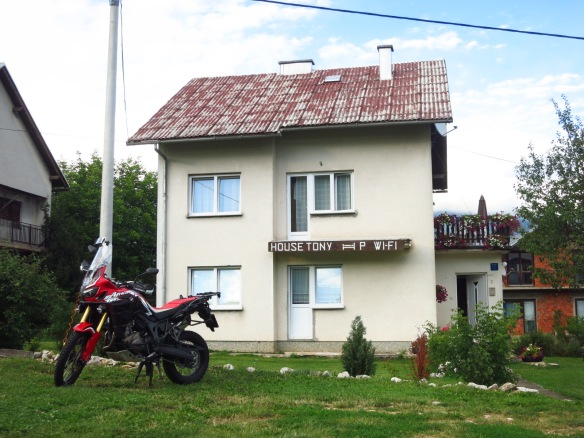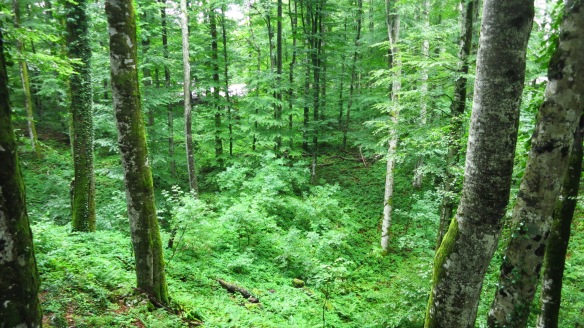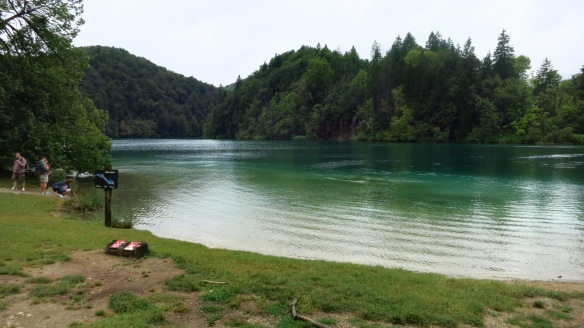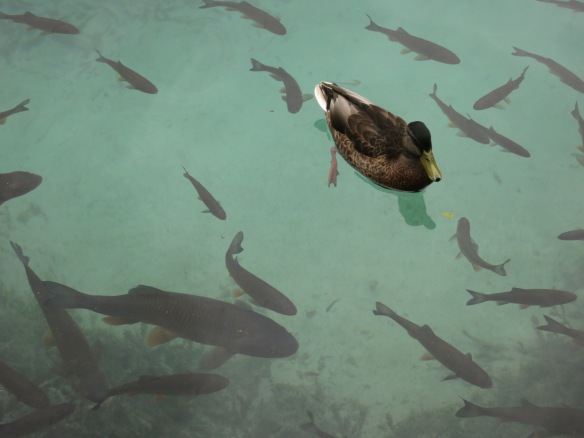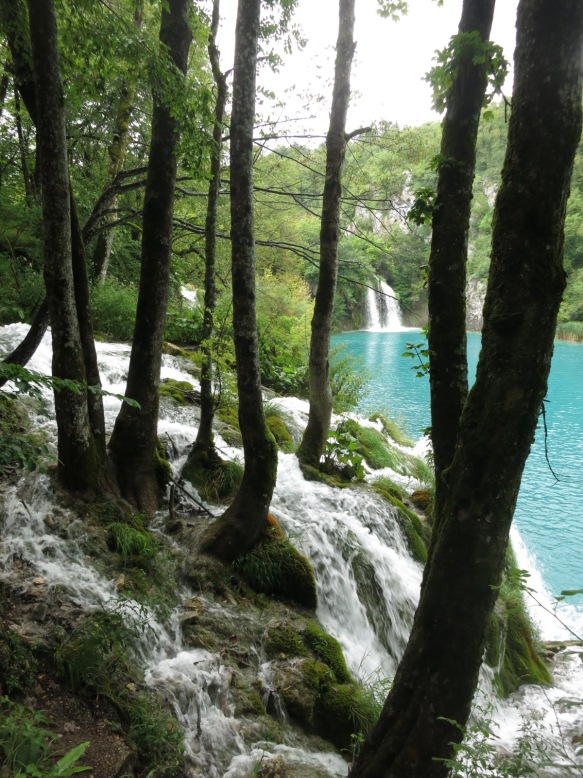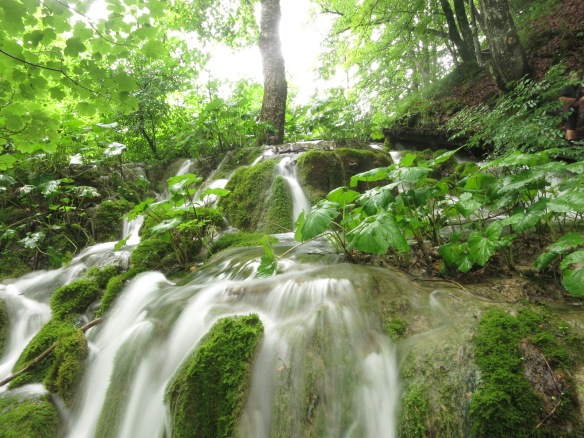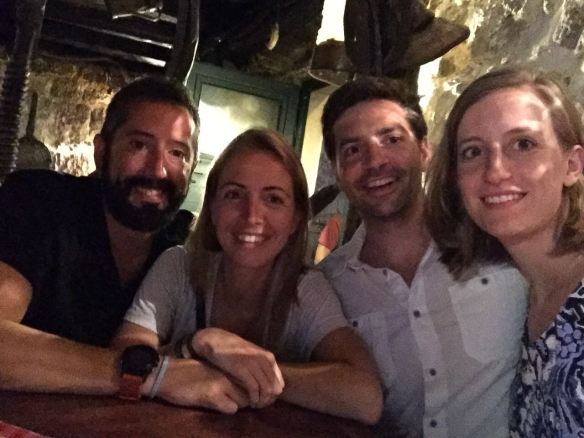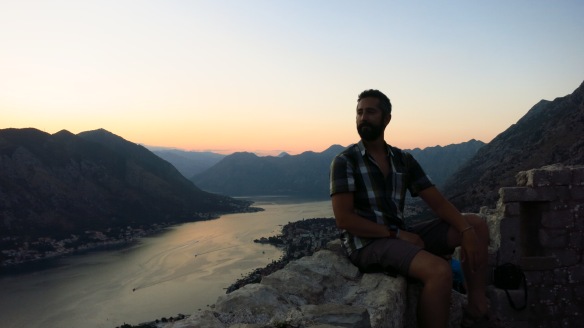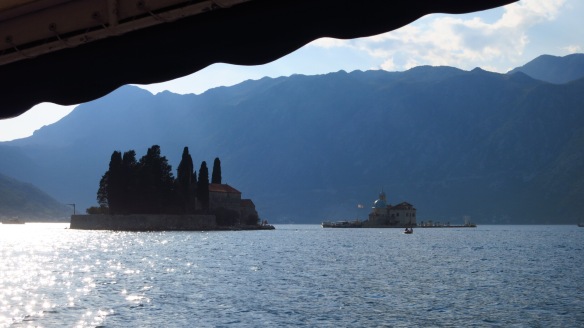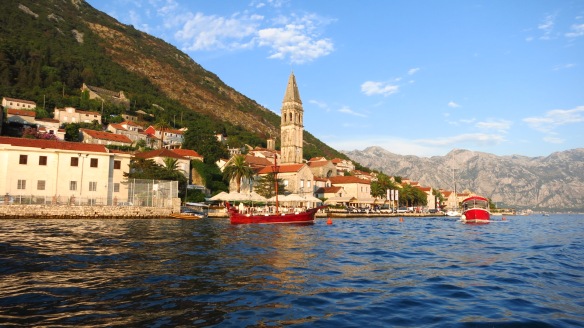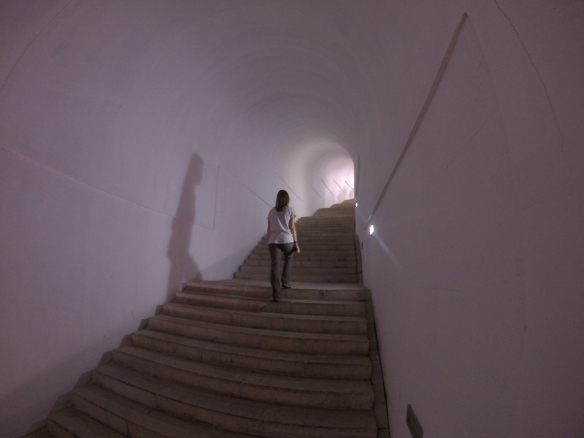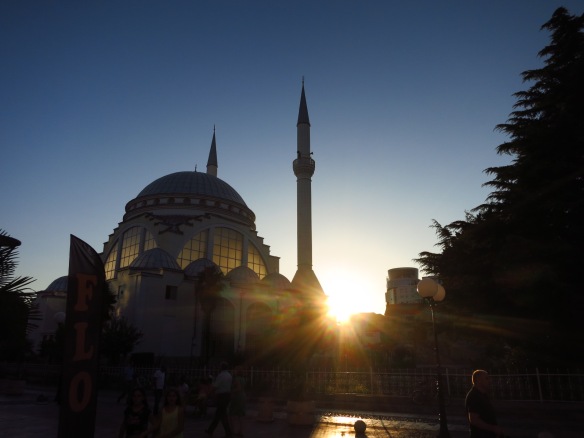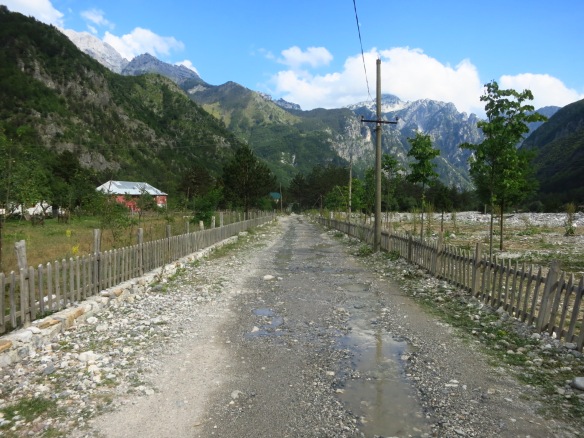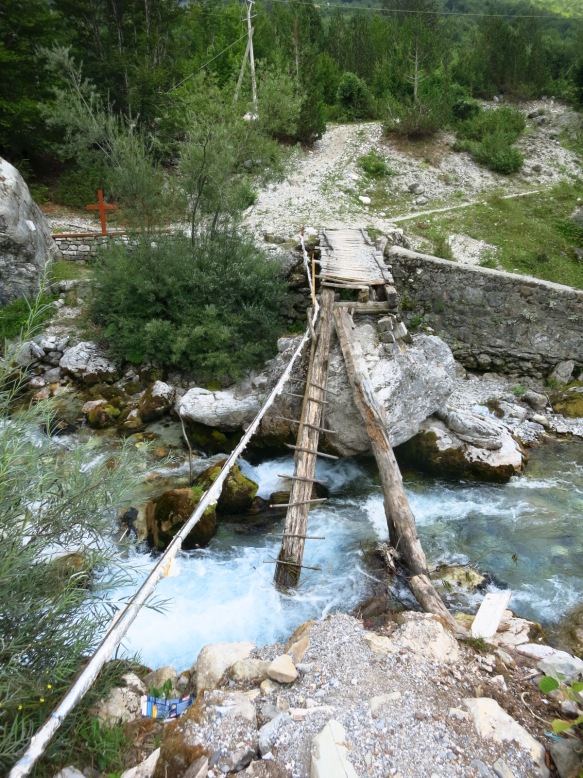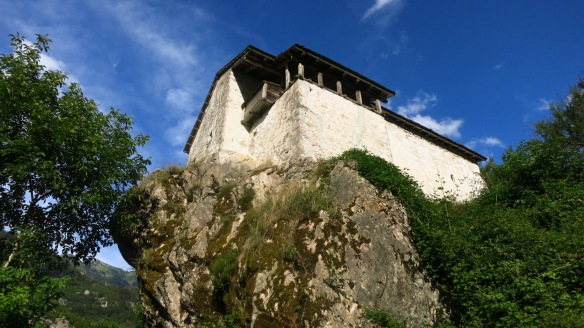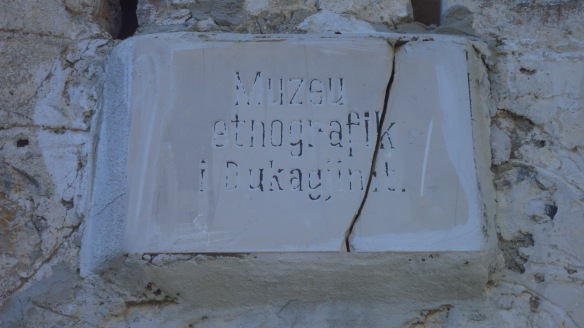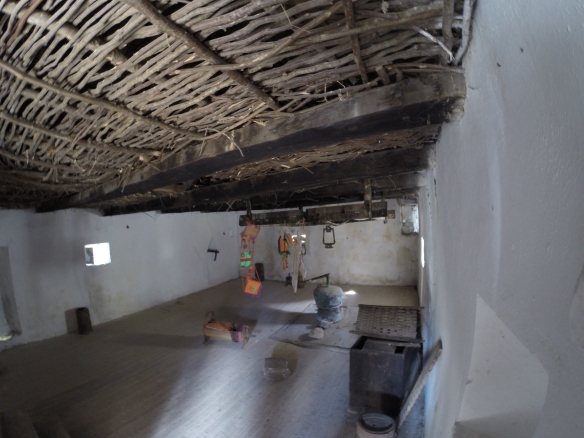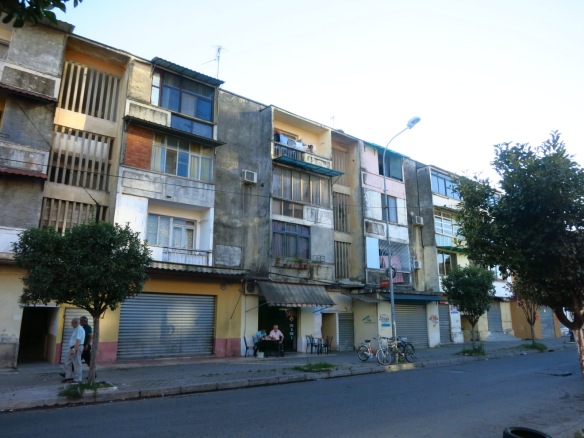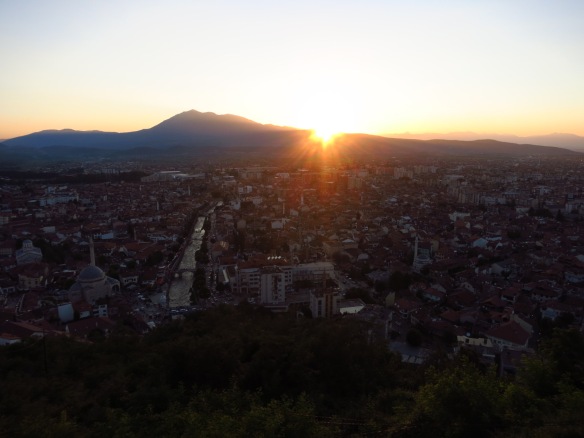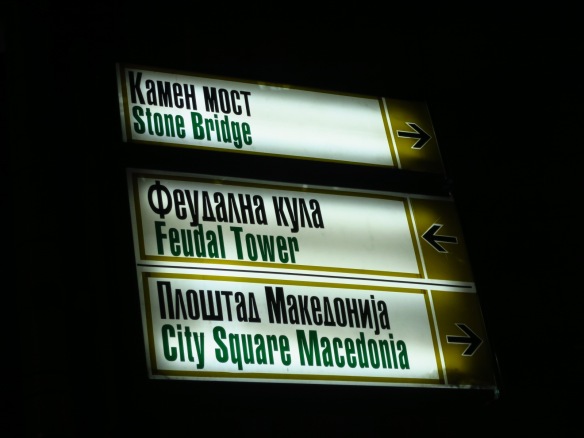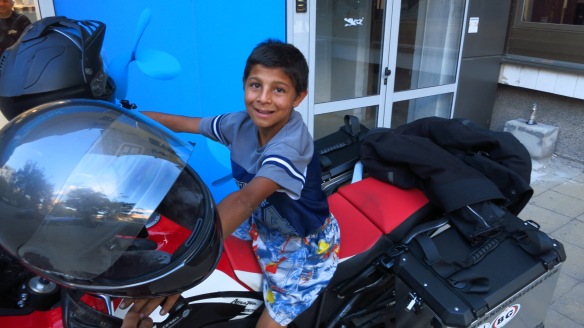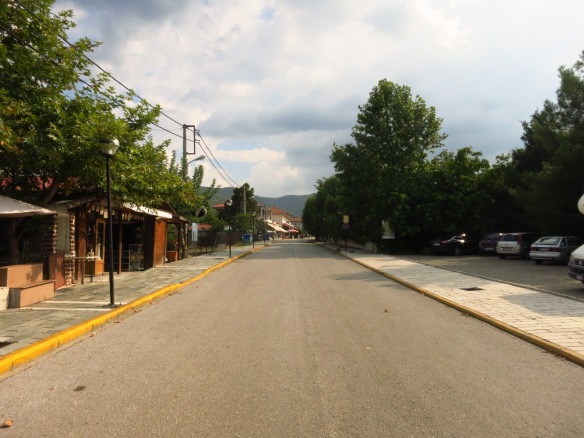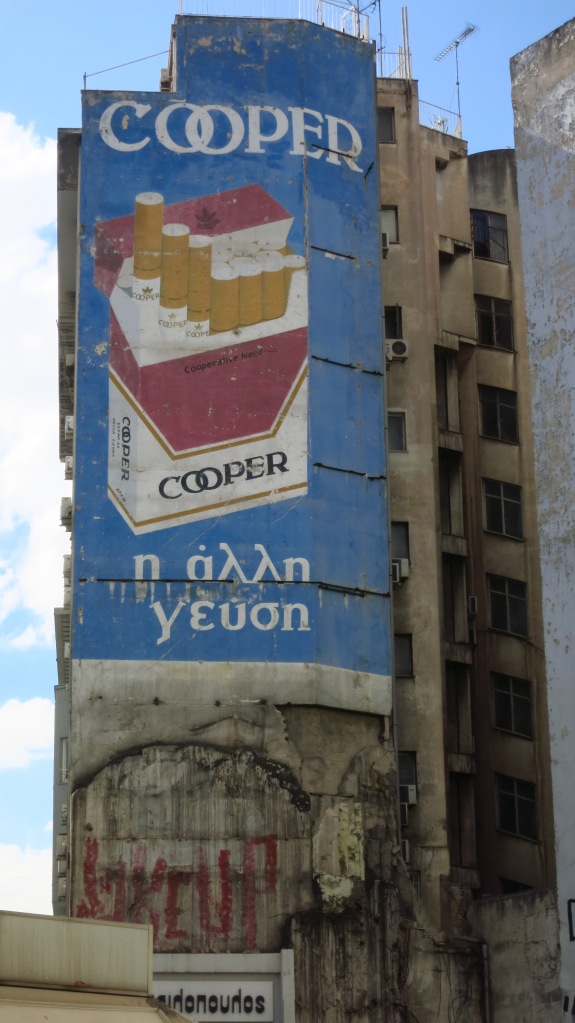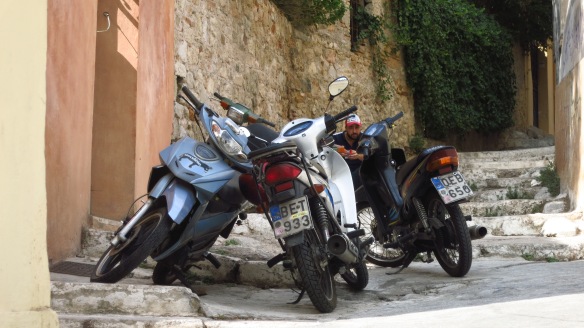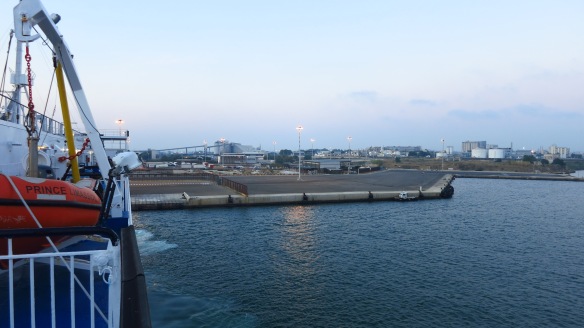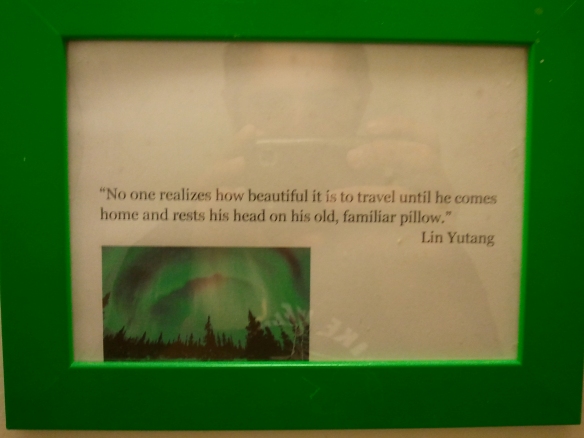Boarding
Day 1 – Friday 29th July – Ferry from Barcelona to Civitavecchia (0km)
I had had the new bike for more than three months; it had dutifully fulfilled its role as my daily transport to and from work and had had its occasional outing at the weekend, but day after day I had been feeling that it needed, longed for a proper trip, the beast wanted to be unleashed away from the city. So when the holiday have finally came, it was time to take it on its first long trip. Where? The Balkans.
The plan was to take a ferry to Italy, cross the country, take another ferry and start from Croatia, then ride south to Montenegro, Albania, Kosovo, Macedonia, Bulgaria, Greece and back to Italy via another ferry.
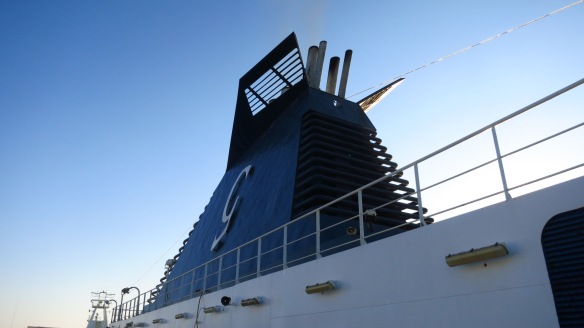 I started my holidays at the very end of July. This had an instant impact on the beginning of my holidays in two notable ways.
I started my holidays at the very end of July. This had an instant impact on the beginning of my holidays in two notable ways.
One, I got a reminder of how hot and damp the city is this time of year as I dragged about 40kg of luggage from my flat to the garage where the bike sleeps, one piece at a time. After a lot of sweating, pulling straps and tying knots, the game of Tetris was complete and the bike loaded.
Second, I got a taste of the joys of starting my holiday at the same time as millions of other people in the shape of a neverending queue at the ferry terminal.
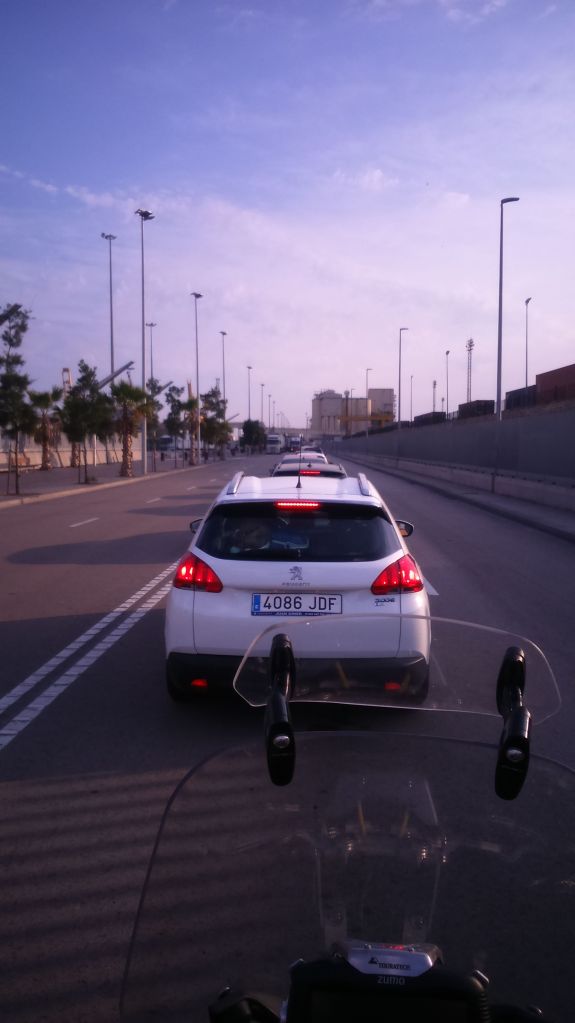 Once on board, the ferry was choke full of loud people, screaming kids and dodgy-looking Eastern European truck driveres, one of whom tried to start a fight at the top deck bar. At least the two-hour delay before we set sail was made much more enjoyable by the company of an Argentinian couple who have been travelling around the world on their motorbike for over two years, and who had a lot of stories to share. You can find out more about them here and here.
Once on board, the ferry was choke full of loud people, screaming kids and dodgy-looking Eastern European truck driveres, one of whom tried to start a fight at the top deck bar. At least the two-hour delay before we set sail was made much more enjoyable by the company of an Argentinian couple who have been travelling around the world on their motorbike for over two years, and who had a lot of stories to share. You can find out more about them here and here.
Across the Mediterranean
Day 2 – Saturday 30th July – More ferry and Civitavecchia to Terni (113km)
Grimaldi Ferries could be considered the Ryanair of the Mediterranean – the cheapest way to get yourself and your vehicle to your holiday destination from Barcelona, and it shows. You get what you pay for, and the advantage of this is that if what you want to pay for are your holidays on the Balkans and not a cabin on a cruise across the Med, you can board with a deck ticket and just find a quiet spot to lay down your camping matress to spend the night and no one will look at you twice. Everybody does it. So we found ourselves a “luxury” corner (one with a power outlet) and settled down for the night.
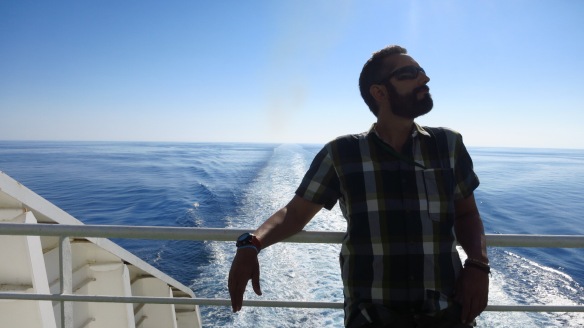 The following day was a lot quieter than first impressions had led me to expect, and time was mostly spent writing this blog, playing cards and reading between the top deck and a small deserted shaded side deck two levels down with a nice sea breeze. The journey felt a lot shorter than it really was, and despite the initial two-hour delay, we were in Civitavecchia at about 19:30.
The following day was a lot quieter than first impressions had led me to expect, and time was mostly spent writing this blog, playing cards and reading between the top deck and a small deserted shaded side deck two levels down with a nice sea breeze. The journey felt a lot shorter than it really was, and despite the initial two-hour delay, we were in Civitavecchia at about 19:30.
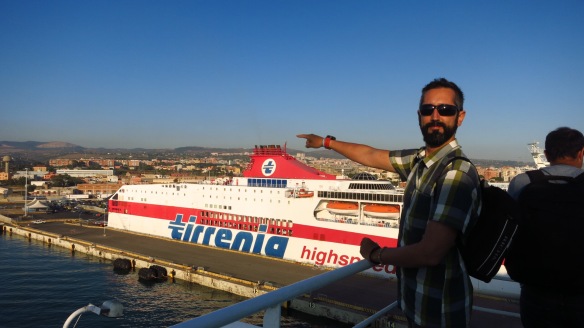 We had a bit over 100km to get to Terni, a town more or less halfway across Italy where we were going to spend the night, and Italy welcomed us with a great country road gently sweeping across fields and low hills with the sun glowing red as it set in the background.
We had a bit over 100km to get to Terni, a town more or less halfway across Italy where we were going to spend the night, and Italy welcomed us with a great country road gently sweeping across fields and low hills with the sun glowing red as it set in the background.
Porn vending machines
Day 3 – Sunday 31st July – From Terni to Ancona; ferry to Zadar; from Zadar to Korenica (311km)
Not so long ago I read an article entitled My 25,000 Wonders Of The World. The title mocked the Rough Guide 25 Wonders Of The World, and its writer started it describing a trip she had made to see the sunset in Ayers rock, Australia. After a very long journey, the 10-minute experience left her distinctly unimpressed and with a feeling that they had gone there just to tick an item of the must-see list that all tourist seem to carry with us. Some time later she decided to forego a visit to the Great Reef Barrier because she preferred to spend some time chilling and enjoying a beer at a beach bar, and after an initial feeling of guilt for having travelled so far and not seen the natural wonder that soon passed, she came to the conclussion that if she were to write a book about her own wonders of the World, it would contain 25,000 ones, rather than 25. The reason was, she explained, that what makes a trip special, what she really remembers afterwards, are the small details and experiences that catch our imagination and give each country its own distinct personality, like the fact that Australian bills are made of plastic, so one can spend all day surfing and then pull a few out your pocket and buy a cool beer at the beach bar.
We set off early, at 7:00, because according to our tickets we had to be at the ferry terminal at 9:30, a full three hours before departure time. I had filled up the bike’s tank in Barcelona hoping to make it from coast to coast in Italy and refuel in Croatia, where petrol is not as expensive as on this side of the Adriatic, but I did not foresee the long departure queues nor the fast ride the previous night to make it on time to the hotel, so we had to make a fuel stop before we reached Ancona. It was here where I found one of the ‘wonders’ I would include in a book: a vending machine that sold porn DVDs. Like tobacco vending machines, you had to show a piece of ID in the shop to have it activated, and standing there against the wall of a desert petrol station early in the morning it sang a sad ode to the loneliness of long distance truck drivers.
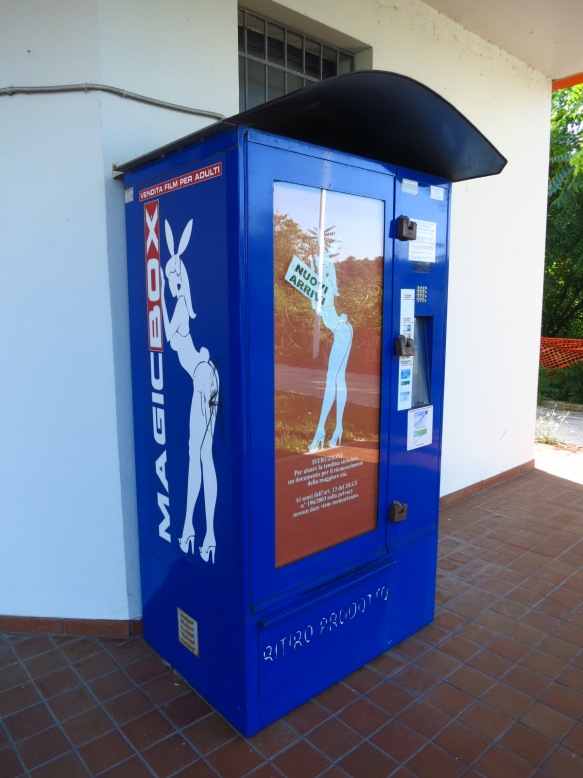 The landscape on most of the journey from Terni to Ancona was surprisingly hilly, and with few traffic the ride was enjoyable and relatively quiet, we only saw three or four Italian drivers overtaking slow cars on double solid lines. We did too, you know – ‘when in Rome do as Romans do’ seemed a particularly well suited saying.
The landscape on most of the journey from Terni to Ancona was surprisingly hilly, and with few traffic the ride was enjoyable and relatively quiet, we only saw three or four Italian drivers overtaking slow cars on double solid lines. We did too, you know – ‘when in Rome do as Romans do’ seemed a particularly well suited saying.
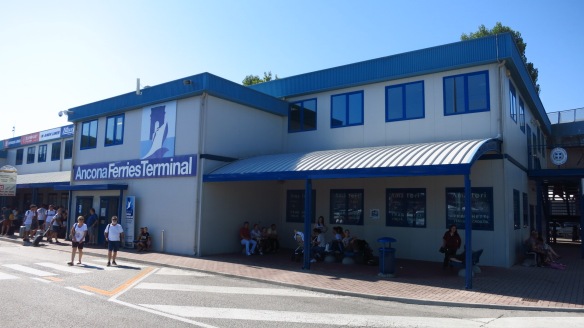 Getting to Ancona early paid off, and we got our tickets and changed some money with no queueing at all, a blessing considering how hot it was. There was no queue to get the bike on the ferry either, and we boarded with a bunch of people who were, ahem, curiously equipped for the crossing.
Getting to Ancona early paid off, and we got our tickets and changed some money with no queueing at all, a blessing considering how hot it was. There was no queue to get the bike on the ferry either, and we boarded with a bunch of people who were, ahem, curiously equipped for the crossing.

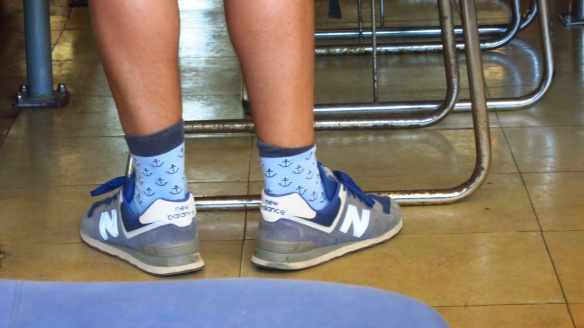 We found a nice table by a window, in a deck with air conditioning, and got ready for what seemed to be a quiet crossing, with the ship far from full. No sooner had I had had thought than my peace and quiet were shattered. By whom, this time? You might ask. Wailing babies? Drunken truck drivers? Hordes of overexcited teens? Nope. A group Italian Evangelists.
We found a nice table by a window, in a deck with air conditioning, and got ready for what seemed to be a quiet crossing, with the ship far from full. No sooner had I had had thought than my peace and quiet were shattered. By whom, this time? You might ask. Wailing babies? Drunken truck drivers? Hordes of overexcited teens? Nope. A group Italian Evangelists.
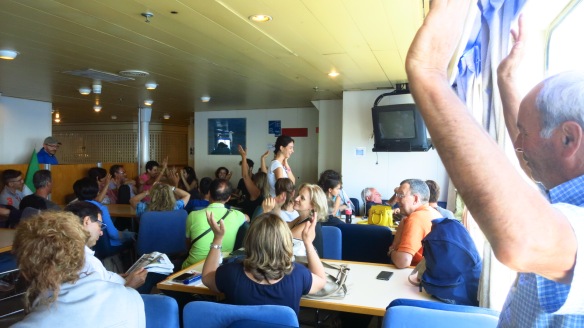 They started pouring into the dining area where we were sitting and soon we were surrendered and with no possible way out, as we were in the oposite corner to the exit. We had just started having lunch, and to our dismay a guitar and a pair of bongos were summoned out of thin air and they started singing, raising their hands, shaking their heads and generally praising the Lord rather loudly. As soon as we had finished eating we waded our way through them mumbling a few ‘scusi’ and went for a coffee somewhere quieter. As they say: ‘Religion is like a penis. It is perfectly OK to have one and be proud of it, but please don’t flaunt it about in public.’
They started pouring into the dining area where we were sitting and soon we were surrendered and with no possible way out, as we were in the oposite corner to the exit. We had just started having lunch, and to our dismay a guitar and a pair of bongos were summoned out of thin air and they started singing, raising their hands, shaking their heads and generally praising the Lord rather loudly. As soon as we had finished eating we waded our way through them mumbling a few ‘scusi’ and went for a coffee somewhere quieter. As they say: ‘Religion is like a penis. It is perfectly OK to have one and be proud of it, but please don’t flaunt it about in public.’
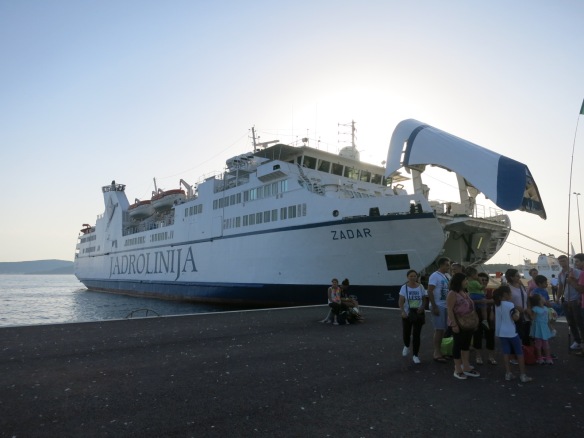 We got to Zadar right on time, and at about 19:00 I hit Croatian roads for the third time in my life. The road network seemed to improve with each visit, and it did not take us long to reach our destination in Korenica, but one thing that had not changed was the heat – it was well over 30ºC even this late in the evening. Fortunately, Korenica is in the mountains, at about 700m above sea level, and the temperature was a lot more bearable.
We got to Zadar right on time, and at about 19:00 I hit Croatian roads for the third time in my life. The road network seemed to improve with each visit, and it did not take us long to reach our destination in Korenica, but one thing that had not changed was the heat – it was well over 30ºC even this late in the evening. Fortunately, Korenica is in the mountains, at about 700m above sea level, and the temperature was a lot more bearable.
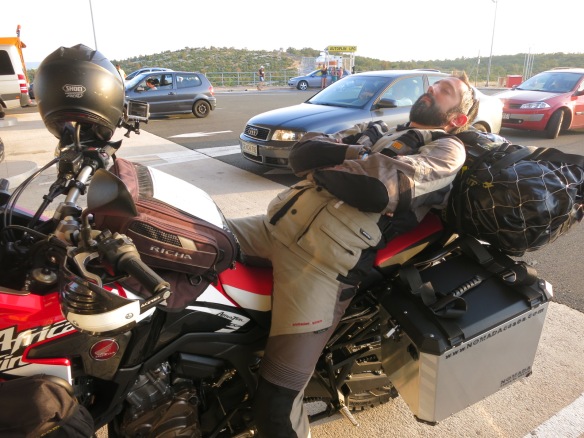 Our accommodation for the next couple of days was a small three-room guesthouse, House Tony, where Marine, hour host, welcomed us with a couple of beers and a plate of chocolate cookies.
Our accommodation for the next couple of days was a small three-room guesthouse, House Tony, where Marine, hour host, welcomed us with a couple of beers and a plate of chocolate cookies.
Plitvice lakes
Day 4 – Monday 1st August – Bus to Korenica to Plitvice to Korenica (0km)
Through my earplugs, I heard the distant ring of the alarm clock going off in both of our mobile phones at 7:00, then Nat switched them off (yes, both of them) and there was silence again. She did not try to wake me up and I, tired as I was from two days of travel, was not particularly interested in finding out why. An hour later I woke up, pulled one of the plugs out of my ear and immediately hear rumbling thunder. I turned to Nat and asked ‘seriously?’ Two days travelling at well over 30ºC and today, the day we were going to go hiking to one of the most famous tourist attractions in Croatia, it was raining? No doubt, that was God getting back at me for having mocked his Italian Evangelists…
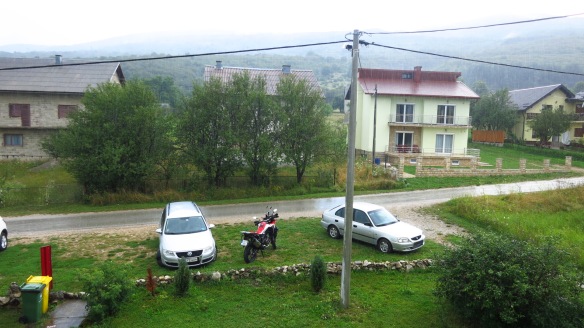 We waited for a while, but the sky did not give us any hope of the weather improving soon. It was covered in menacing looking clouds, and there were bursts of hard rain every few minutes. There was not much to do, so we decided to go to the supermarket to do the shopping and kill some time. On the way there we saw a tourist information stall and asked about the natural park to see whether we would have enough time to see it the following morning before heading to Omiš in the afternoon.
We waited for a while, but the sky did not give us any hope of the weather improving soon. It was covered in menacing looking clouds, and there were bursts of hard rain every few minutes. There was not much to do, so we decided to go to the supermarket to do the shopping and kill some time. On the way there we saw a tourist information stall and asked about the natural park to see whether we would have enough time to see it the following morning before heading to Omiš in the afternoon.
The girl told us that there were trains and boats if we did not want to walk, and the map also showed some cafés and restaurants were we could take shelter from the rain. Not wanting to pass the oportunity to visit the park and seeing that there was a bus leaving in about 5 minutes, we decided to risk it and go right there right then, without going back to the apartment. Fortunately we had taken jackets, the camera, the passports and some money with us.
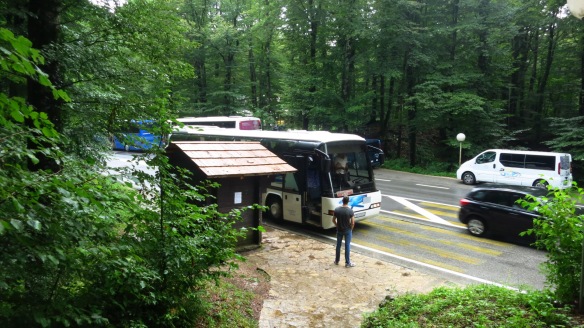 It was still cloudy, but the rain had stopped when the bus dropped us at the park’s entrance. We studied the map and decided to take a boat across the central lake and hike to the main tourist attraction – the big waterfall. It started raining again when we got off the boat, but as luck would have it, there was a small souvenir shop where I could get a raincoat to prevent the rain from stopping us now that it had become clear that the park was defintely fighting the elements for.
It was still cloudy, but the rain had stopped when the bus dropped us at the park’s entrance. We studied the map and decided to take a boat across the central lake and hike to the main tourist attraction – the big waterfall. It started raining again when we got off the boat, but as luck would have it, there was a small souvenir shop where I could get a raincoat to prevent the rain from stopping us now that it had become clear that the park was defintely fighting the elements for.
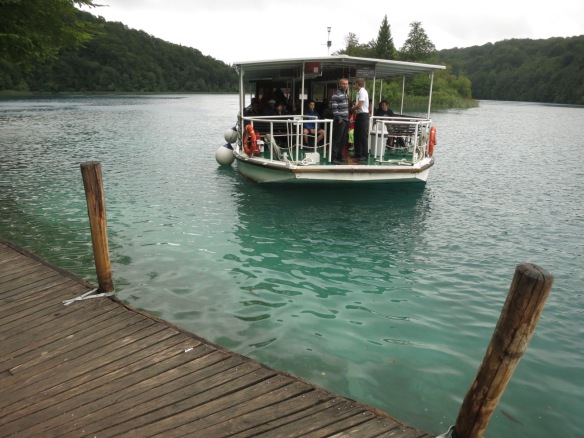 One of the oldest natural parks in Europe, Plitvice consists of 16 lakes and countless waterfalls that connect them. It may take up to 8 hours to visit it all on foot, more than that if you want to explore the whole network of footpaths and hiking routes in and around the park. While most people come to Croatia for its beaches, this area of outstanding natural beauty, one of UNESCO’s World Heritage sites is an absolute must.
One of the oldest natural parks in Europe, Plitvice consists of 16 lakes and countless waterfalls that connect them. It may take up to 8 hours to visit it all on foot, more than that if you want to explore the whole network of footpaths and hiking routes in and around the park. While most people come to Croatia for its beaches, this area of outstanding natural beauty, one of UNESCO’s World Heritage sites is an absolute must.
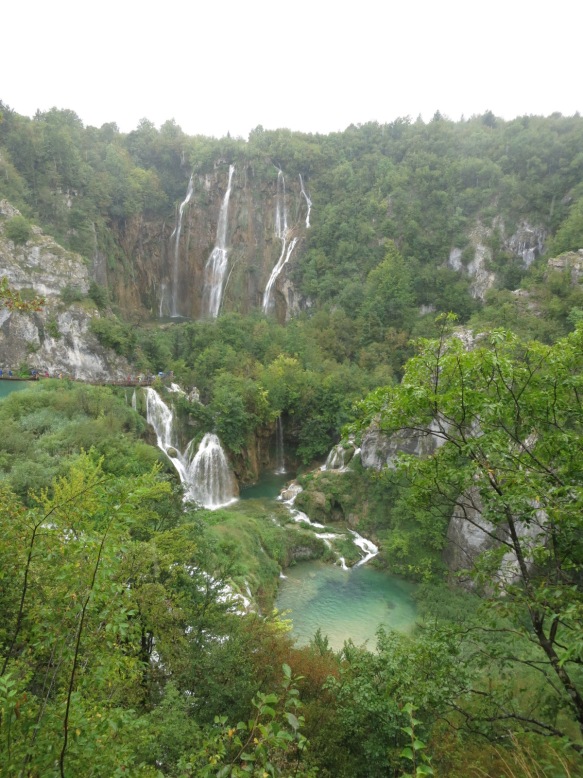 After seeing the big waterfall we hiked back to the entrance in the pouring rain and took shelter at a café, where we had some lunch. Not wanting to finish our visit just yet, we took the train to the other end of the park to see the upper lakes and hike back .
After seeing the big waterfall we hiked back to the entrance in the pouring rain and took shelter at a café, where we had some lunch. Not wanting to finish our visit just yet, we took the train to the other end of the park to see the upper lakes and hike back .
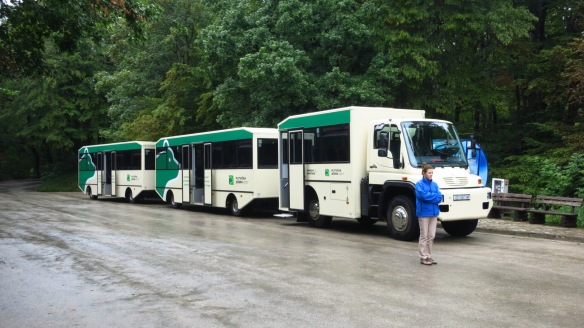 It was definitely worth it, and we were rewarded with a break in the weather and fewer tourists than on the big waterfall. My very limited talent at writing would not do it justice, so here are a few pictures. You can find a lot more on Facebook.
It was definitely worth it, and we were rewarded with a break in the weather and fewer tourists than on the big waterfall. My very limited talent at writing would not do it justice, so here are a few pictures. You can find a lot more on Facebook.
Objekat 505
Day 5 – Tuesday 2nd August – From Korenica to Omiš (325km)
When travelling, talk to the locals, always talk to the locals. They are a source of information a thousand times more valuable than any published guide or regular travel website if you want to discover interesting things.
There are is no local bus connecting Korenica to Plitvice natural park, so to get back home at the end of the previous day visit we had wait at the bus stop outside the park for one of the regular line coaches that go from Zagreb to Zadar or Split and hope that there were free seats, which did not seem very likely in view of how many Japanese tourists and backpackers were also waiting with a booked seat. When the coach arrived it was full, but fortunately, even though Croatia had been a EU member for about three years, the health and safety obsession that seems prevalent in most member countries had not yet made it into people’s lives here, so we were just told that we would have to stand on the aisle. A Japanese tourist got off at the first stop, freeing up a seat for Nat, and then a local guy who was seating at the front, in the guide’s jumpseat, chatting to the bus driver, invited me to seat with them.
We quickly got talking about motorbikes and places to visit in the region, and then he pointed out the left side windows at a mountain with some antennas on top and told me that it was Plješevica Mountain, the tallest in the region. Then, in a more hushed tone, he said that hidden behind the mountain there was a ‘secret airport’. On the map of the natural park and its surrounding that we had been given earlier I had seen a couple of long straight lines that looked like runways and that the border line between Croatia and Bosnia, which generally followed the watershed line along the mountins, turned into the Bosnian side to encompass them in Croatian territory, but there were no labels indicating that it was an airport or that it was in use. Needless to say, my curiosity was piqued, but before I could ask for more information his mobile phone rang and he got engaged in a conversation that was still going on when we reached our stop.
Back at the apartment I checked Google Maps, but there was nothing there other than a couple of small villages off the road crossing into Bosnia. Switching to satellite view, however, revealed a sort of access road from one of the villages and what seemed to be at least five runways.

 The OSM map on my Garmin confirmed this, and by now I was determined to go and find out what it was. Googling the name of the mountain, I finally found some more information.
The OSM map on my Garmin confirmed this, and by now I was determined to go and find out what it was. Googling the name of the mountain, I finally found some more information.
It was not an abandoned airport, but a military base, called Željava Air Base and codenamend ‘Objekat 505’, built between 1948 and 1968 as an early warning radar system for the former Yugoslavia, with a radar station at the top of Plješevica Mountain and an airbase buried deep at the base of the mountain that housed Mig fighter jets inside nuclear bomb-proof facilities. The base saw heavy use during the Balkan War, and when the Yugoslav People’s Army fled the area, they destroyed the runway and the tunnel complex with tonnes of explosives. Today the base is completely abandoned and easily accessible from the nearby village of Željava.
‘Easily accessible’ does not imply that it is safe nor advisable to do so. Being a military facility, the area was heavily mined, and those mines have still not been cleared today. Inside, the structure was heavily damaged by the detonation of more than 56 tonnes of explosives, and there are large amounts of cancirogenig PCB dust and radioactive americum from the destroyed fire detection system. Right, so the only thing left to do was explain to Nat that we were going to be a few hours late to the beach in Omiš. And not mention the landmines.
 Thanks to the OSM maps we found our way to the town of Željava very easily after a nice ride to the other side of the mountaing range, and from there a narrow road that the vegetation on both sides was eating up led to a rusting gate that marked the entrance to the complex. Next to it, the first surprise of the visit, standing in the overgrown bushes – a DC3.
Thanks to the OSM maps we found our way to the town of Željava very easily after a nice ride to the other side of the mountaing range, and from there a narrow road that the vegetation on both sides was eating up led to a rusting gate that marked the entrance to the complex. Next to it, the first surprise of the visit, standing in the overgrown bushes – a DC3.
 We got off the bike and I told Nat not to walk outside the paved areas or paths that had been clearly trodden before because there were mines everywhere. She gave me her worst ‘divorce’ look.
We got off the bike and I told Nat not to walk outside the paved areas or paths that had been clearly trodden before because there were mines everywhere. She gave me her worst ‘divorce’ look.
 Riding on past the gate and with more bushes and trees closing on the road, we reached the intersection of the three main runways, and to our right, the entrances to the underground complex.
Riding on past the gate and with more bushes and trees closing on the road, we reached the intersection of the three main runways, and to our right, the entrances to the underground complex.



 The central one was specifically designed for fighter jets, and on the other two the damage from the explosions was clearly visible, with huge chunks of thick reinforced concrete hanging from the arched ceiling and part of the enormous concrete and steel pressure doors lying on the ground.
The central one was specifically designed for fighter jets, and on the other two the damage from the explosions was clearly visible, with huge chunks of thick reinforced concrete hanging from the arched ceiling and part of the enormous concrete and steel pressure doors lying on the ground.

 I had a powerful torch with me and started to wander down the tunnel, but the air was rarified, and a picture with flash revealed the amount of dust in suspension in there, so I did not want to venture any further in without wearing a mask. We’ll have to come back someday before the EU hears about the place and orders it shut.
I had a powerful torch with me and started to wander down the tunnel, but the air was rarified, and a picture with flash revealed the amount of dust in suspension in there, so I did not want to venture any further in without wearing a mask. We’ll have to come back someday before the EU hears about the place and orders it shut.
 We then rode on a fourth runway that cut across the border between Croatia and Bosnia. Halfway through it there were some concrete blocks that prevented us from riding any further and signs on both sides forbidding the crossing, but there was no surveillance. Here we are one on each side of the border, Nat in the EU and me outside of it.
We then rode on a fourth runway that cut across the border between Croatia and Bosnia. Halfway through it there were some concrete blocks that prevented us from riding any further and signs on both sides forbidding the crossing, but there was no surveillance. Here we are one on each side of the border, Nat in the EU and me outside of it.


 After that we made a full power run of the main runway on the motorbike (who wouldn’t!) and happy not to have been blown to oblivion by some forgotten landmine, we headed back to Korenica and the road south to Omiš.
After that we made a full power run of the main runway on the motorbike (who wouldn’t!) and happy not to have been blown to oblivion by some forgotten landmine, we headed back to Korenica and the road south to Omiš.
 Since my first visit to Croatia, the motorway that crosses the country roughly following the coast has practically been completed, taking most traffic away from the B roads that used to be the only way of getting around the country. This meant that roads that were previously hell to travel in (hours stuck behind lorries and slow moving traffic) were now gloriously empty. If you come to Croatia by bike, stay away from the motorway, the roads and the landscape in the interior are a gem.
Since my first visit to Croatia, the motorway that crosses the country roughly following the coast has practically been completed, taking most traffic away from the B roads that used to be the only way of getting around the country. This meant that roads that were previously hell to travel in (hours stuck behind lorries and slow moving traffic) were now gloriously empty. If you come to Croatia by bike, stay away from the motorway, the roads and the landscape in the interior are a gem.
 We got to Omiš by mid afternoon in 35-degree heat and were delighted to find that the woman we were renting the apartment form greeted us with a couple of chilled beers. I love this Croatian custom!
We got to Omiš by mid afternoon in 35-degree heat and were delighted to find that the woman we were renting the apartment form greeted us with a couple of chilled beers. I love this Croatian custom!
After unloading the bike and a cold shower, we changed clothes and took a walk to the centre to start our four-day beach break with a huge fish platter.
Omiš
Days 6 to 8 – Wednesday 3rd to Friday 5th August (0km)
After a hard year of work, one of the things we wanted to do this summer was relax a bit. Adventure holidays are fine, and we would have plenty of that in the coming days, but first a few days to unwind on the beach would be more than welcome, and Omiš was the perfect place for that.
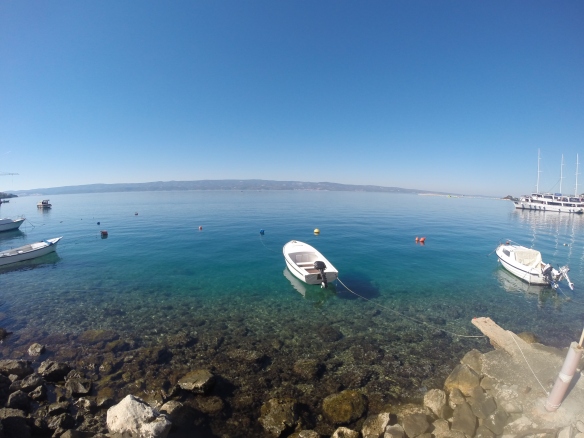 Omiš lies at the mouth of the Cetina river, and its unique location, hidden from the open sea by the island of Brac and with the deep canyon of the river behind, made it a perfect hiding place for pirate.
Omiš lies at the mouth of the Cetina river, and its unique location, hidden from the open sea by the island of Brac and with the deep canyon of the river behind, made it a perfect hiding place for pirate.
Most people who visit Croatia go to Dubrovnik or the many islands that the country has, so the stunning pebble beaches in Omiš are rather quiet, with mostly Croatian holidaymakers and a few Hungarians, Austrians and Poles. You can enjoy an excellent fish or seafood dinner in the center at a very reasonable price and accommodation is also cheap.
We got an apartment across the road from the beach and then found a small secluded beach on the other side of the river mouth, just outside the city, with crystal clear water and shade from the trees right on the shore. Because there was barely any sand there, the place was also mostly blessedly kid-free, so it was really quiet. Perfect for a bit of swimming, reading and relaxing.
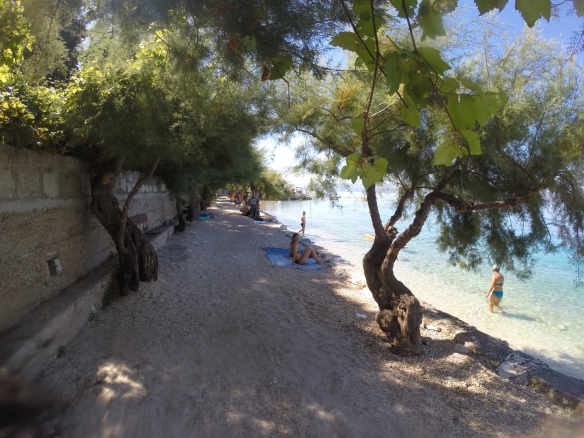 With our beach half an hour on foot from the apartment and the city center even closer than that, the bike spent all our time here safely chained under a tree in the garden, all the best taking into account how bad traffic is. If you decide to visit Omiš, come here by bike or of you do it by car, get an apartment that is within walking distance from the beaches and the center, or you’ll go crazy. The coast road cuts through the center, and there is only one narrow bridge to cross the Cetina river with jwo junctions on either side of it leading to two roads going into the canyon along the river, and with high hills right behind the town, there is no room to build a bypass. This means that traffic crawls so slowly through the city that it is actually faster to cross it on foot.
With our beach half an hour on foot from the apartment and the city center even closer than that, the bike spent all our time here safely chained under a tree in the garden, all the best taking into account how bad traffic is. If you decide to visit Omiš, come here by bike or of you do it by car, get an apartment that is within walking distance from the beaches and the center, or you’ll go crazy. The coast road cuts through the center, and there is only one narrow bridge to cross the Cetina river with jwo junctions on either side of it leading to two roads going into the canyon along the river, and with high hills right behind the town, there is no room to build a bypass. This means that traffic crawls so slowly through the city that it is actually faster to cross it on foot.
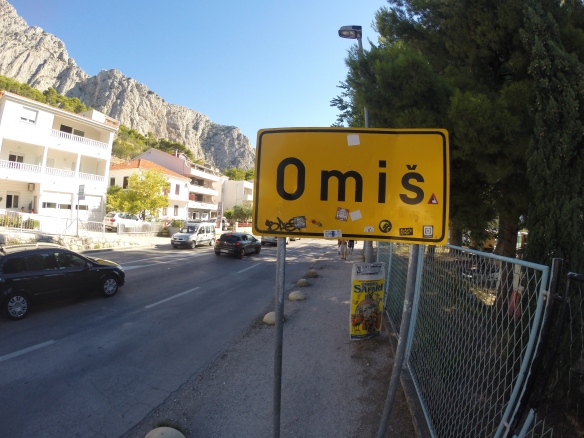 On the last night we had dinner with some good friends who live in London and who were also on holiday in Croatia, Josep and Mona. He had seen on the blog that we were around here, and they were on their way to Split to take a plane back home on Saturday, so they made their last stop in Omiš and we shared a great evening together.
On the last night we had dinner with some good friends who live in London and who were also on holiday in Croatia, Josep and Mona. He had seen on the blog that we were around here, and they were on their way to Split to take a plane back home on Saturday, so they made their last stop in Omiš and we shared a great evening together.
Riding 30km on the wrong side of the road
Day 9 – Saturday 6th August – From Omiš to Dubrovnik (209km)
It was supposed to be an easy ride today, just 209km of nice coast road to be in Dubrovnik by mid morning with plenty of time to make the most of the day and visit the city, but things don’t always turn out as we would like.
The weather forecast announced cloudy skies with a chance of thunderstorms by noon, which I was actually quite happy with, as I did not want to ride in the heat of the last three days, particularly when there was a border to cross where we might be made to wait in the sun. After a stormy night with heavy rain the day started cloudy but dry, and we had the bike ready to go by 9:00 when the owner of the apartment building came to see us off. The previous evening, when we had gone down to his apartment to pay our stay, he had invited us to a glass of a red wine he made himself and he had told us a bit about his life. He had been working in Germany for 30 years, and had built the apartment block with the money he had earned there as an investment for his retirement. He did not speak any English, but he got his story across with what little German I remembered from university. The wine was rather good, and seeing that we liked it, he gave us a bottle as a goodbye present and told us to be ‘very careful with the wind for the first 20km or so’ on the coast road. ‘Langsam, langsam!’
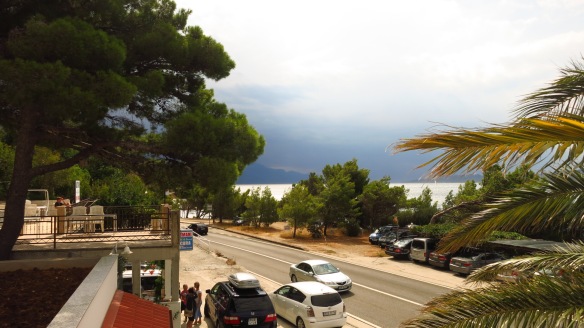 The moment we left Omiš it was clear that his warning was not to be taken lightly. Not since the fist day of my frustrated trip to Mongolia had I experienced such bad winds on the bike. The jagged coast and the winding road meant that the strong winds blowing from the sea buffeted in all directions, making it difficult to predict where the next gust was going to come from, and we had a few heart-stopping moments when a gust caught us from the wrong side while leaning through a tight corner. After only a few kilometres the sky ahead was completely black and we could see bolts of lighting striking the water and the cliffs relentlessly. It really did look like doomsday up ahead. As I was having these thoughts while fighting to keep the bike from being blown onto oncoming traffic or over the armco and into the sea, I felt a not-so-gentle tapping on my helmet – Nat had put her foot down and refused to continue riding in those conditions.
The moment we left Omiš it was clear that his warning was not to be taken lightly. Not since the fist day of my frustrated trip to Mongolia had I experienced such bad winds on the bike. The jagged coast and the winding road meant that the strong winds blowing from the sea buffeted in all directions, making it difficult to predict where the next gust was going to come from, and we had a few heart-stopping moments when a gust caught us from the wrong side while leaning through a tight corner. After only a few kilometres the sky ahead was completely black and we could see bolts of lighting striking the water and the cliffs relentlessly. It really did look like doomsday up ahead. As I was having these thoughts while fighting to keep the bike from being blown onto oncoming traffic or over the armco and into the sea, I felt a not-so-gentle tapping on my helmet – Nat had put her foot down and refused to continue riding in those conditions.
I stopped the bike and by happy coincidence there was a restaurant right across the road where we took shelter from the wind after parking the bike securely to make sure it would not be blown onto its side by the wind. With a cup of coffee and Wi-Fi to check the forecast, we studied our options, which turned out to be rather limited. Nat squarely refused to get on the bike again, so we could not brave it and go on to try to ride through the windy bit and the storm ahead and neither could we go back to Omiš to spend the day there in the hope that the following day conditions would be better. So we sipped our coffee and waited for almost two hours.
When the wind finally died down we rode on until we found the first road inland – we were heading for the motorway and away from the coast road in an attempt to escape the wind.
It worked, there was almost no wind there, but the moment we had collected the ticket from the toll booth and were pulling onto the motorway, the skies opened and the wraith of God fell upon us in the form of a deluge. We stopped at the first service station we found, but our supposedly water proof gear was already soaked halfway through. We spent another two hours there, watching the rain fall and other miserable bikers come and go while we chatted to a Dutch guy who had friends in MotoGP.
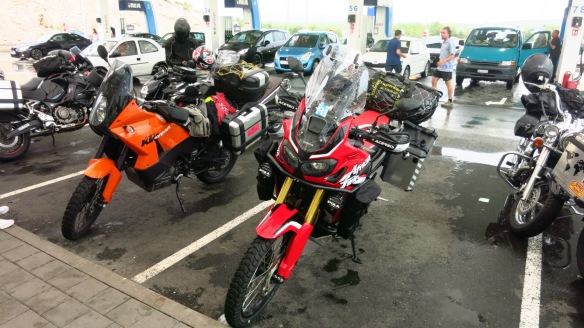 Seeing that thing were not going to change anytime soon, we hit the road again and to our delight conditions improved a bit by the time the motorway ended in Ploče and we started heading down the coast again towards Dubrovnik.
Seeing that thing were not going to change anytime soon, we hit the road again and to our delight conditions improved a bit by the time the motorway ended in Ploče and we started heading down the coast again towards Dubrovnik.
We were more than halfway there, the rain had stopped and the wind too, but it was too soon to claim victory – there was one more obstacle to overcome. The region of Dalmatia, which comprises more than half the total lenght of the Croatian coast and at the southern tip of which Dubrovnik is located, is actually cut in two by a small Bosnian corridor that gives that country access to the Adriatic sea. This means that to get there you have to cross a border into a non-EU country, ride for about 10km and then cross another border back into Croatia. If you think this is a hassle, you are right. Now add to that thought the fact that we kkare talking about a narrow two-way coast road that cuts through all towns and villages and which is the only way to get to southern Dalmatia. In the midst of the high summer season.
Our friend Josep had told us that he had spent three hours to get through the border, but we were not expecting to find traffic completely stopped 20km from the border. O n top of that, it started raining again, so I did not think twice and did the only thing I could do – change onto the opposite lane and ride towards incoming traffic. For 20km I rode on the wrong side of the road, pulling in between stopped cars when something big was coming the other way, like a coach or a lorry (or a police van), and then for 10km more in Bosnia, where the traffic jam continued because there was another border to cross down the road. Had I not done that we might still be waiting there stuck in traffic and soaking through and through.
Just before crossing the border back into Croatia we stopped at a Bosnian petrol station to honour the tradition of getting a country sticker for the bike, which has to start earning them. It was the second this trip, the first one having been obtained in Croatia that morning.
For the last 30km before Dubrovnik both the weather and the traffic finally cleared, even though the strong winds made an unwelcome return. We finally made it to our guesthouse at almost 19:00, got the cases off the bike and went for a night visit of the old town.
King’s Landing
Day 10 – Sunday 7th of August – Dubrovnik (0km)
King’s Landing and also thousands of tourists’ landing, as Dubrovnik is one of the most popular destinations on the Mediterranean area, both for cruise ships and people coming by car, bus, plane and even hitchhiking.
That steady stream of people constitutes the main revenue of the city, which reflects on the prices for accommodation. The cheapest we could find was a room in a house about 20 minutes on foot from the old town, with a shared bathroom and kitchen, which was not bad, but compared to what we had found so far it doubtlessly was the worst value for money. It was only accessible from a pedestrian alley, so the closest I could get the bike was the car park of a shopping centre opposite the house where it spent the night chained to a metal staircase.
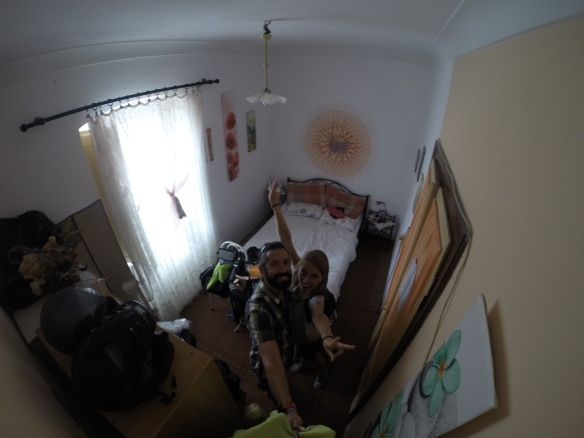 We had considered visiting the island of Mljet, which Josep had highly recommended, but the weather forecast for the day looked grim – strong winds, thunderstorms and showers again, so we decided to stay and visit the city, which was the plan for the previous day if the journey had not taken so long.
We had considered visiting the island of Mljet, which Josep had highly recommended, but the weather forecast for the day looked grim – strong winds, thunderstorms and showers again, so we decided to stay and visit the city, which was the plan for the previous day if the journey had not taken so long.
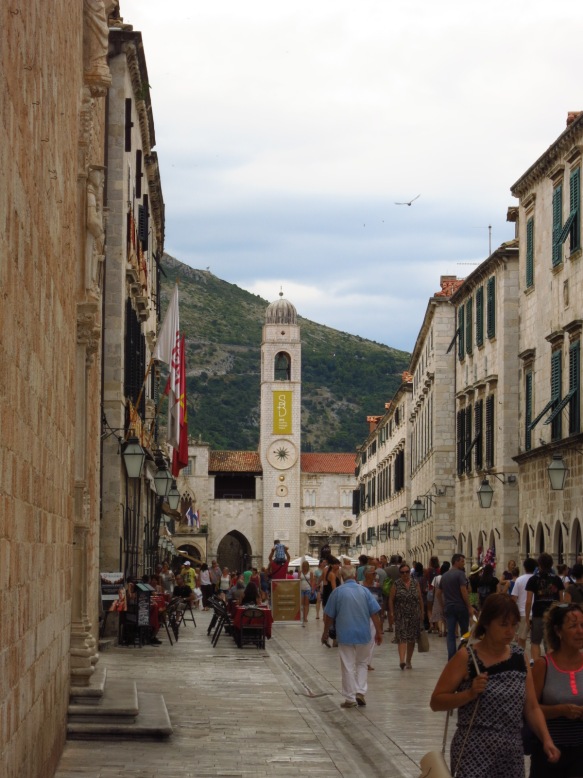 Despite being packed full of people on the summer season, the old town is definitely worth the visit. Surrounded by high and thick stone walls, its streets are a labyrinth of narrow and steep backstreets and alleys where one can easily get lost and find rare corners away from the hustle and bustle of the main streets and wander around without seeing other tourists. It takes time to explore the whole city, even more if you want to take a tour of the walls or visit its many museums.
Despite being packed full of people on the summer season, the old town is definitely worth the visit. Surrounded by high and thick stone walls, its streets are a labyrinth of narrow and steep backstreets and alleys where one can easily get lost and find rare corners away from the hustle and bustle of the main streets and wander around without seeing other tourists. It takes time to explore the whole city, even more if you want to take a tour of the walls or visit its many museums.
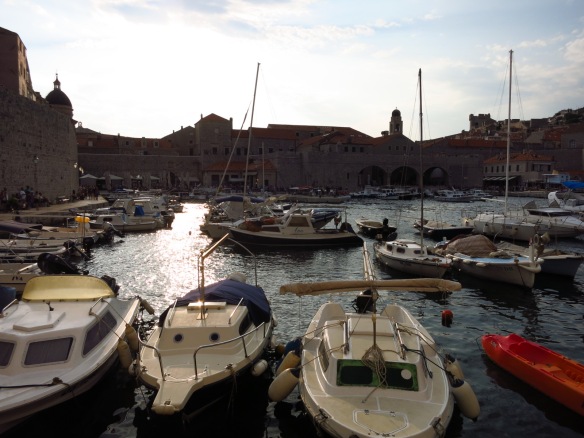 Shortly after crossing the main gate it started to rain, so we followed a French cruise party into what seemed to be a memorial to the citizens that had given their lives defending the city during the war. The girl at the entrance assumed we were part of the group, so we saved a few Kuna that would later be reinvested in a cold beer, and we benefited from the guide’s explanation about how the city had suffered the war.
Shortly after crossing the main gate it started to rain, so we followed a French cruise party into what seemed to be a memorial to the citizens that had given their lives defending the city during the war. The girl at the entrance assumed we were part of the group, so we saved a few Kuna that would later be reinvested in a cold beer, and we benefited from the guide’s explanation about how the city had suffered the war.
The old town has been a UNESCO World Heritage site since 1979, and even though as early as 1970 the whole city was demilitarised so that it would not be target in the event of an armed conflict, in 1991 it was attacked and besieged by the Yugoslavian People’s Army following the declaration of independence of Slovenia and Croatia. At that time the country did not have a regular army, so it was down to the citizens to defend the city for the seven months that the siege lasted, until it was liberated by the newly-founded Croatian Army, created from the police force. The shelling of the city had a devastating effect, and even though most of it has been restored today, it is easy to see the extent of the destruction if you visit the fort that overlooks the city, from where many new roofs can be spotted in the old city.
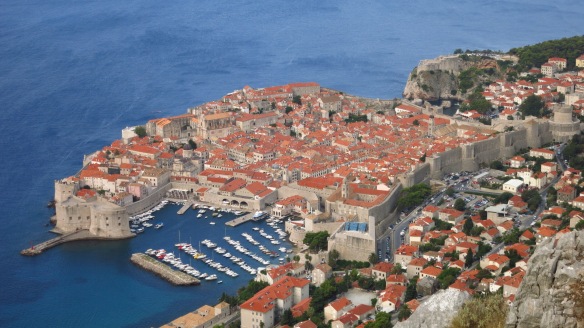 There is plenty to see and do if you have the time and the money – boat trips to the islands, great restaurants, a couple of bars perched on the rocks outside the walls facing the sea, beautiful beaches, night promenades… You can even take a Game Of Thrones tour. No wonder the city attracts so many people these days.
There is plenty to see and do if you have the time and the money – boat trips to the islands, great restaurants, a couple of bars perched on the rocks outside the walls facing the sea, beautiful beaches, night promenades… You can even take a Game Of Thrones tour. No wonder the city attracts so many people these days.
Do not trust first impressions
Day 11 – Monday 8thAugust – From Dubrovnik to Kotor (107,1km)
Today I woke up with the excitement of crossing a border into a country I had never been to before – Montenegro.
We loaded the bike, which as I said on the previous post was parked in the car park of a shopping centre and rode down the ramp that led to the road to find that unlike the weekend, the boom gate was down and there was a guard in the booth. I had seen a sign detailing the prices per hour and more importantly, the price in the event of losing the ticket, and I definitely did not want to pay that so when we saw that the guard was busy with a driver who was paying his stay we seized the chance to slip out through the gap between the boom and wall and zoom down the street without looking back. We’ll be at the border before they realise, kid.
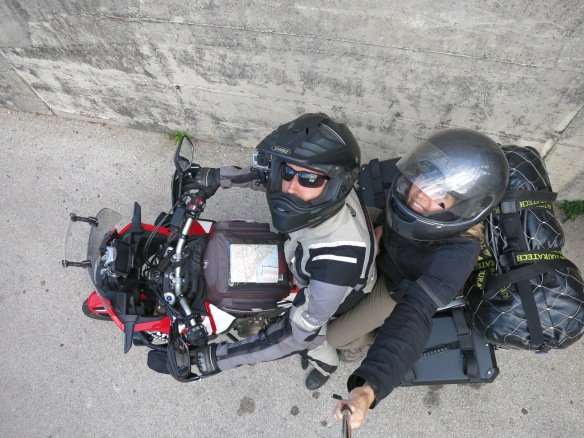 And we were soon indeed at the border after a quick ride up the fort to snap
And we were soon indeed at the border after a quick ride up the fort to snap
a panorama of the city. Anticipating long queues again we had set off early and taken a road south of the main one which followed the coast in order to avoid traffic. We were not sure whether there was a border crossing on that road or not, or if it would be open to traffic, for that matter. There were no other cars on the road, which was really beautiful, winding its way down to the green slopes overlooking the Adriatic. After enjoying the road for a while we came to the Croatian border, with only two cars waiting in front of us, and were let through very quickly.
Two corners down the road we found the Montenegrin border, where there three cars waiting, but the police there took things a lot more slowly, taking each car’s passports into the building and coming back out again a good while later. We waited patiently in the sun, with the temperature rising as the day advanced, until we were finally cleared through and arrived in the first big city on the other side, Herzeg Novi, ten minutes later, joining the traffic that was coming from Croatia on the main road. At the first petrol station we saw we found a sticker for the bike (the old Suzy doesn’t have this one!).
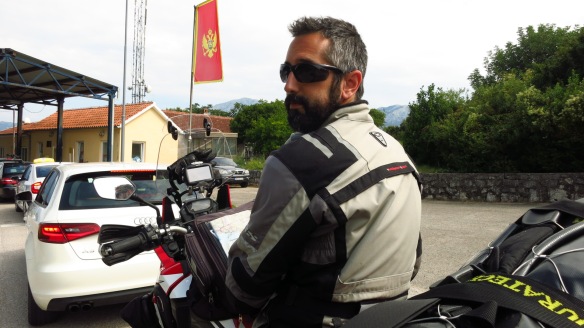 We were at the entrance of one of the most beautiful and remarkable places in the Adriatic – the Bay of Kotor, an intricate bay surrounded by mountains that reach over 1000m above sea level, and which forms what might be the only fjord in the Mediterranean area. All along its winding coast, over 100km of a road I was quite looking forward to.
We were at the entrance of one of the most beautiful and remarkable places in the Adriatic – the Bay of Kotor, an intricate bay surrounded by mountains that reach over 1000m above sea level, and which forms what might be the only fjord in the Mediterranean area. All along its winding coast, over 100km of a road I was quite looking forward to.
Unfortunately, unlike other roads that have built up great expectations in me, this one turned out to be a bit of a disappointment… the road itself is great, but it is the main thoroughfare in the area, and this time of year it sees heavy traffic. We spent most of the journey stuck behind slow traffic or not moving at all each time the road crossed a town, there was constant traffic coming the other way and it was too narrow to try and ride down the middle as I did in the Bosnian border. By the time we got to Kotor, where traffic was at its absolute worse, and turned off the road to find the apartment, I was glad we did not have to ride all 100km of it. There is a ferry that crosses the bay at its narrowest point, saving about half the trip, but I did not take it because I had read that the road was worth it. If you come here in the midst of the summer tourist season, I would take it.
Our apartment was perched on the mountain side with a stunning view of the bay, Kotor’s old town and the fortress and its walls. To get there I had to ride some of the steepest streets I have ever seen (and those who know where I used to live know how steep the streets were there). This was Nat’s first contact with far Easter European architecture – haphazard, grey, functional, partly unfinished… and she was not impressed with the place at all.
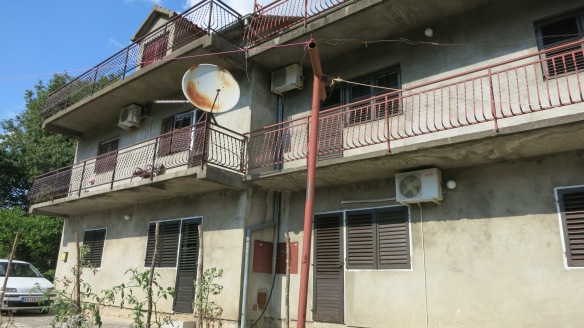
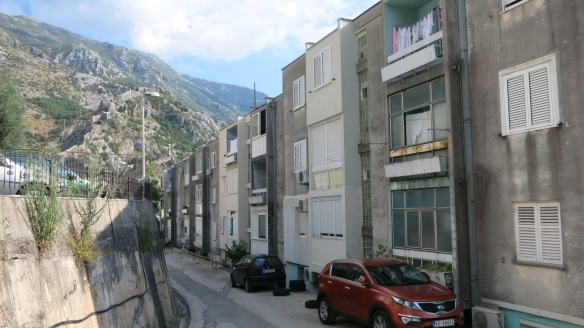 Only after seeing the apartment, which was the best we had found so far, and taking a walk in the afternoon in the beautifully preserved medieval old town did she start to like Montenegro. The heat and traffic jams on the way here had not helped either, so to compensate that we went for a swim in the town beach, which had amazingly clear water for a beach that was right next to a harbour where big cruise ships moor.
Only after seeing the apartment, which was the best we had found so far, and taking a walk in the afternoon in the beautifully preserved medieval old town did she start to like Montenegro. The heat and traffic jams on the way here had not helped either, so to compensate that we went for a swim in the town beach, which had amazingly clear water for a beach that was right next to a harbour where big cruise ships moor.
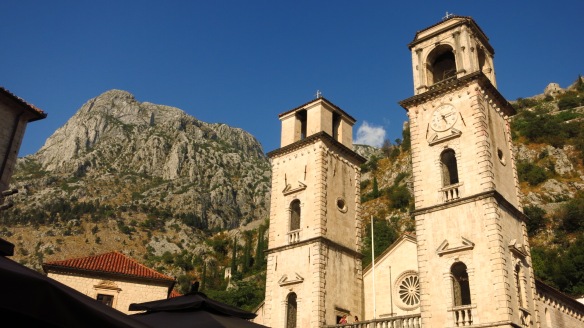
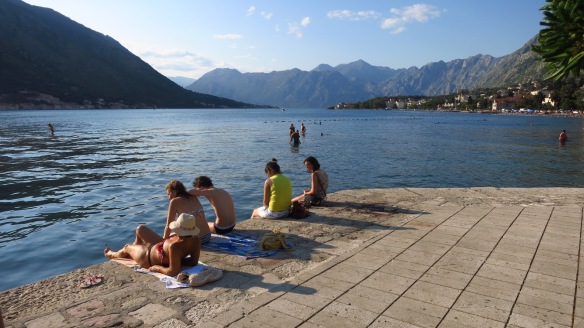 With the sun and the temperature going down we felt brave enough to dare a visit to the fortress and the city walls, an impressive feat of medieval engineering that protected the city from attacks from the mountains. The wall clings to the mountain face almost vertically behind the city, culminating in a fortress with a commanding view of the city below, the bay beyond and the mountains behind.
With the sun and the temperature going down we felt brave enough to dare a visit to the fortress and the city walls, an impressive feat of medieval engineering that protected the city from attacks from the mountains. The wall clings to the mountain face almost vertically behind the city, culminating in a fortress with a commanding view of the city below, the bay beyond and the mountains behind.
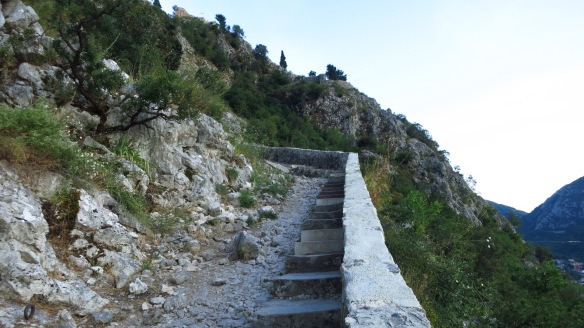 Even this late in the day, with the sun behind the mountains, the temperature was quite high, and we reached the top exhausted and drenched in sweat, but the views were definitely worth it.
Even this late in the day, with the sun behind the mountains, the temperature was quite high, and we reached the top exhausted and drenched in sweat, but the views were definitely worth it.
Kotor Bay
Day 12 – Tuesday 9th August – Kotor Bay (0km)
Having already visited the old town and the fortress yesterday, today we decide to get a boat ride from which we could see the whole bay from the water (much more enjoyable than the views from the motorbike while stuck in traffic) and which also took us out to the open sea, stopped at midday in a beautiful beach were we went for a swim and had lunch by the sea and then into a sea cave called the Blue Cave.
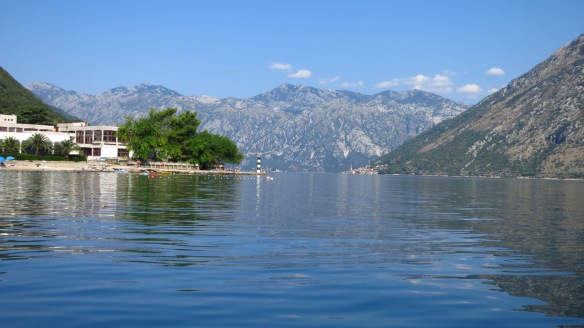
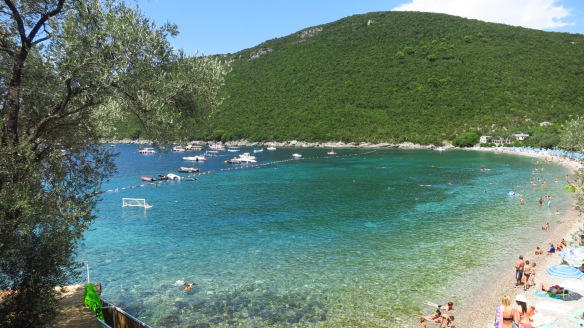
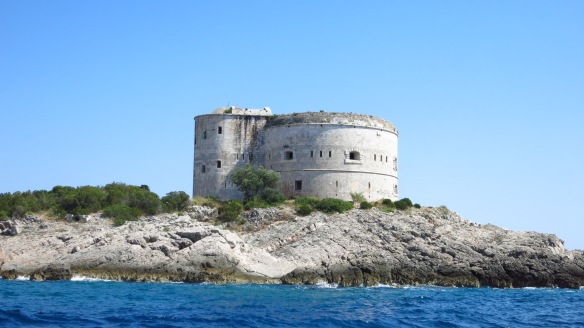
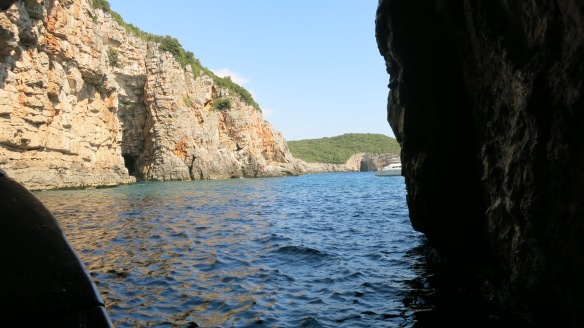 All in all it was quite a good trip, even though the sea was too choppy for the boat to stop long enough to allow us to swim in the cave and on the way back we were too late to visit Our Lady of the Rocks, a church built onto a small island in front of the town of Perast. At least the visit to Perast was nice, and the boat guy offered us a free ride to the church the following day to compensate, but we had already booked accommodation in Albania, so we an excuse to come back here in the future.
All in all it was quite a good trip, even though the sea was too choppy for the boat to stop long enough to allow us to swim in the cave and on the way back we were too late to visit Our Lady of the Rocks, a church built onto a small island in front of the town of Perast. At least the visit to Perast was nice, and the boat guy offered us a free ride to the church the following day to compensate, but we had already booked accommodation in Albania, so we an excuse to come back here in the future.
Another ‘best road in the wooooorrrrrld’?
Day 13 – Wednesday 10th August – From Kotor to Shkodër (209.1km)
Today was the big day – Albania! I was very excited about this, I had heard lots of things about it, mostly contradictory – that it was a beautiful country, but the roads were the worst in Europe, that its people were very kind but it was the place where many stolen vehicles from Europe end up in… But all that would have to wait. First we had a whole day to cross Montenegro and experience some deep contradictions.
On the agenda for the day were a ride into Lovćen National Park to see Njegoš mausoleum, atop one of the highest mountains in the Kotor Bay area, a visit to the coastal city of Budva, where we wanted to see something called ‘Mini Montenegro’, a town built on a small island connected to the coast by a narrow bridge, and a long ride along the southern shore of lake Skadarsko before crossing the border into Albania and stopping for the night in Shkodër, the first big city on the Albanian side. A complete day, then.
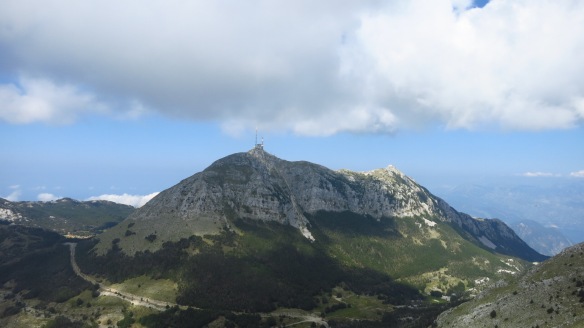 Njegoš mausoleum is built on Lovćen peak, overlooking the Kotor bay. Njegoš was a Lord, bishop and poet of great importance in Montenegro who wished to be buried in the mountain that he had seen all his life from the town of Cetinje, where he was born. The story has it that he built a chapel there, but when he died in 1851 bad weather and an ongoing conflict with Turks prevented his people form burying him there. More than a century later, between 1970 and 1974, the Yugoslav government built a mausoleum on top of the mountain to honour his wish.
Njegoš mausoleum is built on Lovćen peak, overlooking the Kotor bay. Njegoš was a Lord, bishop and poet of great importance in Montenegro who wished to be buried in the mountain that he had seen all his life from the town of Cetinje, where he was born. The story has it that he built a chapel there, but when he died in 1851 bad weather and an ongoing conflict with Turks prevented his people form burying him there. More than a century later, between 1970 and 1974, the Yugoslav government built a mausoleum on top of the mountain to honour his wish.
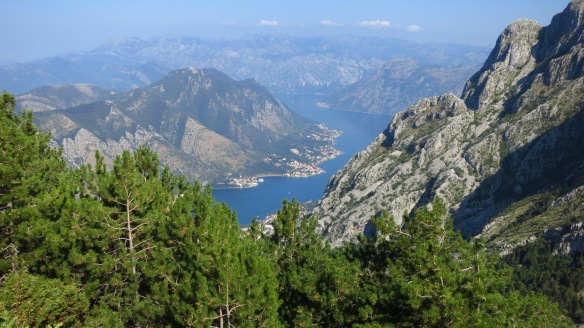 The most direct way to access the peak from Kotor is the P1 road, which takes you from sea level to almost 1,600m through more than 30 heart stopping hairpin corners that make the Stelvio pass pale in comparison, with an breath-taking view of the bay to complete the experience. Not that you want to get too distracted while driving it, mind you – there are few protections separating you from the edge of the cliff, and from time to time a local zooms past the opposite way not caring much about the fact that there is very little space for two cars to drive past each other. On the other side of the mountain, the M23 road down to Budva, on the coast, is faster, wider and with great mountain views. I don’t know how these ‘best roads in the world’ articles are written or how the roads are selected, but I am sure that it is impossible for them to take into account all the roads in the world. Well, here is one that should be high on any of those lists, do not miss it if you come to Montenegro.
The most direct way to access the peak from Kotor is the P1 road, which takes you from sea level to almost 1,600m through more than 30 heart stopping hairpin corners that make the Stelvio pass pale in comparison, with an breath-taking view of the bay to complete the experience. Not that you want to get too distracted while driving it, mind you – there are few protections separating you from the edge of the cliff, and from time to time a local zooms past the opposite way not caring much about the fact that there is very little space for two cars to drive past each other. On the other side of the mountain, the M23 road down to Budva, on the coast, is faster, wider and with great mountain views. I don’t know how these ‘best roads in the world’ articles are written or how the roads are selected, but I am sure that it is impossible for them to take into account all the roads in the world. Well, here is one that should be high on any of those lists, do not miss it if you come to Montenegro.
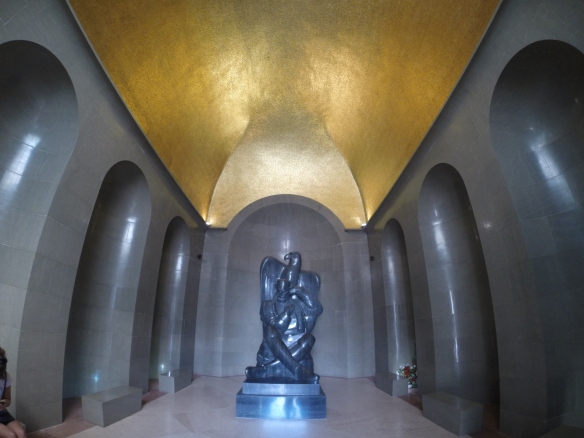 The mausoleum is also worth a visit, you access it via more than 400 steps through a tunnel that ends at the very peak, and it contains a huge statue of the poet carved from a single block of granite and a ceiling covered in real gold.
The mausoleum is also worth a visit, you access it via more than 400 steps through a tunnel that ends at the very peak, and it contains a huge statue of the poet carved from a single block of granite and a ceiling covered in real gold.
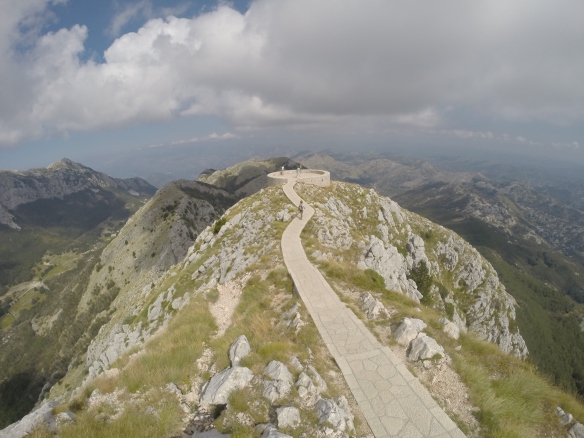 After a great ride down we reached the town of Budva, a popular coastal destination around here. We did not go into it, as the ‘Mini Montenegro’ we wanted to visit was a bit more to the south, but to my eyes it did not look like the kind of place I would like to go to – big hotels and gaudy blocks of apartments, and the usual dreadful traffic.
After a great ride down we reached the town of Budva, a popular coastal destination around here. We did not go into it, as the ‘Mini Montenegro’ we wanted to visit was a bit more to the south, but to my eyes it did not look like the kind of place I would like to go to – big hotels and gaudy blocks of apartments, and the usual dreadful traffic.
A few kilometres down the road we followed the signs to Sveti Stefan, which is the real name of what we had seen advertised in tourist agencies in Kotor as ‘Mini Montenegro’ and found a supposedly two-way street packed full of parked cars where it was almost impossible to make any progress at all. At the end of it, nowhere to park, not even a motorbike, except for a private car park full of luxury cars where they informed us that it was 2€ an hour. Tired of manoeuvring the bike in the stifling heat, I decided that we were not going to spend more than that visiting the town, particularly in riding boots and trousers, so we paid and parked.
We had just set foot on the pedestrian bridge that connects the beach to the town when we heard a voice behind us shouting ‘Sir, Sir, you can’t go there, it is private!’ I turned around find a textbook example of a security guard – tall, burly, shaven head, sunglasses, earpiece, the lot, who explained us in a condescending tone that the town was a hotel and that access was restricted to guests only. I looked down the walkway at the town, then at the guard again. ‘The whole town?’ I asked. ‘The whole town’, he replied in a tone that said ‘get your filthy boots of my bridge, you lowlife’.
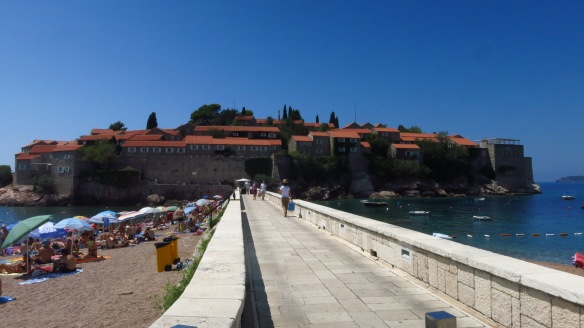 We looked around and saw that access to the beach on both sides of the town was also barred by security guards, and that everyone around us was getting off high-end cars or luxury airport shuttle vans and wearing watches that must cost more than my bike. Well, ‘fuck the rich’, we thought, and got the bike out of the car park and the hell out of there.
We looked around and saw that access to the beach on both sides of the town was also barred by security guards, and that everyone around us was getting off high-end cars or luxury airport shuttle vans and wearing watches that must cost more than my bike. Well, ‘fuck the rich’, we thought, and got the bike out of the car park and the hell out of there.
It was well past midday, and the heat was becoming unbearable, so we headed fast to the interior in search of the road that followed the south bank of lake Skadarsko and a cooler place to stop and eat. With the traffic, the heat, and the disappointment of Sveti Stefan, I was thinking that if I heard the words ‘beach’ and ‘holiday’ in the same sentence anytime before 2030, I was getting a divorce.
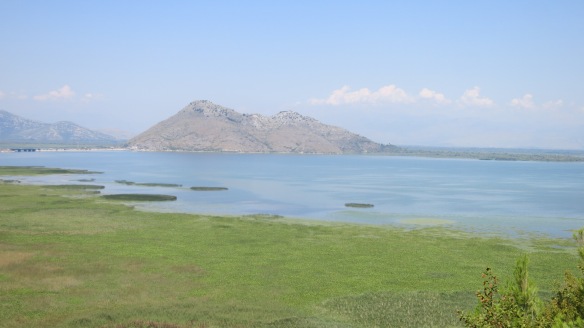 Fortunately, the road along the lake was very nice and we found a nice spot under the trees of a small war memorial monument where we had lunch, so my mood improved soon.
Fortunately, the road along the lake was very nice and we found a nice spot under the trees of a small war memorial monument where we had lunch, so my mood improved soon.
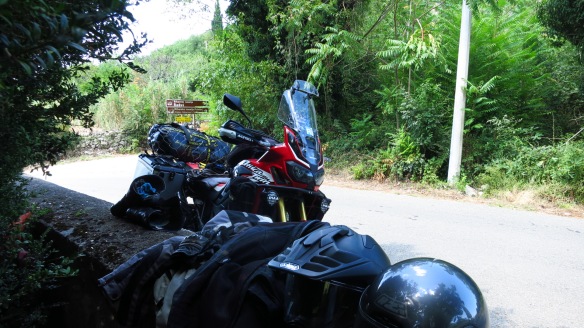 According to the map, this was the second main road south of the lake and to the border after the coast road, but it definitely did not look like that. It was little more than a paved dirt track, barely wide enough for a car, that connected all the tiny villages on the lake, and the place could not have looked more different from Budva – we were in deep Montenegro now, and I was having a great time.
According to the map, this was the second main road south of the lake and to the border after the coast road, but it definitely did not look like that. It was little more than a paved dirt track, barely wide enough for a car, that connected all the tiny villages on the lake, and the place could not have looked more different from Budva – we were in deep Montenegro now, and I was having a great time.
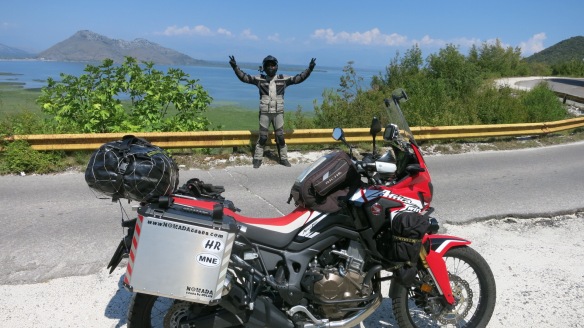 Turning the last corner on the road, we left the lake behind and at our feet was Albania, just a short ride down the mountain. There was no small backroad border crossing this time, and as we joined the main road coming from the coast I was anticipating long queues to leave Montenegro and long queues to enter Albania. There were quite a lot of cars, buses and campervans, but two things made things a lot easier than we expected – this was, according to a sign proudly displayed on the wall, the first joint border crossing in the Balkan region, built with EU funds, which saved us the double exit-entry process, and were directed to the pedestrian crossing point, where another motorbike was already being processed, so we jumped the whole queue.
Turning the last corner on the road, we left the lake behind and at our feet was Albania, just a short ride down the mountain. There was no small backroad border crossing this time, and as we joined the main road coming from the coast I was anticipating long queues to leave Montenegro and long queues to enter Albania. There were quite a lot of cars, buses and campervans, but two things made things a lot easier than we expected – this was, according to a sign proudly displayed on the wall, the first joint border crossing in the Balkan region, built with EU funds, which saved us the double exit-entry process, and were directed to the pedestrian crossing point, where another motorbike was already being processed, so we jumped the whole queue.
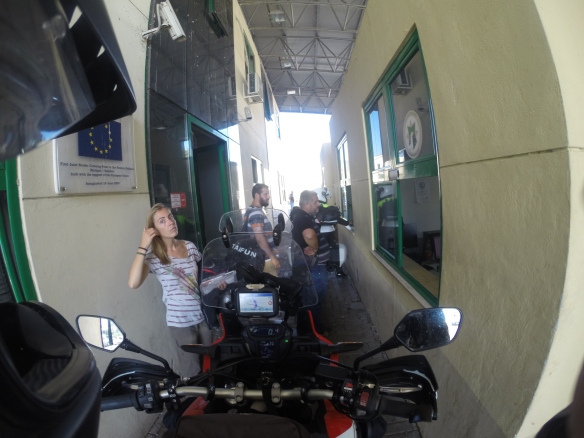 Once on the other side we stopped to buy insurance, as I had read that Albania was not covered in EU policies, but when the guy in one of the booths by the road offering insurance checked our green card, he said that we were already covered. Great!
Once on the other side we stopped to buy insurance, as I had read that Albania was not covered in EU policies, but when the guy in one of the booths by the road offering insurance checked our green card, he said that we were already covered. Great!
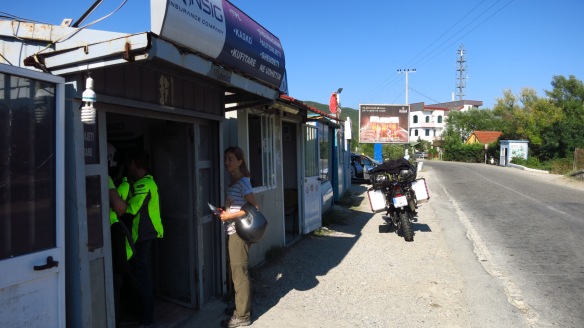 Traffic and the road to Shkodër were no worse than what I had seen in other places in Eastern Europe, with horse carts and other curious vehicles sharing the road with cars, buses and trucks.
Traffic and the road to Shkodër were no worse than what I had seen in other places in Eastern Europe, with horse carts and other curious vehicles sharing the road with cars, buses and trucks.
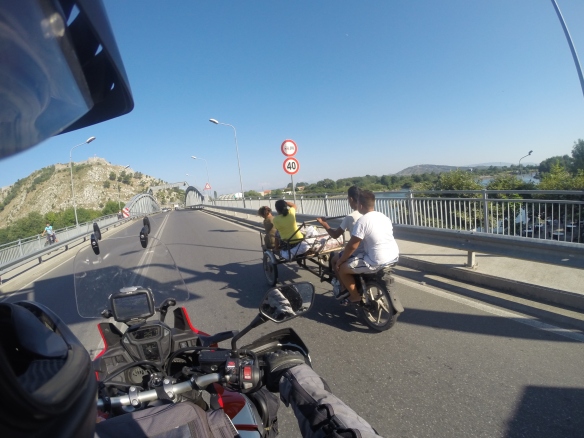 We found our hotel, more by chance than thanks to the GPS, and were surprised to see that it had an underground car park with CCTV and rooms that, apart from huge, were far more luxurious than we were expecting at those prices. After a shower we went to the centre to change some money, find a country sticker and have a beer to celebrate our arrival in a new country.
We found our hotel, more by chance than thanks to the GPS, and were surprised to see that it had an underground car park with CCTV and rooms that, apart from huge, were far more luxurious than we were expecting at those prices. After a shower we went to the centre to change some money, find a country sticker and have a beer to celebrate our arrival in a new country.
The Albanian Alps
Day 14 – Thursday 11th August – From Shkodër to Theth (72,3km)
The plan for today was to ride north to the … natural park, see the area, maybe go for a bit of trekking and spend the night there. It was only 70 km away and according to the map the road should be good – it was marked as a main one and it led to the most important natural park in the north of the country, after all.
We left Shkodër at 8:00 on the road leading to Podgorica and a few kilometres out of the city turned north following a sign that pointed us to the park. The main road turned immediately into the same kind of thing we had found in the lake in Montenegro – very narrow and bumpy, but at least there were no potholes and there were petrol station in most towns we rode through.
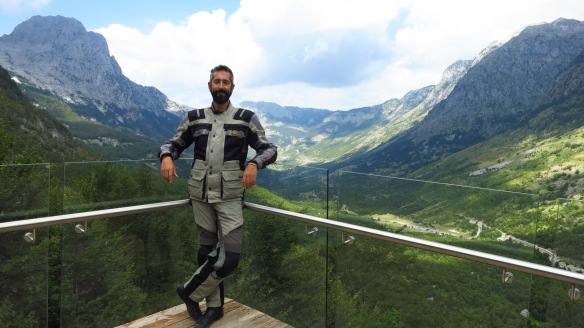 In front of us great mountains stood high against the morning sky, making it clear that this park was wilder than Plitvice or Lovćen – these were the kinds of mountains I was used to finding in central Pyrenees. The road started climbing higher and higher and to my surprised it became much better – still narrow, but newly resurfaced, so it was a pleasure to ride. We kept gaining altitude along a valley, passing some very slow old vans full of people – the local buses – until we reached the end of the valley, where the road climbed along the steep mountain side in a series of hairpins and culminated in a pass… where it ended.
In front of us great mountains stood high against the morning sky, making it clear that this park was wilder than Plitvice or Lovćen – these were the kinds of mountains I was used to finding in central Pyrenees. The road started climbing higher and higher and to my surprised it became much better – still narrow, but newly resurfaced, so it was a pleasure to ride. We kept gaining altitude along a valley, passing some very slow old vans full of people – the local buses – until we reached the end of the valley, where the road climbed along the steep mountain side in a series of hairpins and culminated in a pass… where it ended.
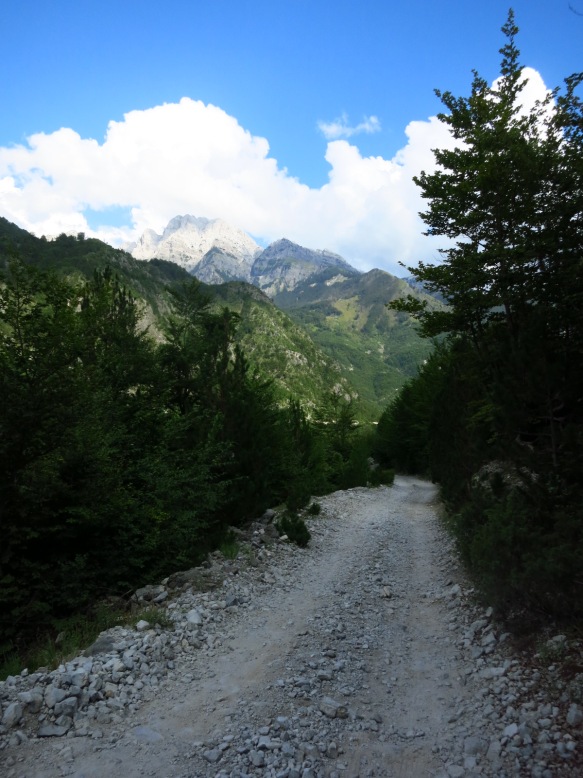 I had read that this is a common occurrence in Albania – if the map says that there is a road, there will be one, but it is impossible to know how wide it will to be, or in what condition, or whether it will be paved or not, and quite often the road just ends and there is a dirt track like the one we had just found with 11km to reach the town of Theth, our destination. It should also be noted that we had seen just one more sign after leaving the main road, announcing that we had entered the natural park, but there was no access control booth, tourist information centre, or signs indicating trekking routes. Zero infrastructure, just the mountains, which by now resembled more the Alps than the Pyrenees.
I had read that this is a common occurrence in Albania – if the map says that there is a road, there will be one, but it is impossible to know how wide it will to be, or in what condition, or whether it will be paved or not, and quite often the road just ends and there is a dirt track like the one we had just found with 11km to reach the town of Theth, our destination. It should also be noted that we had seen just one more sign after leaving the main road, announcing that we had entered the natural park, but there was no access control booth, tourist information centre, or signs indicating trekking routes. Zero infrastructure, just the mountains, which by now resembled more the Alps than the Pyrenees.
A bit further down the dirt track we found a wooden hut that seemed to be a bar and stopped to ask about the road ahead. Parked in front of it there were a Swiss and an Italian on KTM 990 Adventures who asked us if we had some extra petrol. They had come up the same way as we did, had been having too much fun and had not filled up in the last town.
Some locals told us that the road was OK, and there seemed to be quite a lot of traffic, although it was all 4x4s and vans. We decided to go ahead, and even though I even saw two or three regular cars, at some points the road was the kind of place people from Western Europe would not even dream of driving their SUVs through. The guys on the KTMs stood up and attacked the road with pleasure, but I had a much harder time taking a fully loaded bike with a passenger down the road into the valley where Theth was.
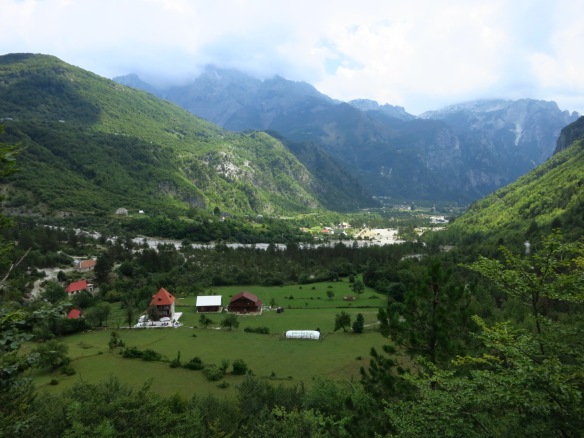 Even though maps mark it as a town, Theth is more a few scattered houses with no streets, no shops, no service and a crappy dirt road connecting it to the rest of the world. One of the most important towns in the natural park was the very definition of unspoilt territory, what I imagine the Alps looked like centuries ago, before tourists, ski resorts and guided treks.
Even though maps mark it as a town, Theth is more a few scattered houses with no streets, no shops, no service and a crappy dirt road connecting it to the rest of the world. One of the most important towns in the natural park was the very definition of unspoilt territory, what I imagine the Alps looked like centuries ago, before tourists, ski resorts and guided treks.
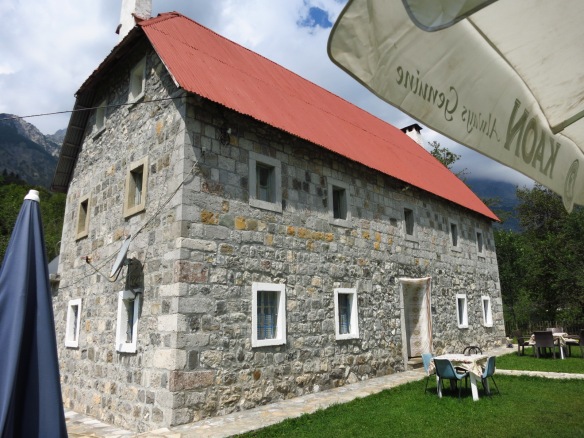 In spite of all this, we had found the house we were going to stay in through Booking.com, and there were plenty of other houses in Theth on the web. The house was a three-storey stone farmhouse where a local family rented three rooms, and immediately after our arrival the youngest son, who spoke some English, introduced us to the whole family, including a grandmother that greeted us with a bear hug. It was midday, and after asking us whether we were vegetarians, they served us one of the best meals I had ever had, all locally sourced, I’m sure. Popping to the supermarket is just not an option here.
In spite of all this, we had found the house we were going to stay in through Booking.com, and there were plenty of other houses in Theth on the web. The house was a three-storey stone farmhouse where a local family rented three rooms, and immediately after our arrival the youngest son, who spoke some English, introduced us to the whole family, including a grandmother that greeted us with a bear hug. It was midday, and after asking us whether we were vegetarians, they served us one of the best meals I had ever had, all locally sourced, I’m sure. Popping to the supermarket is just not an option here.
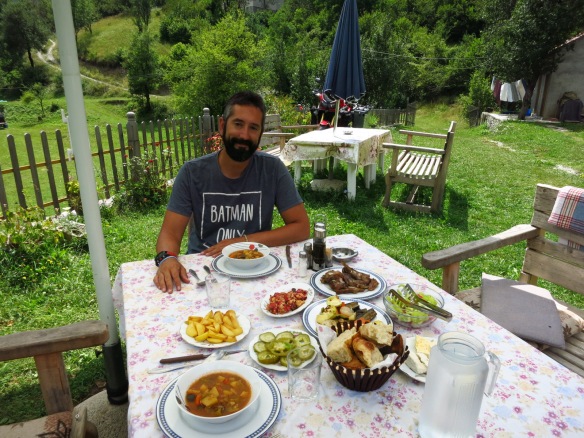 In the afternoon we went for a walk down to the town ‘centre’ – a walk through the forest until we found more houses and the river at the bottom of the valley – and saw that there was a school which seemed to be in use. Well, at least one classroom in the ground floor, as the upper floor looked abandoned and the roof was damaged.
In the afternoon we went for a walk down to the town ‘centre’ – a walk through the forest until we found more houses and the river at the bottom of the valley – and saw that there was a school which seemed to be in use. Well, at least one classroom in the ground floor, as the upper floor looked abandoned and the roof was damaged.
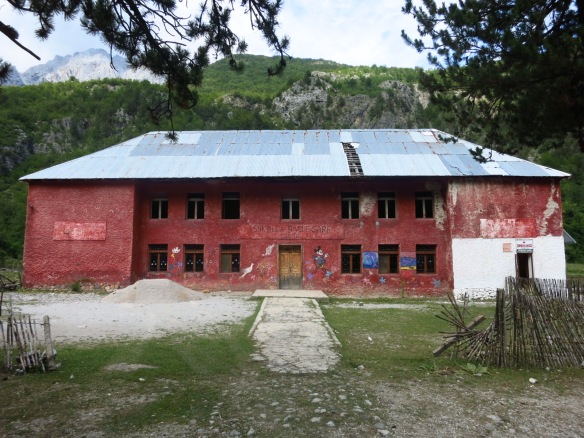
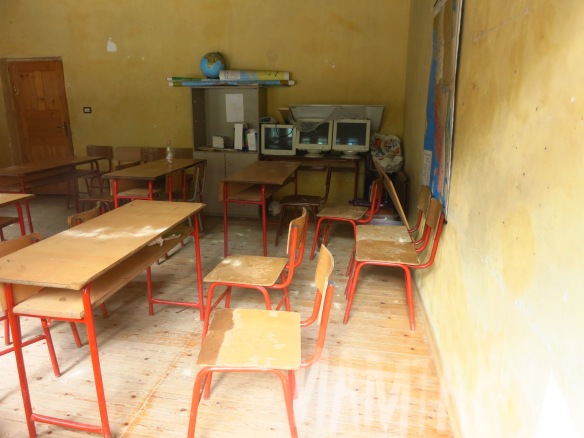 We kept walking down the valley trying to find the way to a waterfall that seemed to be a main attraction here, but there were no indications. We asked around and were surprised to find a fair number of tourists, and then we discovered that this is the starting point for many trekking routes, including what is known as the Peaks of the Balkans Trail, a 10-day trek that crosses into Kosovo and Montenegro – something to take into account for a future holiday.
We kept walking down the valley trying to find the way to a waterfall that seemed to be a main attraction here, but there were no indications. We asked around and were surprised to find a fair number of tourists, and then we discovered that this is the starting point for many trekking routes, including what is known as the Peaks of the Balkans Trail, a 10-day trek that crosses into Kosovo and Montenegro – something to take into account for a future holiday.
Still looking for the way to the waterfall we saw a sign to the local museum.
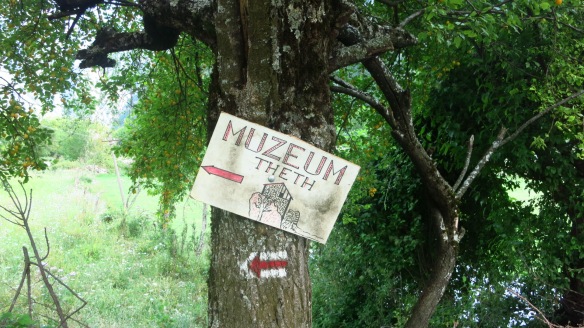 And decided to go visit it. As you can see, the access had been adapted for the disabled.
And decided to go visit it. As you can see, the access had been adapted for the disabled.
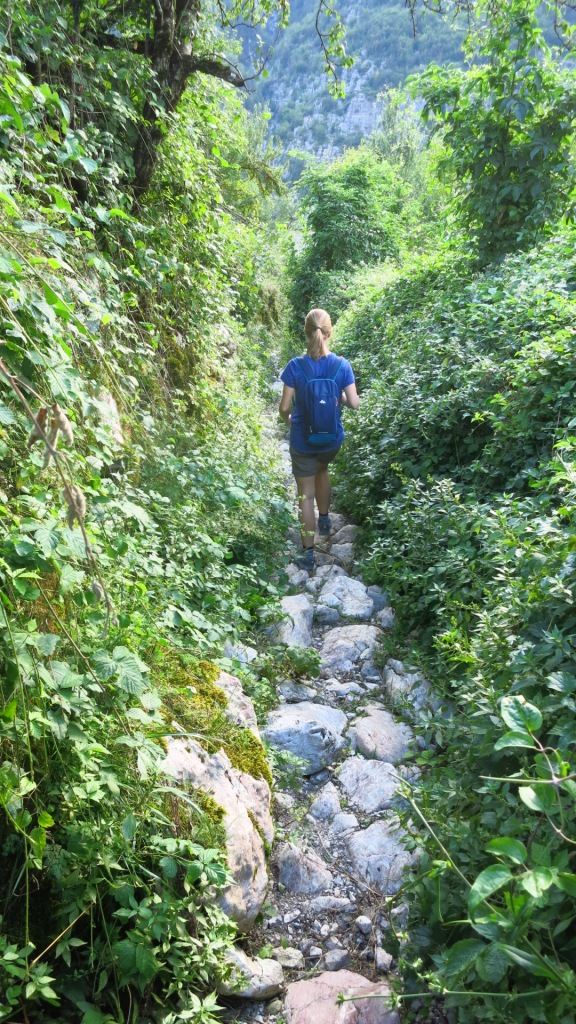 The building that hosted the museum had two floors – on the ground floor there was a stable which was in use, and on the upper floor the ethnographic museum itself, with the exhibits divided in two rooms.
The building that hosted the museum had two floors – on the ground floor there was a stable which was in use, and on the upper floor the ethnographic museum itself, with the exhibits divided in two rooms.
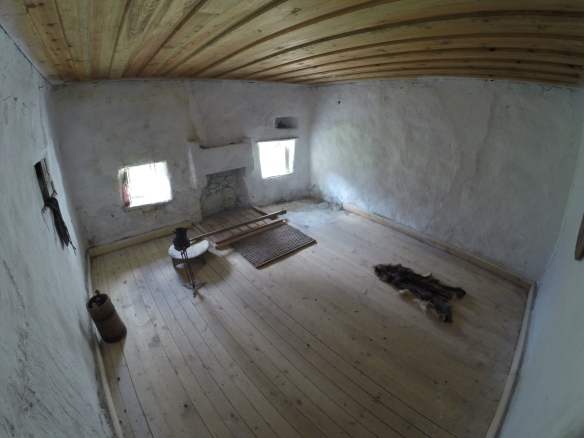 On our way out we saw what we assume were the curators, as they were the only living creatures around.
On our way out we saw what we assume were the curators, as they were the only living creatures around.
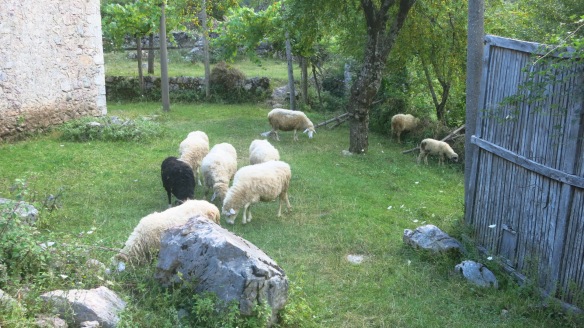 Back on the main ‘street’ we found another guesthouse were we finally got directions to the waterfall. We walked until it was on sight, but it was getting late and we had no torches for the way back, and the sky was getting cloudier and cloudier and we heard some thunder behind the nearest peaks, so we decided to head back, as it was quite a long way up the valley to our house.
Back on the main ‘street’ we found another guesthouse were we finally got directions to the waterfall. We walked until it was on sight, but it was getting late and we had no torches for the way back, and the sky was getting cloudier and cloudier and we heard some thunder behind the nearest peaks, so we decided to head back, as it was quite a long way up the valley to our house.
The rain caught us just as we were walking past the school and we ran to take refuge under the porch, where we waited for an hour watching the deluge and thinking that the dirt track would be in atrocious conditions for the ride back up the following day.
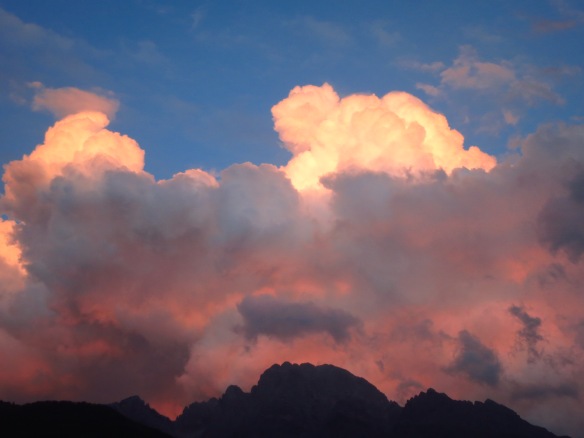 When we got home I was surprised to see a Honda CBF1000 with road tires parked next to my bike. If I had had a hard time getting here, that guy must have experienced hell. I asked in the house and they said that it belonged to two Italians that did not know that the road was like that. Well, no wonder. There is no warning anywhere that the road is like that, and looking up Theth online one imagines a quaint mountain village at the doors of natural park, so I imagine they were not the only ones who booked a room in one of the many available guest houses thinking that this was a popular tourist destination easy to get to.
When we got home I was surprised to see a Honda CBF1000 with road tires parked next to my bike. If I had had a hard time getting here, that guy must have experienced hell. I asked in the house and they said that it belonged to two Italians that did not know that the road was like that. Well, no wonder. There is no warning anywhere that the road is like that, and looking up Theth online one imagines a quaint mountain village at the doors of natural park, so I imagine they were not the only ones who booked a room in one of the many available guest houses thinking that this was a popular tourist destination easy to get to.
We’ll see what happens tomorrow when we have to ride that track back.
Off the road again
Day 15 – Friday 12th August – From Theth to Shkodër (73km)
The only plan for the day was to ride up the dirt track, out of the valley and back to Shkodër to spend the night there before heading to lake Koman the following day, so for the first time in quite a while there was no need to get up early. That doesn’t mean, however, that we got to sleep until late – we were in the same time zone as back home but a lot more to the east, so the sun was up and shining before 6:00, and our room did not have any blinds or shutters. It did not even have windows that shut properly, so I had spent the night under a blanket and a duvet.
With no alternative but an early start of the day, we took our time to enjoy the breakfast that was included in the stay, as copious as lunch the day before, and to wait for the sun to dry the track a bit. We had a chat with the Italians, who told us that they had had a hard time indeed to ride their bike down and that they were also leaving today.
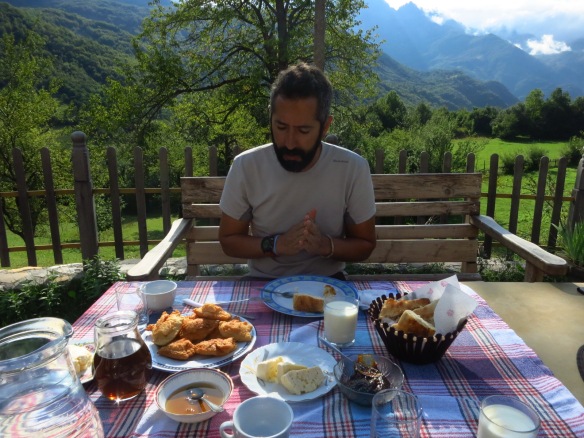
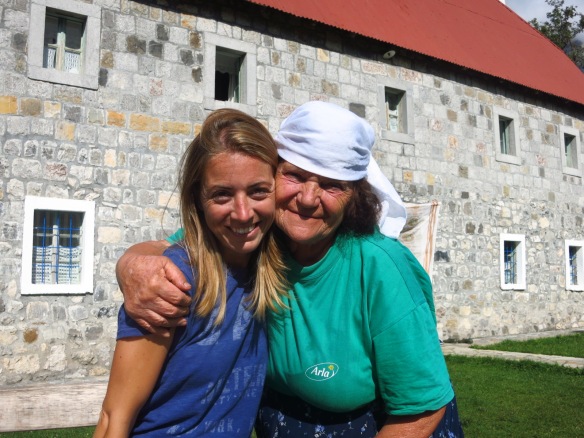 Having loaded the bike and said goodbye to our host family we set off, ready to tackle the track. I am very happy to say that if you are expecting some thrilling tale of us pushing the bike through mud, picking it up from the ground repeatedly and generally having a miserable time, you’ll be disappointed. Despite the mud at some points, some poodles and several 4x4s coming out of tight corners too fast, we had quite an enjoyable way back. In fact I had quite some fun, and the bike performed flawlessly, swallowing rocks, gravel, potholes, mud and poodles without flinching. We even had time to stop and enjoy the wonderful views down the valley.
Having loaded the bike and said goodbye to our host family we set off, ready to tackle the track. I am very happy to say that if you are expecting some thrilling tale of us pushing the bike through mud, picking it up from the ground repeatedly and generally having a miserable time, you’ll be disappointed. Despite the mud at some points, some poodles and several 4x4s coming out of tight corners too fast, we had quite an enjoyable way back. In fact I had quite some fun, and the bike performed flawlessly, swallowing rocks, gravel, potholes, mud and poodles without flinching. We even had time to stop and enjoy the wonderful views down the valley.
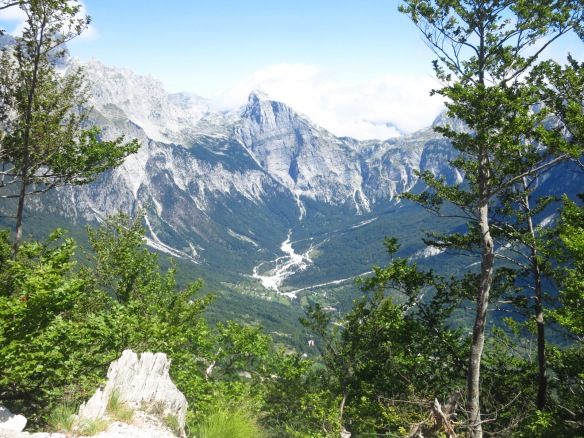
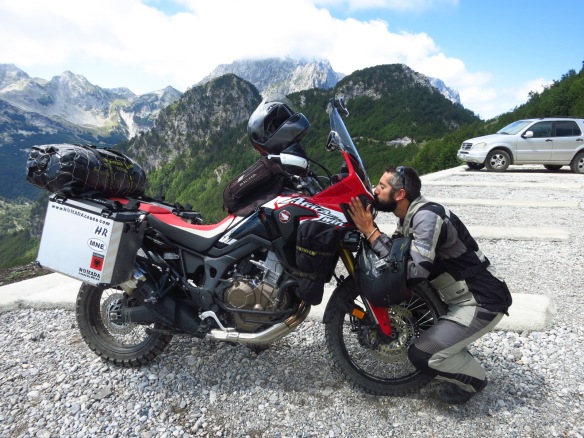
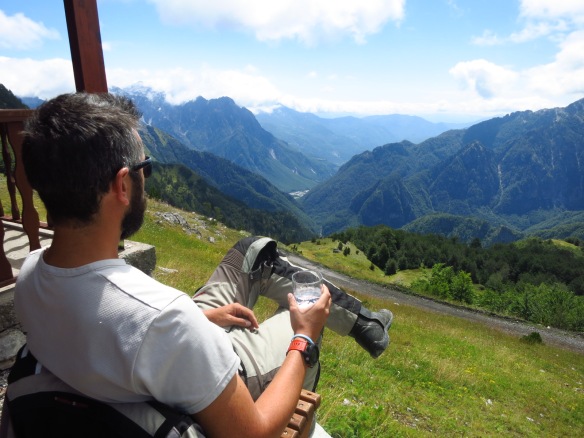 Back in Shkodër we checked in the same hotel we had been in two days before, went for a beer in the centre and early to bed – we were getting up at 6:00 the following morning to make it in time to catch the ferry that crosses lake Koman.
Back in Shkodër we checked in the same hotel we had been in two days before, went for a beer in the centre and early to bed – we were getting up at 6:00 the following morning to make it in time to catch the ferry that crosses lake Koman.
An old ferry and a young country
Day 16 – Saturday 13th August – From Shkodër to Prizren (140km)
Lake Koman is not a natural lake, but a reservoir with at least two dams and power stations. After they were built and a vast valley area covered with water, a ferry service was established to serve the local villages. Now, it is important to put that statement in the right perspective – this is Albania we are talking about, so when I say ‘villages’ I mean one or two houses at most and the ferry itself was quite an adventure.
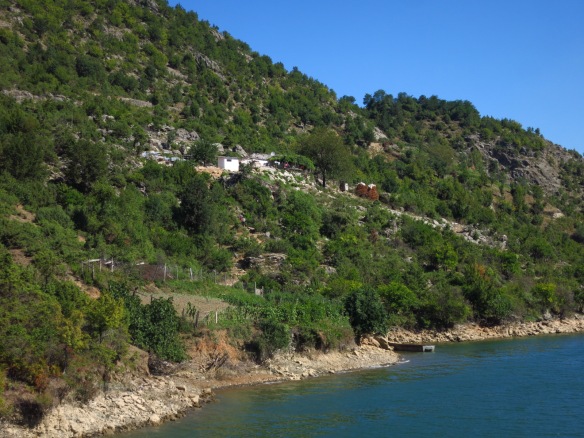 We had seen that there was only one ferry per day to Fierzë, leaving at 9:00 and we made it to Koman with about 20 minutes to spare. The road there had been a similar affair to the one in the natural park the day before, only this time it did not turn into a dirt road even thought it was so damaged at some points that it was close to it. At the foot of the Koman lake dam it went into a tunnel cut in the rock which according to the map lead to the reservoir and the ferry docking point. Just before the end of the tunnel we saw cars stopped and a van that was blocking the way out onto the dock and seemed to be unloading passengers, so we stopped and waited for it to finish.
We had seen that there was only one ferry per day to Fierzë, leaving at 9:00 and we made it to Koman with about 20 minutes to spare. The road there had been a similar affair to the one in the natural park the day before, only this time it did not turn into a dirt road even thought it was so damaged at some points that it was close to it. At the foot of the Koman lake dam it went into a tunnel cut in the rock which according to the map lead to the reservoir and the ferry docking point. Just before the end of the tunnel we saw cars stopped and a van that was blocking the way out onto the dock and seemed to be unloading passengers, so we stopped and waited for it to finish.
Before I had time to go and have a look outside the tunnel a guy who seemed to be working for the ferry walked up to us and asked whether we had booked tickets for the crossing. Erm… no, we did not know that we could or had to book in advance, but seeing that in about five minutes six or seven more cars had arrived and parked behind us in the tunnel, I started to worry about it.
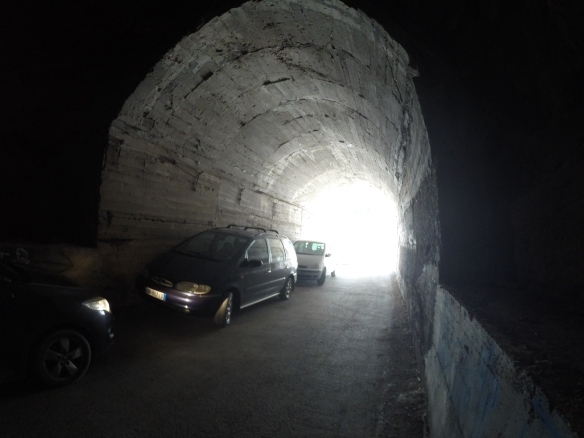 ‘No problem, no problem, I find you place, I call you’ said the guy and went out of the tunnel again. The van had finished unloading passengers but it was not moving, so I decided to go out onto the dock and see what the situation was like.
‘No problem, no problem, I find you place, I call you’ said the guy and went out of the tunnel again. The van had finished unloading passengers but it was not moving, so I decided to go out onto the dock and see what the situation was like.
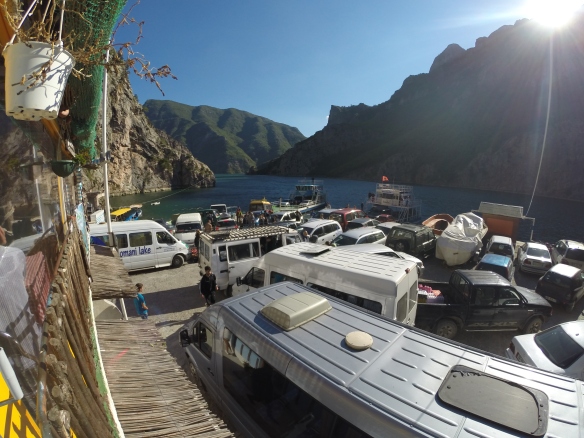 I walked out of the tunnel and found myself in the middle of complete and utter chaos. The dock was tiny, and there were more than a dozen cars and vans with whole families and even animals in them, parked with no apparent order at all, pointing in all directions and covering every inch of space available, it was like a Tetris game gone very, very wrong. On the water there were two car ferries and a passenger one, half full of vehicles that wanted to get off but could not, and I was standing right in the middle of all this, watching the scene in motorbike clothes and eating a banana we had just bought from a street vendor. I could not have looked more out of place.
I walked out of the tunnel and found myself in the middle of complete and utter chaos. The dock was tiny, and there were more than a dozen cars and vans with whole families and even animals in them, parked with no apparent order at all, pointing in all directions and covering every inch of space available, it was like a Tetris game gone very, very wrong. On the water there were two car ferries and a passenger one, half full of vehicles that wanted to get off but could not, and I was standing right in the middle of all this, watching the scene in motorbike clothes and eating a banana we had just bought from a street vendor. I could not have looked more out of place.
In what can only be described as the most amazing combination of life-size tile puzzle and logistics, the ferry guys, moving one car at a time into gaps they made out of nowhere managed to get the cars off the ferries and down the tunnel, some of them in reverse until the other end, no mean feat considering that the tunnel was long, steep and with corners inside, and started loading the waiting cars.
The dock itself was very basic, the ferry loading ramp was very narrow and there was a huge gap between the both that some guys had tried to cove with an old mooring rope. Cars went on board bumper to bumper, and the staff even lifted the back of a VW to push it closer to the railings and make room for one more car that went on sideways and with one wheel left on the ramp.
Most people were locals and seemed used to it, but this last car belonged to an old Swiss couple that nearly had heart attack trying to get it on board.
Once the operation was complete the guy from earlier came to find me and said that there was room for the bike. I looked and the only room was a tiny gap next to the loading ramp. The ferry’s old diesel engine was already coughing into life, and he urged me to go get the bike. There was no corridor left in the dock, the space that had been created to unload the cars had been filled again with more cars that kept coming, so I had to zigzag around bikes, down behind a small car, up in front of it, over a mooring rope, down the slippery ramp and sideways onto the wooden deck wedging the bike between the post that held the ramp cable and the VW. The deck was not flat there, so I could not leave the bike on the side stand because it would fall on the VW, and there was no room to pull it back onto the centre stand. The guy who was helping me keep it standing gestured to me to tie it to the ramp post, but gave me no rope. The ferry was already pulling back from the dock, so I was left on my own to undo one of the straps holding the rack bag and tie the bike to the post while pushing it with my body to prevent it from falling over and trapping me against the VW.
With the bike seemingly secure, albeit too close to the edge of the deck for my peace of mind, I went to the upper deck to enjoy the journey. Full to the limit of its capacity, the ferry started to slowly move over the surface of the lake against the strong morning wind, with the water line worryingly close to the deck. There were no life vests nor floats, and the boat literally seemed to have been built welding together pieces of scrap metal and using old truck parts. It was quite an experience.
The dock in Fierzë, which we reached after a three hour long journey comparable to a cruise in the Norweigian fjords, had a lot more space but to be honest, there was no dock. The ferry just came as close to the shore as possible and lowered the ramp on a slope of gravel and rocks.
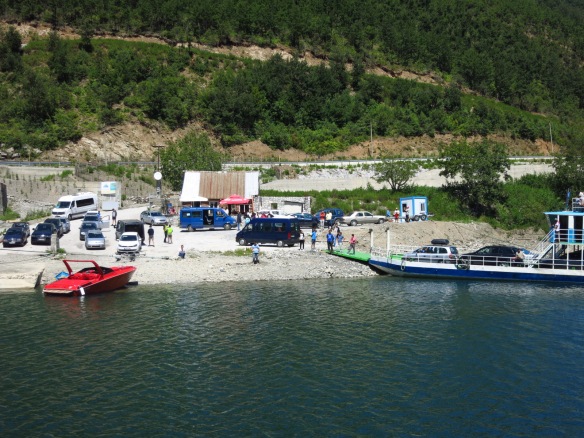 The cars made it out the best they could, wheels spinning and the crew pushing, and then we pushed the bike backwards up the shore.
The cars made it out the best they could, wheels spinning and the crew pushing, and then we pushed the bike backwards up the shore.
Glad to have made it in one piece, we left the dock ad stopped at the first restaurant we found, where a very nice waiter offered us half a kilo of fish just caught from the lake. A welcome feast after the ferry experience.
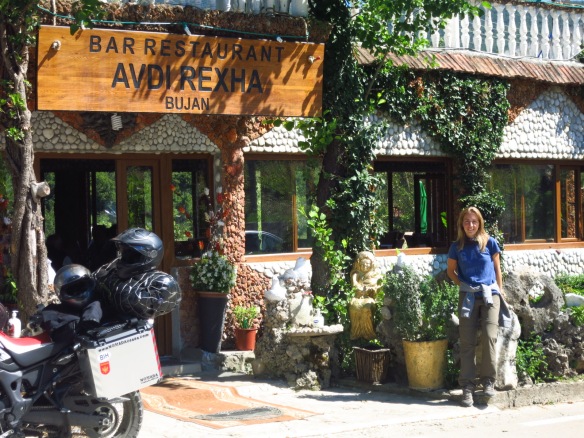 From the dock to the border the road was excellent, and we made it to the next country in no time.
From the dock to the border the road was excellent, and we made it to the next country in no time.
A few posts ago I said that you should always listen to advice from the locals when travelling. Unless, apparently, said local has left the country in search of a better life. A very good friend of mine works for the EU in Brussels and when we told him about our intention to visit Kosovo he very kindly asked about the country on our behalf with a colleague of his who is from there. She said that there was ‘poverty, misery and nothing to see’ there.
Well, I am happy to say that at least in the southern part of the country the landscape was beautiful, I had a great ride from the border in the mountains to Prizren, were we were spending the night, and the city itself was a very pleasant surprise, the old town bustling with life in small bars and street cafés and restaurants, surprisingly similar to Sarajevo.
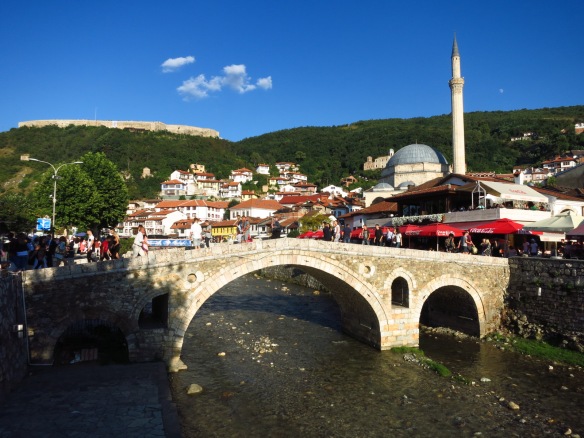 We walked up to the town fortress from where we enjoyed a stunning sunset with the sound of live music from a band that was giving a concert there, and had dinner in one of the restaurants in the old town before heading to the hostel, where they had provided space in a car park with CCTV for free.
We walked up to the town fortress from where we enjoyed a stunning sunset with the sound of live music from a band that was giving a concert there, and had dinner in one of the restaurants in the old town before heading to the hostel, where they had provided space in a car park with CCTV for free.
To Skopje or not to Skopje?
Day 17 – Sunday 14th August – from Prizren to Skopje (104km)
A week ago, while we were in Dubrovnik, we had heard news that a flash flood had affected Skopje, leaving at least a dozen dead, over 60 injured and damaging the roads in and around the capital, and that the government wanted to declare a state of emergency.
After that the news in international outlets went quiet about the matter and the time came for us to make a decision whether to go there and spend two days as planned or skip Macedonia and go on to Bulgaria. We had a booking for two nights in a hostel in Skopje, so we wrote to our host to ask about the situation, and he promptly sent us a reply assuring us that there was no problem in the city nor in the roads leading to it.
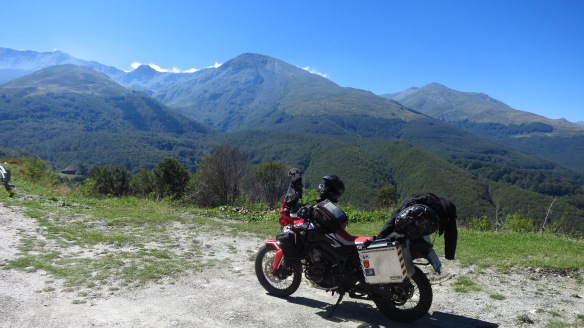 Instead of leaving Prinzen on the main road to Pristina and then turn south towards Skopje, we took the R115, a small regional road that followed a canyon starting right behind the city fortress where we had seen the sunset and then climbed to well above 1000m through the Malet e Sharrit natural park.
Instead of leaving Prinzen on the main road to Pristina and then turn south towards Skopje, we took the R115, a small regional road that followed a canyon starting right behind the city fortress where we had seen the sunset and then climbed to well above 1000m through the Malet e Sharrit natural park.
On the other side of the park we joined the main road from Pristina to the border, where we found a lot of traffic and an endless queue at the border crossing.
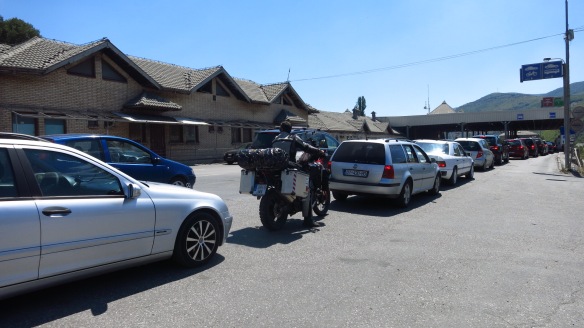 After that the ride to the capital was quite fast and uneventful, but the first impression I got from Macedonia was the worst so far these holidays – after everything we had seen, the landscape was featureless here, dusty and scorched by the sun, with scattered factories and warehouses here and there. At least the traffic was good, and funnily enough we entered the city and rode to the hotel practically without stopping. Not bad for the only capital city we have visited so far.
After that the ride to the capital was quite fast and uneventful, but the first impression I got from Macedonia was the worst so far these holidays – after everything we had seen, the landscape was featureless here, dusty and scorched by the sun, with scattered factories and warehouses here and there. At least the traffic was good, and funnily enough we entered the city and rode to the hotel practically without stopping. Not bad for the only capital city we have visited so far.
My bad first impressions went out the window the moment we entered the hostel and met Goran, our host. He let me park the motorbike inside the house garden, offered us a much better room than the one we had originally booked (which was the cheapest one, we are travelling on a budget) with no extra charge and gave us a very comprehensive explanation of the best things to see in and around the city, with recommendations for the best bars and restaurants included. Having absorbed all that information, and after a shower and some lunch, we went to visit the city.
Skopje turned out to be rather more interesting than I was expecting – it gave me the feeling of a city in a state of flow, quickly transforming itself, and it seemed to have a bit of several different cities thrown together in the same place.
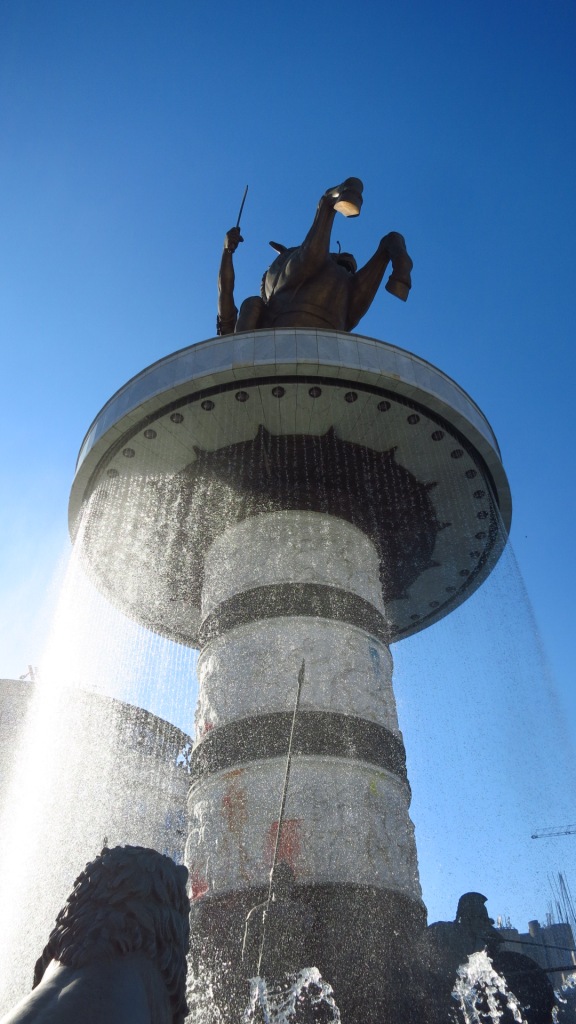 Walking from the hostel to the centre I saw Warsaw as I imagine it must have been some years ago, with big grey buildings left from the communist era and empty today, waiting to be torn down or renovated, half of the building that used to be the main train station already demolished, the other half hosting the city museum, and the old rail yard, shorn of its tracks, waiting for its future use.
Walking from the hostel to the centre I saw Warsaw as I imagine it must have been some years ago, with big grey buildings left from the communist era and empty today, waiting to be torn down or renovated, half of the building that used to be the main train station already demolished, the other half hosting the city museum, and the old rail yard, shorn of its tracks, waiting for its future use.
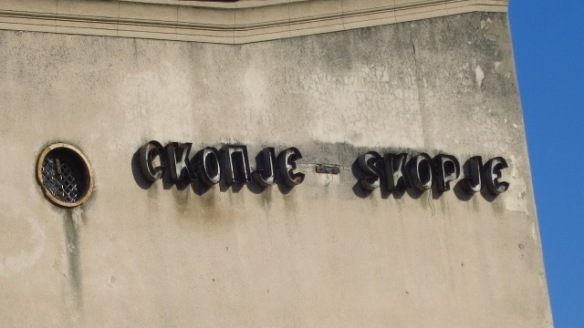 I saw Berlin in the frantic pace of construction in the centre, modern buildings creating new city centres. I saw a wink to Prague in the many statues that lined the two new pedestrian bridges and the river banks in a homage to the most prominent figures of the Macedonian arts, culture, education, politics and religion.
I saw Berlin in the frantic pace of construction in the centre, modern buildings creating new city centres. I saw a wink to Prague in the many statues that lined the two new pedestrian bridges and the river banks in a homage to the most prominent figures of the Macedonian arts, culture, education, politics and religion.
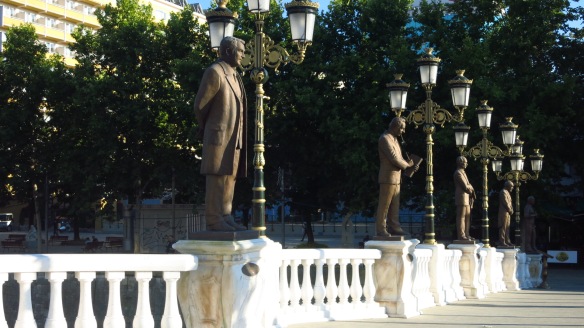 I saw Sarajevo in the old town, walking along cobbled streets lined with tiny wooden storefronts, men sipping tea in street cafés and the sight of a mosque rising above the tiled ceilings.
I saw Sarajevo in the old town, walking along cobbled streets lined with tiny wooden storefronts, men sipping tea in street cafés and the sight of a mosque rising above the tiled ceilings.
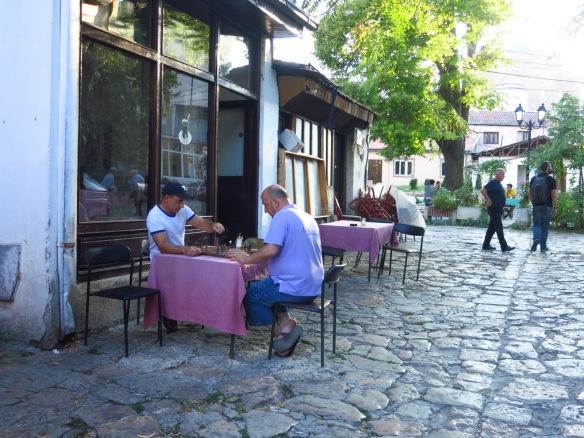 I even saw a tiny bit of London in the red double decker buses that run around the city.
I even saw a tiny bit of London in the red double decker buses that run around the city.
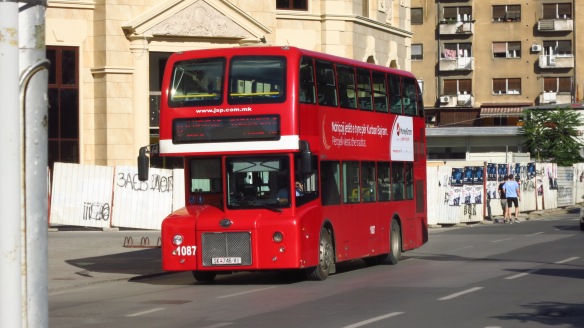 We took all this in, we knew absolutely nothing about the city and we arrived here with no expectations or pre formed notions, so we were blank canvases for the city to paint itself on us in its purest form. We gazed at another sunset form another old fortress and then had an absolutely delicious traditional Macedonian meal at a restaurant Goran had recommended.
We took all this in, we knew absolutely nothing about the city and we arrived here with no expectations or pre formed notions, so we were blank canvases for the city to paint itself on us in its purest form. We gazed at another sunset form another old fortress and then had an absolutely delicious traditional Macedonian meal at a restaurant Goran had recommended.
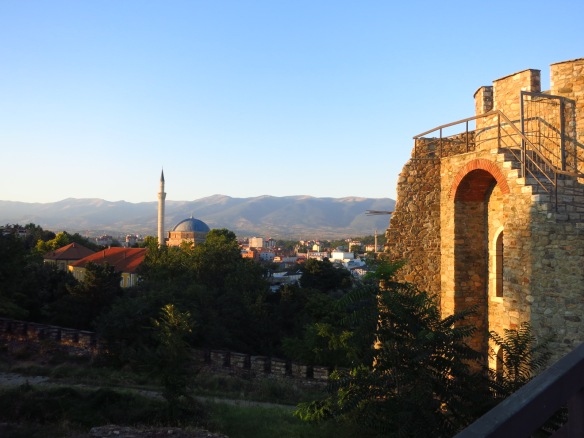 I have always said that each and every capital city has its own very strong personality, and this was no exception. We strolled back to the hostel leisurely, glad that we had decided not to skip the visit.
I have always said that each and every capital city has its own very strong personality, and this was no exception. We strolled back to the hostel leisurely, glad that we had decided not to skip the visit.
Kayaking in Matka canyon
Day 18 – Monday 15th August – From Skopje to Matka canyon and back (37km)
The effects of the floods in the city centre were barely visible other than on the river banks, where lots of debris and tree branches could be seen. Aside from visiting the city, the other thing that had brought us to Skopje was Matka canyon, which we wanted to explore by kayak.
I was afraid that it might be dangerous due to the floods, but it turned out that there is a dam which forms Matka lake and regulates water flow, together with the fact that the floods had affected the north part of the city and the canyon was to the southwest, so Goran assured us that there was no problem. He also told us something we did not know – the lake is home to Vrelo cave, a big cave with very interesting stalactite formations and two lakes inside. He also gave us directions to the entrance of the canyon, which was only 18km from the city.
A short while after leaving the hostel I remembered Goran’s directions – ‘straight ahead, you can’t miss it, you can’t miss it’ – while the GPS took us through a narrow road that crossed a neighbourhood on the outskirts of Skopje where we saw exactly zero signs pointing to the canyon. The only sign I saw was when we were already there, so once again I was very glad to have the GPS.
The road ended in a small car park where we saw no signs of a place that rented kayaks (or the lake), but there seemed to be a narrower road going on from the further left corner of it, so up we went on the bike. It became a lot narrower a few meters down, and we realised it was a pedestrian path, so I parked the motorbike on a space by the path and Nat went ahead to ask about the lake and the kayaks.
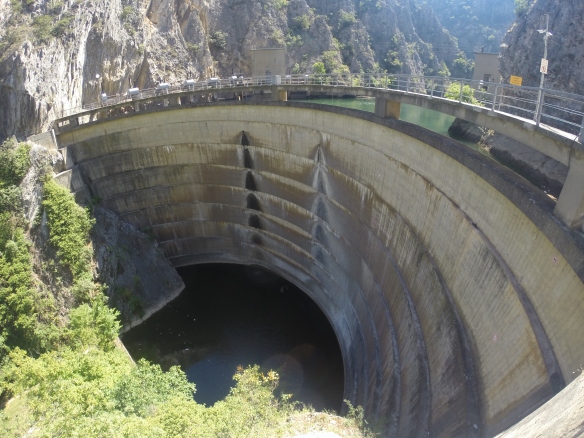 It turned out that the dam was right round the next corner, and the kayak place five minutes further up. As we were changing out of the motorbike clothes, a security guard, presumably from the dam, walked past, and I asked him whether it was OK to park the bike there. He gave me a thumbs up and pointed to a security camera I had not seen.
It turned out that the dam was right round the next corner, and the kayak place five minutes further up. As we were changing out of the motorbike clothes, a security guard, presumably from the dam, walked past, and I asked him whether it was OK to park the bike there. He gave me a thumbs up and pointed to a security camera I had not seen.
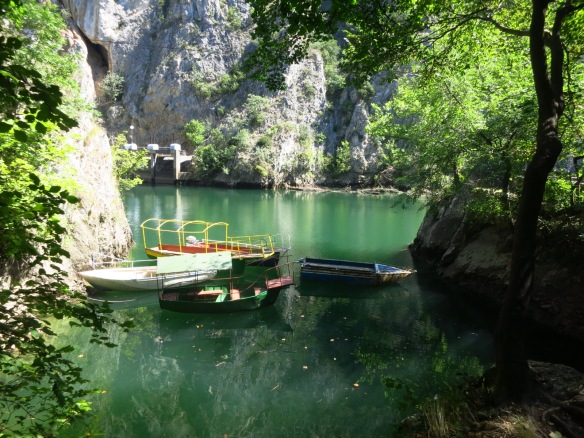 After a short walk we reached a place where the walls of the canyon opened a bit wider and found a restaurant and a small wooden hut with a flight of wooden stairs leading down to a jetty where three boats and several plastic kayaks were moored. They told us that two hours were enough to reach the caves, visit them and come back by kayak, and that they also offered tours by boat. Seeing that the kayak was only marginally more expensive and would not only last longer, but give us more freedom, we rented one.
After a short walk we reached a place where the walls of the canyon opened a bit wider and found a restaurant and a small wooden hut with a flight of wooden stairs leading down to a jetty where three boats and several plastic kayaks were moored. They told us that two hours were enough to reach the caves, visit them and come back by kayak, and that they also offered tours by boat. Seeing that the kayak was only marginally more expensive and would not only last longer, but give us more freedom, we rented one.
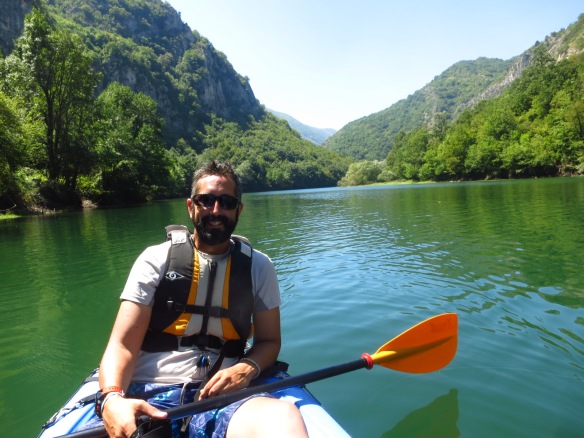 This was the third time that Nat and I used a kayak, and I am happy to say that after being able to go on shopping trips to IKEA without getting into an argument, managing to row a kayak in a straight line without shouting insults at each other is a clear sign that our relationship is solid.
This was the third time that Nat and I used a kayak, and I am happy to say that after being able to go on shopping trips to IKEA without getting into an argument, managing to row a kayak in a straight line without shouting insults at each other is a clear sign that our relationship is solid.
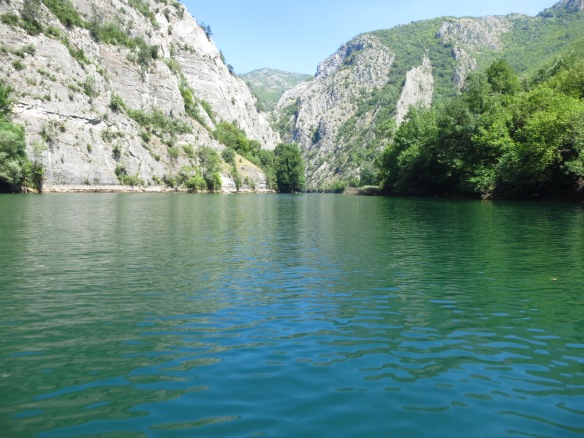 The journey through the canyon to the cave provided great sights, and we reached our destination faster than we were expecting. After some amateurish manoeuvring, I tied the kayak to the stairs that led to the cave and we got off just as a boat with a small group was also arriving.
The journey through the canyon to the cave provided great sights, and we reached our destination faster than we were expecting. After some amateurish manoeuvring, I tied the kayak to the stairs that led to the cave and we got off just as a boat with a small group was also arriving.
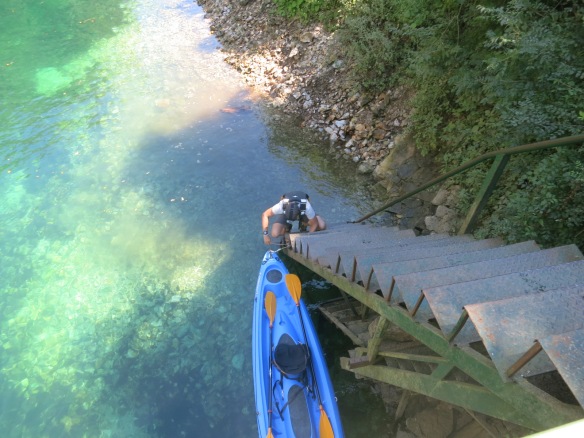 That was quite good timing, as we had no flashlights and the guy in the kayak hut had told us that the caves were illuminated but the generator was only turned on by the guides on the boats. We joined the group and profited from light and a short explanation.
That was quite good timing, as we had no flashlights and the guy in the kayak hut had told us that the caves were illuminated but the generator was only turned on by the guides on the boats. We joined the group and profited from light and a short explanation.
The caves were amazing, and it seems that there is a lot more underwater, at least three other caves from what we were told. Not everything has been explored, and they said that it might be the deepest underwater cave in the world. I can only imagine how claustrophobic it might be to dive in those conditions, swimming forward into the unknown through narrow gaps knowing that there is no air to float up to if something goes wrong.
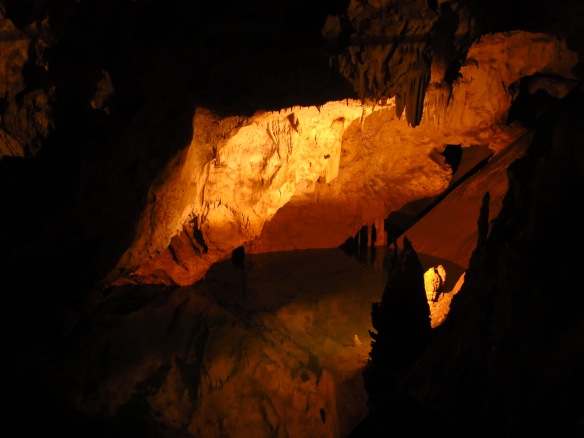 We took the way back a lot easier, knowing that we had time to spare, and when we reached the hut they told us that the short journey across the canyon to the other shore, from which a path went up the mountain and to a church, was free for customers who had rented a kayak, so we took the chance to go visit the church. When we got off the boat after the short crossing, the guy warned us about the steep walk in the midday heat and pointed at a metal plate and a hammer hanging from a tree and told us to bang on it to call for the boat back.
We took the way back a lot easier, knowing that we had time to spare, and when we reached the hut they told us that the short journey across the canyon to the other shore, from which a path went up the mountain and to a church, was free for customers who had rented a kayak, so we took the chance to go visit the church. When we got off the boat after the short crossing, the guy warned us about the steep walk in the midday heat and pointed at a metal plate and a hammer hanging from a tree and told us to bang on it to call for the boat back.
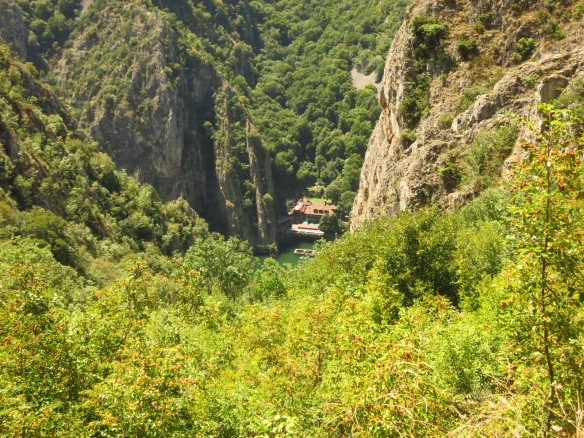 I am a keen hiker, but I almost had a heart attack on the walk up to the church on that heat… at least the visit was worth it, the church was on a small col where there was also a fountain and what seemed to be some picnic and camping facilities for the people who were hiking the trail that reached the canyon from Skopje, about 16km across the mountain.
I am a keen hiker, but I almost had a heart attack on the walk up to the church on that heat… at least the visit was worth it, the church was on a small col where there was also a fountain and what seemed to be some picnic and camping facilities for the people who were hiking the trail that reached the canyon from Skopje, about 16km across the mountain.
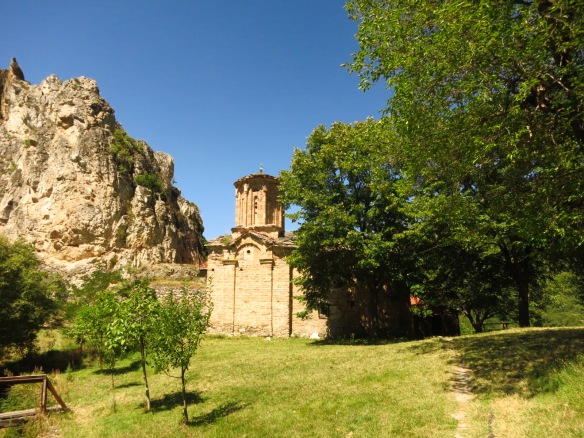 We made our way back down, I stopped to collect my underpants, which had got wet in the kayak and I had left drying in the sun on the way up, and when we reached the shore I used the high tech intercom to call the boat.
We made our way back down, I stopped to collect my underpants, which had got wet in the kayak and I had left drying in the sun on the way up, and when we reached the shore I used the high tech intercom to call the boat.
The GPS took us on a much more direct route back to the city in the afternoon, which I imagine was the one Goran was telling me about the day before, and we went back to the same restaurant for a very late lunch, since the service and the food had been excellent the previous day. There we had a long chat with Ace, our waiter, who told us he was volunteering to help the flood victims, and complained that aid was being distributed unequally depending on the political party the victims were members of. If you are in Skopje, do not miss this restaurant – Etno Bar Grill, by the river in the centre.
6th gear
Day 19 – Tuesday 16th August – Skopje to Blagoevgrad (225km)
Today was – maybe for the first time in a while – a rather quiet day regarding visits, excursions and exploration. We rode up the hills on the south of Skopje before leaving the city to see the sights from the Millennium cross, a huge 66-metre high cross built to commemorate 2,000 years of Christianity. To our disappointment, the cross could only be reached by cable car, not by road, but there was a good viewpoint from the car park where the road ended and we had a beautiful view of the city that added one more item to the list of places my impressions of Skopje drank from – Barcelona seen from the hills of Collserola.
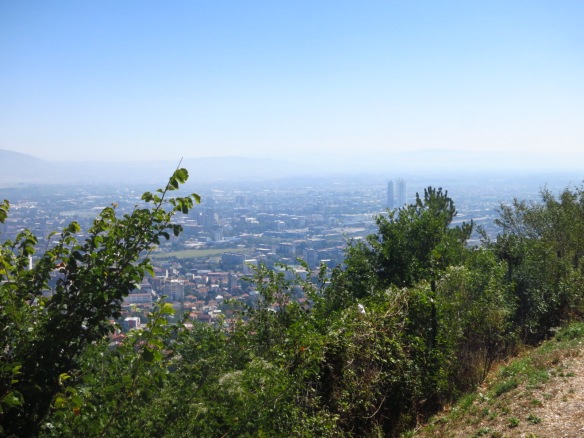 We left the city via the motorway and on the dashboard I saw something I had not seen in quite a while – 6th gear! We covered quite a lot of (boring) distance before running out of motorway, which by the way was not in great condition for what it cost us in tolls. The motorway ended in Kumanovo and from there a regular road, culminating in a really nice stretch of long sweeping corners up a hill, took us to the border with Bulgaria.
We left the city via the motorway and on the dashboard I saw something I had not seen in quite a while – 6th gear! We covered quite a lot of (boring) distance before running out of motorway, which by the way was not in great condition for what it cost us in tolls. The motorway ended in Kumanovo and from there a regular road, culminating in a really nice stretch of long sweeping corners up a hill, took us to the border with Bulgaria.
Of all the borders we had crossed I was expecting this one to be by far the easiest and fastest – leaving a country usually takes no more than a couple of minutes and then we were re-entering the EU with EU passports and an EU registered vehicle with EU insurance, but for some unknown reason the Macedonians took ages to check each of the few cars on the queue and their occupants paperwork, and it was even worse on the Bulgarian side. I was tempted to do that thing you see in movies, where whenever Americans are abroad they shout ‘I am an American citizen!’ at the first sign of bother, and start shouting ‘I am a EU citizen, let me in!’
Once on the other side we still had quite a way to go before our chosen destination – Blagoevgrad, a small city located between the natural parks of Rila and Pirin. At first this was only a one-stop place before we could find information about the area and decide where to go next, but the hotel turned out to be really nice and cheap, and we saw that the trek we wanted to do the following day was only about an hour away, so we decided to stay a couple of nights.
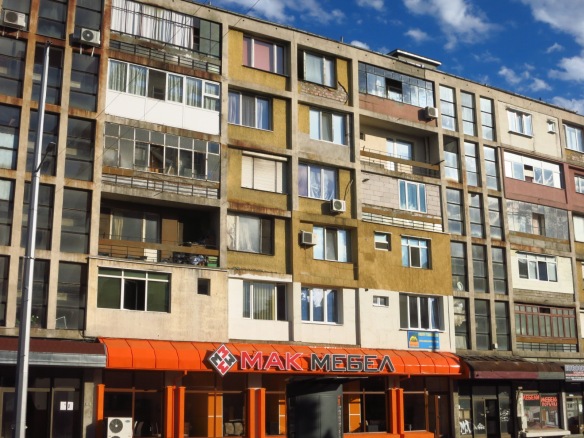 In the afternoon we went to visit the city and get some provisions for the trek, and Nat got another good dose of working-class Eastern European neighbourhoods.
In the afternoon we went to visit the city and get some provisions for the trek, and Nat got another good dose of working-class Eastern European neighbourhoods.
Eight lakes and a peak
Day 20 – Wednesday 17th August – From Blagoevgrad to Panichishte and back (165km)
So far on this trip we had spent time on the beach, on boats and ferries, kayaking, and sightseeing, and now we wanted to do a bit of hiking in Bulgaria, a country which, with its many national parks, provided the perfect opportunity, but as you can imagine, travelling by motorbike does not allow us to carry much gear, so we were a bit limited in our ambitions. After some research we found a very popular route – the trek of the seven lakes in Rila natural park.
The route starts from a ski lift some kilometres past the village of Panichishte, part of a ski station that works as a bike park in the summer. You can either take the chair lift to Rilski Ezera Hut, where the trek begins, or walk up from the car park, which adds between one and a half and two hours to the five to six hours it takes to visit all seven lakes.
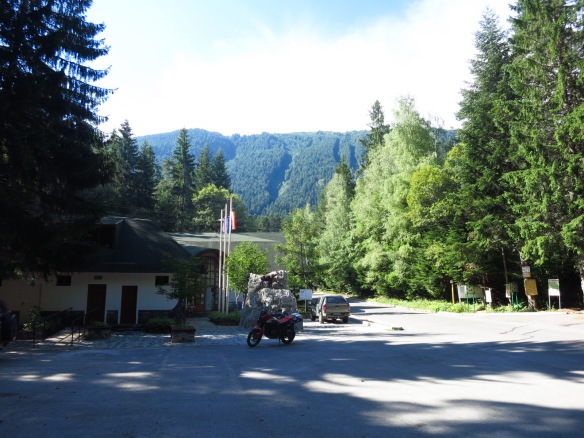 It was clear that this was a very popular site when we started seeing cars parked on the side of the road a good while before we reached the car park, for which you had to pay. As we approached the guy charging the cars he said ‘moto free’ and waved us past, and when we got to the end of the car park, the man who was at the chair lift turnstile signalled to us to park the bike just past the lift building, where the staff cars and the snow cats were. Once again, it’s a pleasure to travel by bike.
It was clear that this was a very popular site when we started seeing cars parked on the side of the road a good while before we reached the car park, for which you had to pay. As we approached the guy charging the cars he said ‘moto free’ and waved us past, and when we got to the end of the car park, the man who was at the chair lift turnstile signalled to us to park the bike just past the lift building, where the staff cars and the snow cats were. Once again, it’s a pleasure to travel by bike.

The chair lift is worth taking not only for the time it saves, allowing you to spend more time on the lakes trek, but also for the views it offers over the valley as it climbs higher and higher. Once we reached the hut we understood why we had read that it was impossible to get lost on this trek – not only was there a long line of people slowly creeping up the mountain, but the path itself was well trodden and impossible to miss.
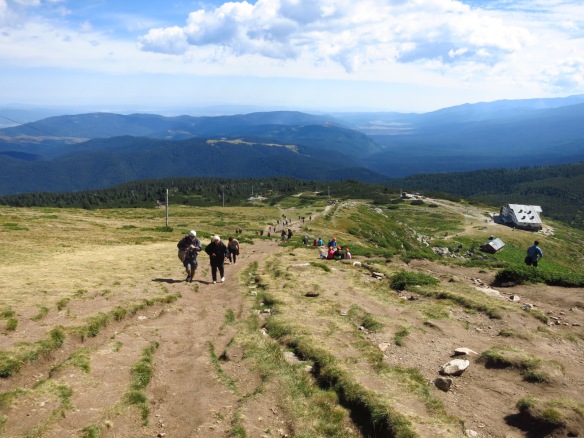 We started the trek counter clockwise, as most people did, walking on a steep path with a drop to the left from where we soon had a view of the two last lakes and another hut, this one bigger and surrounded by hundreds of tents.
We started the trek counter clockwise, as most people did, walking on a steep path with a drop to the left from where we soon had a view of the two last lakes and another hut, this one bigger and surrounded by hundreds of tents.
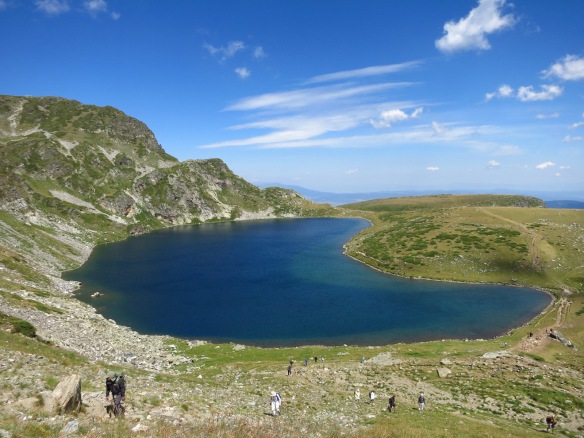 The path levelled off on a grass plain where we saw the first lake, called Babreka (the kidney), and also a big group of people standing in a circle engaged in some kind of activity that I could not tell – it might have been yoga, it might have been some sort of ritual, but to me it mostly looked as if they were trying to strangle themselves.
The path levelled off on a grass plain where we saw the first lake, called Babreka (the kidney), and also a big group of people standing in a circle engaged in some kind of activity that I could not tell – it might have been yoga, it might have been some sort of ritual, but to me it mostly looked as if they were trying to strangle themselves.
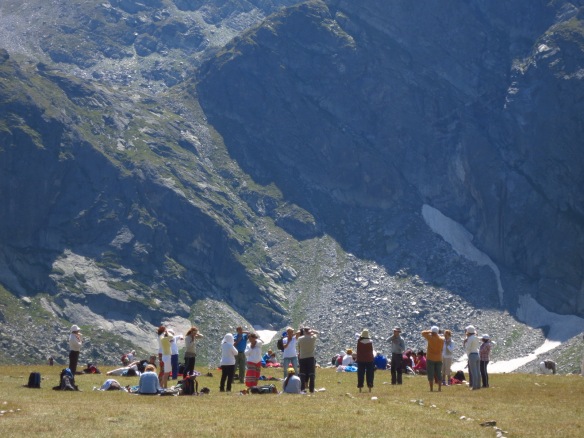 That, and the fact that they were standing in he middle of huge concentric circles marked on the ground reminded me that I has seen a book for sale in a road café a few kilometres before the chair lift titled ‘The Esoteric Guide to the Sacred Rila Lakes’. After that I started seeing that among the many tourists walking around there were a fair number of people rather peculiarly dressed, as if they had just come back from a year of meditation in some remote monastery or had teleported across time and space from Woodstock.
That, and the fact that they were standing in he middle of huge concentric circles marked on the ground reminded me that I has seen a book for sale in a road café a few kilometres before the chair lift titled ‘The Esoteric Guide to the Sacred Rila Lakes’. After that I started seeing that among the many tourists walking around there were a fair number of people rather peculiarly dressed, as if they had just come back from a year of meditation in some remote monastery or had teleported across time and space from Woodstock.
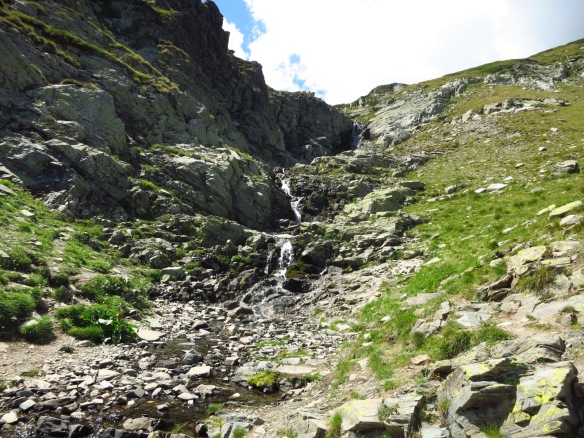 Just past this curious sight the path started climbing steeply until we found the second lake, Okoto (the eye), called like that because it forms a perfect oval. There we should have turned left and continue climbing to a high rock outcrop on the top of which we could see even more people, their silhouettes cut out against the sky, but I saw another path that went right and probably led to a peak we could see not far away. We had reached the second highest lake sooner than expected, the day was glorious and I thought ‘why not?’ and we started the climb.
Just past this curious sight the path started climbing steeply until we found the second lake, Okoto (the eye), called like that because it forms a perfect oval. There we should have turned left and continue climbing to a high rock outcrop on the top of which we could see even more people, their silhouettes cut out against the sky, but I saw another path that went right and probably led to a peak we could see not far away. We had reached the second highest lake sooner than expected, the day was glorious and I thought ‘why not?’ and we started the climb.
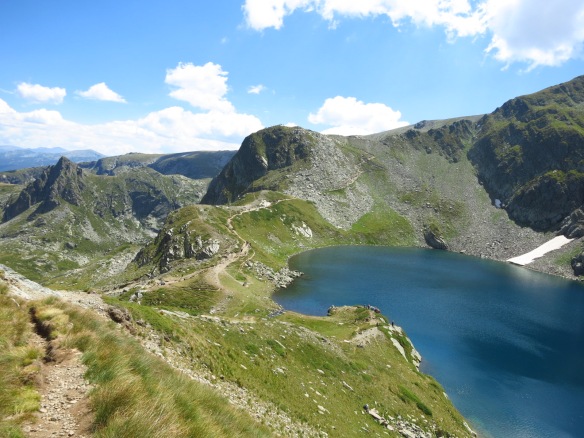 An hour later and 300m higher, we were standing on top of a mountain with 360 degree views over the whole park. My altimeter read 2714 metres, and later I found that we were on a peak called Rilec. From there we had the privilege to see an eighth lake on the other side of the mountain that most people doing the route don’t see.
An hour later and 300m higher, we were standing on top of a mountain with 360 degree views over the whole park. My altimeter read 2714 metres, and later I found that we were on a peak called Rilec. From there we had the privilege to see an eighth lake on the other side of the mountain that most people doing the route don’t see.
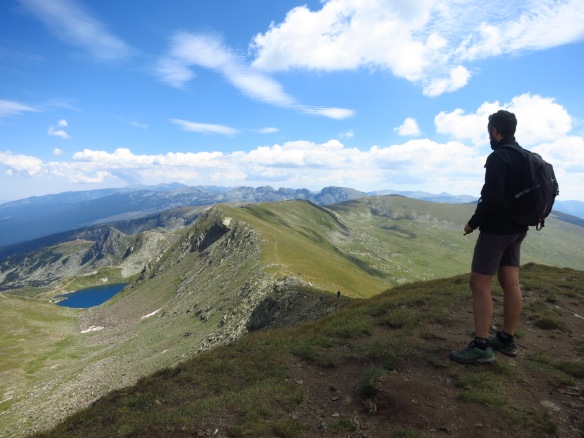 We went down to lake Okoto again and climbed the outcrop, from where we saw the third and highest lake in the trek – lake Salzata (the tear), and had a view of all seven lakes at once. We had lunch there, contemplating the views and chatting to a Bulgarian family that lived in Pamplona and had come back to their country on holidays.
We went down to lake Okoto again and climbed the outcrop, from where we saw the third and highest lake in the trek – lake Salzata (the tear), and had a view of all seven lakes at once. We had lunch there, contemplating the views and chatting to a Bulgarian family that lived in Pamplona and had come back to their country on holidays.
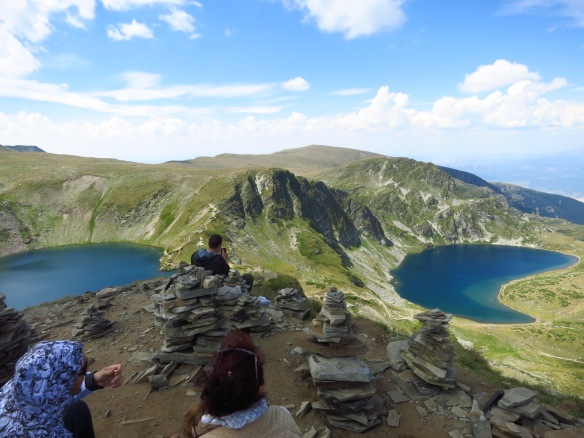 After climbing down to the point where the waterfall coming from Okoto met the stream coming from Babreka and turned right to go back to the chair lift via the remaining four lakes – Bliznaka (the twin), Trilistnika (the trefoil), Ribnoto Ezero (the fish lake) and Dolnoto Ezero (the lower lake).
After climbing down to the point where the waterfall coming from Okoto met the stream coming from Babreka and turned right to go back to the chair lift via the remaining four lakes – Bliznaka (the twin), Trilistnika (the trefoil), Ribnoto Ezero (the fish lake) and Dolnoto Ezero (the lower lake).
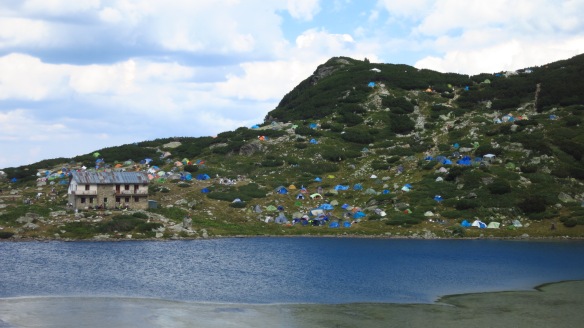 As we passed the hut we had seen from the distance on the way up, by the shore of Ribnoto Ezero, we got a better view of the number of tents that had been put up around it. You could count hundreds of them, sprawling around the hut and up the slope on the opposite side of the lake. On the way to the chair lift we came across more people walking up carrying tents, clearly with the intention to camp there as well, but not looking like the kind of person who is there to hike at all. Most of them were ill-equipped for the mountain, both in terms of clothing and footwear, and I wondered if it had something to do with the book I mentioned before and the people performing that circle-yoga-meditation thing. Maybe this area was considered to have some kind of healing powers, or it was a UFO sighting spot…
As we passed the hut we had seen from the distance on the way up, by the shore of Ribnoto Ezero, we got a better view of the number of tents that had been put up around it. You could count hundreds of them, sprawling around the hut and up the slope on the opposite side of the lake. On the way to the chair lift we came across more people walking up carrying tents, clearly with the intention to camp there as well, but not looking like the kind of person who is there to hike at all. Most of them were ill-equipped for the mountain, both in terms of clothing and footwear, and I wondered if it had something to do with the book I mentioned before and the people performing that circle-yoga-meditation thing. Maybe this area was considered to have some kind of healing powers, or it was a UFO sighting spot…
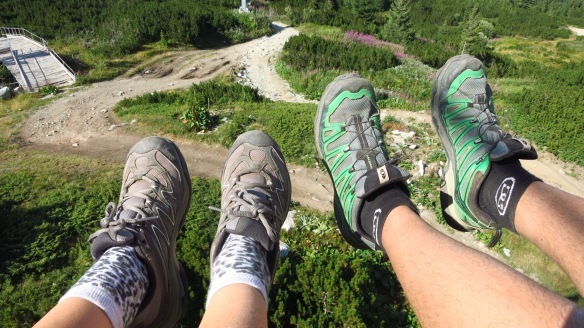 We took the chairlift back to the motorbike, glad to have chosen this option, as it had given us enough time to climb peak Rilec, and started heading back to Blagoevgrad. We took a detour on the way back because we wanted to visit the Rila monastery, which we had heard is the biggest in the country. The problem was that we had not researched where it was exactly, road signs in this part of the world are between few and none and people in small villages don’t speak any English, so after riding up a valley past the town of the same name for a while and not finding it, we decided to turn back and head for the city, as it was getting late and we needed to find an open supermarket to buy some food for the following day.
We took the chairlift back to the motorbike, glad to have chosen this option, as it had given us enough time to climb peak Rilec, and started heading back to Blagoevgrad. We took a detour on the way back because we wanted to visit the Rila monastery, which we had heard is the biggest in the country. The problem was that we had not researched where it was exactly, road signs in this part of the world are between few and none and people in small villages don’t speak any English, so after riding up a valley past the town of the same name for a while and not finding it, we decided to turn back and head for the city, as it was getting late and we needed to find an open supermarket to buy some food for the following day.
While Nat was doing the shopping I stayed with the motorbike and as I was waiting a small kid came, ogling at the bike. He did not understand a single word I tried to tell him, and I did not understand what he was asking, but the love for motorbikes is a universal language, particularly among kids, and he was delighted when I sat him on it and let him fiddle with the horn and indicators. When Nat came back with the shopping I showed him which button to press to turn the engine on – you should have seen the look on his face when he pressed it and the engine roared to life. It probably made his day, week and even year. I hope things turn out well in life for him and one day he can ride his own bike.
Ghost town
Day 21 – Thursday 18th August – From Blagoevgrad to Rila to Bansko (135km)
We were going to move to a different town to be closer to Pirin natural park, but as once again we did not have much information about treks there yet we knew that we would not be going into the mountains today. That, and the fact the town we were going to was only about an hour away, made us decide to go back to Rila in the morning and try to visit the monastery before heading there.
This time we had done our homework, and found the monastery without any problems – it was just a matter of going further up the valley, but we did not have the time the previous day and in any case we would have found it closed.
As with the road to the chair lift, we found cars parked on the road a while before reaching the monastery, but when we got a policeman let us park the bike by the side of the road on the corner of the building. We saw that he was not the only policeman, there were quite a lot of them, as well as private security guards and several vans with satellite dishes belonging to TV channels.
 I asked about it and it turned out that the most important religious leader in the country – bishop, archbishop, pope… I don’t remember – was giving mass that day, and the president of Bulgaria was there as well.
I asked about it and it turned out that the most important religious leader in the country – bishop, archbishop, pope… I don’t remember – was giving mass that day, and the president of Bulgaria was there as well.
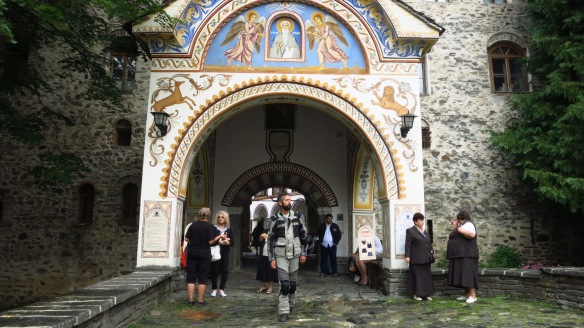 Fortunately, aside from the police and media presence, the monastery was not particularly full, so we quite enjoyed the visit. Walking through the main archway and into the courtyard, the contrast between the tall outer stone walls, which are almost like those of a fortress, and the painted arches that sustain the different residential levels is stunning.
Fortunately, aside from the police and media presence, the monastery was not particularly full, so we quite enjoyed the visit. Walking through the main archway and into the courtyard, the contrast between the tall outer stone walls, which are almost like those of a fortress, and the painted arches that sustain the different residential levels is stunning.
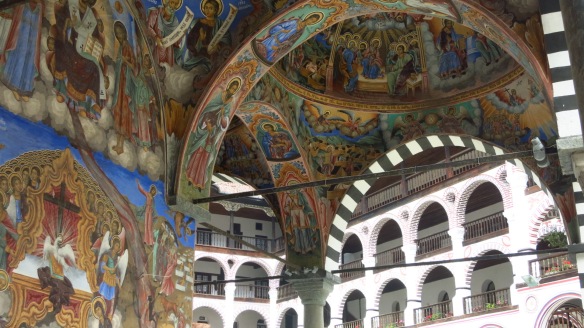 I knew this was the biggest monastery in the country and one of its main tourist attractions, but I must confess that it exceeded my expectations.
I knew this was the biggest monastery in the country and one of its main tourist attractions, but I must confess that it exceeded my expectations.
 After the visit we headed down the valley back to the Blagoevgrad area and the heat, and then up into the mountains again, this time to Pirin national park, glad for the cool air.
After the visit we headed down the valley back to the Blagoevgrad area and the heat, and then up into the mountains again, this time to Pirin national park, glad for the cool air.
We had found accommodation in some sort of ski resort hotel in Bansko, which we had chosen because it was said to be the main gateway to the natural park. As we approached the town, we kept seeing countless billboards advertising not only spas and sports shops, but casinos and nightclubs. Not my kind of place…
We reached the hotel, parked the bike and walked into the reception area, with people looking at us as if we were aliens. There we were, helmets in hand, riding trousers and jacket, sweating the summer heat while guests wearing all-inclusive bracelets walked past us with a cocktail in their hands, heading for the pool area where loud pop music blared out of the speakers. This was definitely not the place for bikers nor for hikers, but hey, it was ridiculously cheap, breakfast, dinner and drinks were included in the price and we had a small studio all to ourselves.
In the afternoon we walked to the centre to try to find information about the trekking routes in the park, and were surprised to see how empty it was. Aside from four or five big hotels like ours, which offered cut-price all inclusive deals to attract customers in the summer, the rest of the town was dead. We saw streets full of hotels, restaurants, ski rental shops, bars, night clubs, casinos, shopping malls, even a sex shop and a strip club… all closed. Only a few sports and souvenir shops remained open in the centre, with very bored looking workers behind the counter. The ski station beyond the town looked enormous, so I am sure that all this facilities must cater for a huge number of people during the skiing season, but I had never seen such contrast before. We could not even find an open supermarket, and in the end we bought a few things to take to the mountain the following day in a small overpriced grocery store. What do people who live here eat?
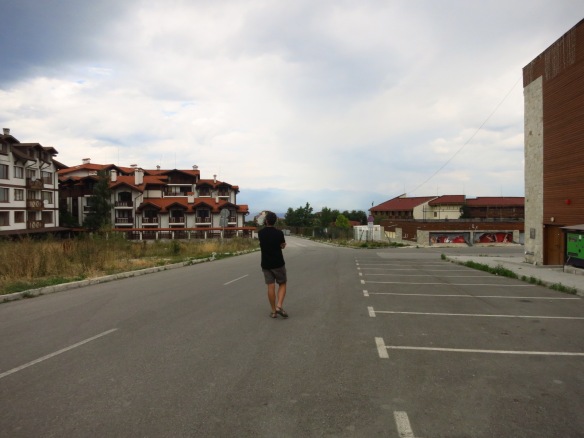 We also found the tourist information office, where they told us about another lake trek and the highest peak in the park, mount Vihren, which is the second tallest mountain in Bulgaria. Our intention was to climb it the following day, but the weather forecast did not loot good.
We also found the tourist information office, where they told us about another lake trek and the highest peak in the park, mount Vihren, which is the second tallest mountain in Bulgaria. Our intention was to climb it the following day, but the weather forecast did not loot good.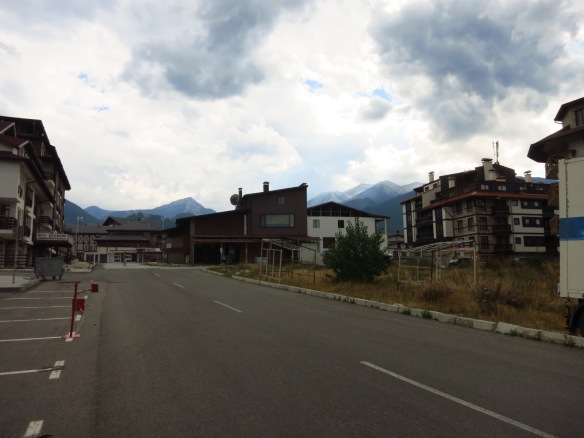
Lakes, rain and hail
Day 22 – Friday 19th August – From Bansko to Vihren hut and back (32km)
The weather forecast turned out to be accurate and the following morning the sky was overcast and we could not even see the mountains up the valley. Every ten minutes or so there were strong showers, so we had breakfast and sat in the front terrace of the hotel to read a while, write a while and generally kill the time waiting for the weather to improve a bit so that we could at least ride to Vihren hut, 16km up the mountain, and see the lakes.
By midday the rain finally gave us a break and we quickly got on the bike and rode up as some blue patches opened in the sky. We reached the hut through a beautiful mountain road and were surprised to find quite a lot of cars parked there despite the rain.
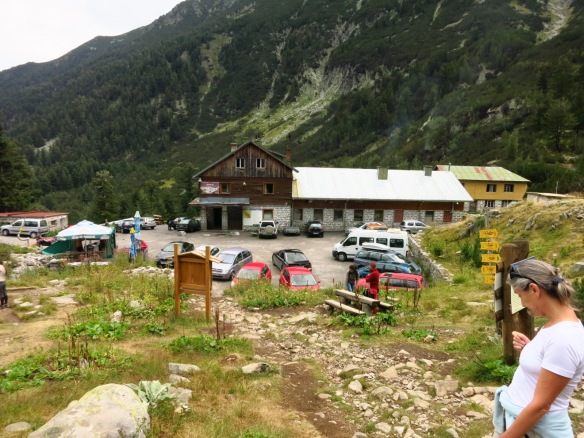 We started walking to see at least the first two lakes, which were an half an hour and an hour and a half away respectively; the mountains looked higher and with a sharper profile there, the park felt more serious than Rila.
We started walking to see at least the first two lakes, which were an half an hour and an hour and a half away respectively; the mountains looked higher and with a sharper profile there, the park felt more serious than Rila.
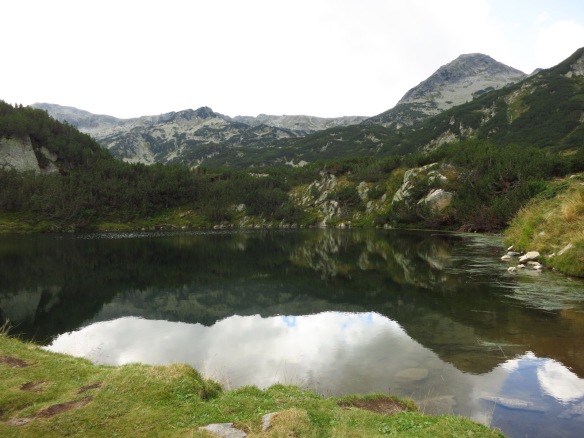 We reached the first lake, also called Otoko, which was rather small, and went on the second one with clouds closing in around us again. By the time the second lake was in sight we could hear thunder over the mountains, so we just took a couple of pictures and started heading back to the hut.
We reached the first lake, also called Otoko, which was rather small, and went on the second one with clouds closing in around us again. By the time the second lake was in sight we could hear thunder over the mountains, so we just took a couple of pictures and started heading back to the hut.
The rain started before we had even reached the first lake, and we got soaked in five minutes. By the time we reached the hut it was pouring down and there was even some hail. I grabbed the motorbike suit and boots, which were dry, from the panniers and got changed quickly in the hut’s porch, in full view of everyone who had taken shelter there, to avoid getting pneumonia.
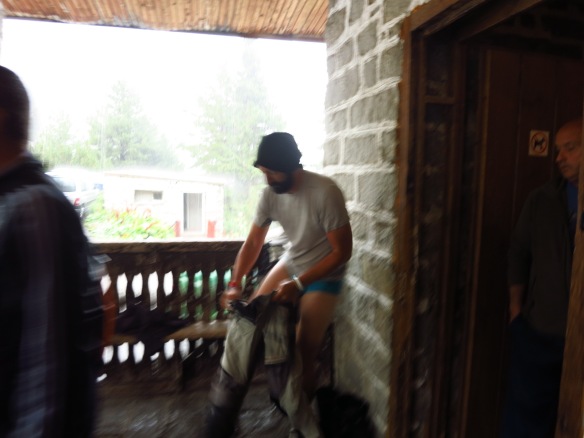 When the rain finally stopped we got back to our hotel and called it a day, sad not to have seen more of the park. One thing gave us hope, though – the following day we were going to Sofia, which was only about 150km away, and we had seen signs by the hut saying that the climb to Vihren peak took three hours. The weather was supposed to improve, so we decided to wake up really early, see if the sky was clear, and then try to climb the peak before heading to Sofia.
When the rain finally stopped we got back to our hotel and called it a day, sad not to have seen more of the park. One thing gave us hope, though – the following day we were going to Sofia, which was only about 150km away, and we had seen signs by the hut saying that the climb to Vihren peak took three hours. The weather was supposed to improve, so we decided to wake up really early, see if the sky was clear, and then try to climb the peak before heading to Sofia.
The Vihren catastrophe
Day 23 – Saturday 20th August – From Bansko to Vihren hut to Sofia (189km)
At 6:00 the sky was already blue and after leaving a couple of bags at reception we checked out and headed straight for Vihren hut. There were already several cars parked in front of it, and more came as we got changed and started the walk up Vihren peak.
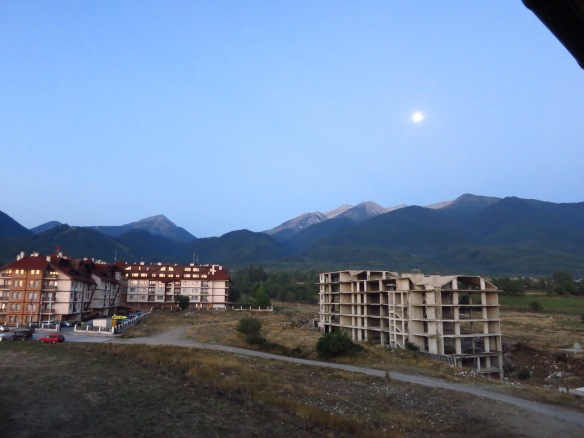 The sun came out over the high mountains as we gained altitude through a well trodden path, but nothing as touristy as the seven lake trek in park Rila.
The sun came out over the high mountains as we gained altitude through a well trodden path, but nothing as touristy as the seven lake trek in park Rila.
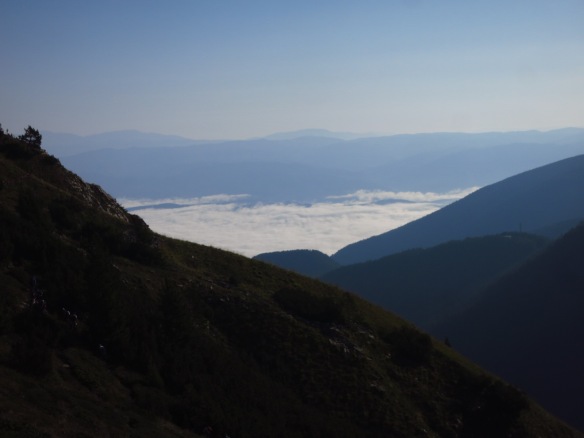 Even though this was a relatively easy peak – the way was clearly indicated in red marks and there was not need to climb at all, just walk to the summit – the way the path gained altitude was unforgiving. It went straight up right after setting off from the hut, and it kept going that way for most of the 900m ascent.
Even though this was a relatively easy peak – the way was clearly indicated in red marks and there was not need to climb at all, just walk to the summit – the way the path gained altitude was unforgiving. It went straight up right after setting off from the hut, and it kept going that way for most of the 900m ascent.
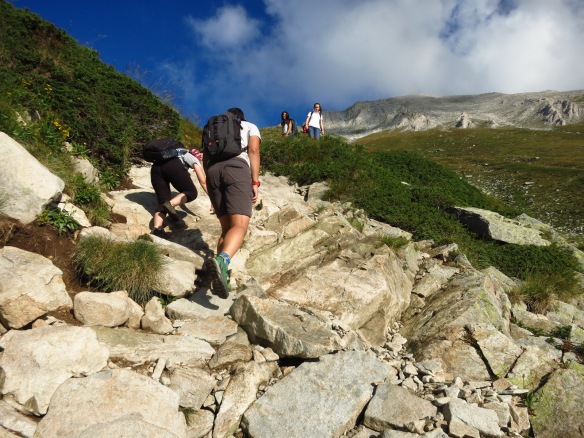 We reached the col before the peak in good time, having passed several groups of people who had started earlier but were making slower progress, and from there we saw that the peak was covered in clouds.
We reached the col before the peak in good time, having passed several groups of people who had started earlier but were making slower progress, and from there we saw that the peak was covered in clouds.
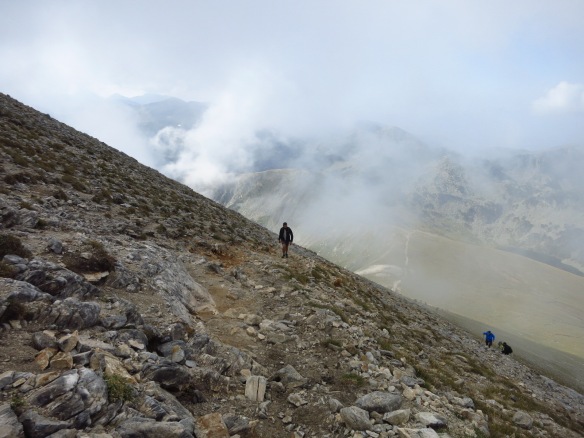 Fortunately, they were not think enough to be a visibility problem, and we could still follow the trail to the top. We reached it in two hours sharp, an hour less than the sign in the hut said.
Fortunately, they were not think enough to be a visibility problem, and we could still follow the trail to the top. We reached it in two hours sharp, an hour less than the sign in the hut said.
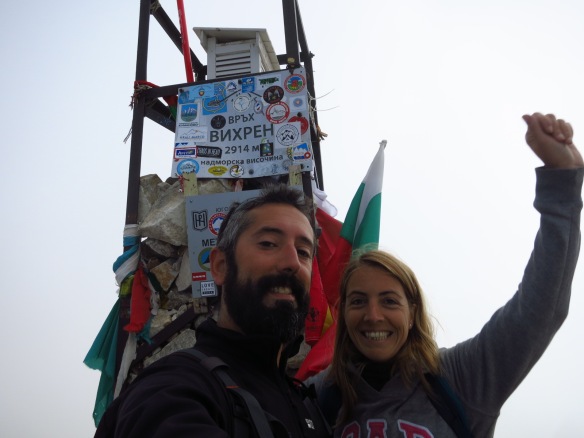 The temperature was a lot lower there, and it was quite windy, so we just took a few pictures, had a snack and glimpsed at the views through the occasional gap in the clouds.
The temperature was a lot lower there, and it was quite windy, so we just took a few pictures, had a snack and glimpsed at the views through the occasional gap in the clouds.
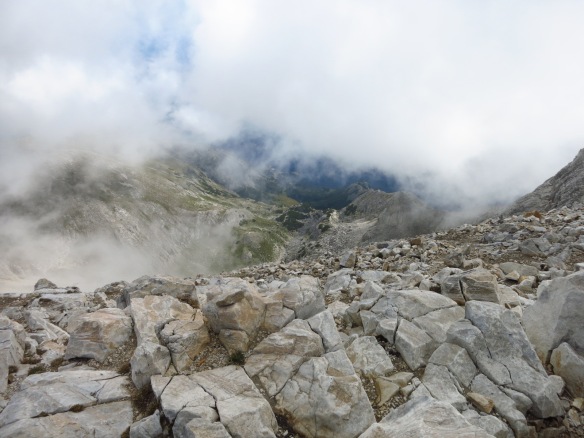 The way down was even faster, and we only stopped two or three times to takes clothes off as the temperature rose again during the descent into the valley. We were surprised by the high number of people that kept coming up the opposite way – this was clearly a popular peak, but I have seldom seen people starting a climb so late. Not only was it way too hot on the way up at this time, but there were clouds gathering over the surrounding mountains, and the weather can change very quickly in the afternoon in the mountains. We had started walking at 8:30, and there were very few people ahead of us. If you start walking at that time in the Pyrenees, you are likely to be among the last.
The way down was even faster, and we only stopped two or three times to takes clothes off as the temperature rose again during the descent into the valley. We were surprised by the high number of people that kept coming up the opposite way – this was clearly a popular peak, but I have seldom seen people starting a climb so late. Not only was it way too hot on the way up at this time, but there were clouds gathering over the surrounding mountains, and the weather can change very quickly in the afternoon in the mountains. We had started walking at 8:30, and there were very few people ahead of us. If you start walking at that time in the Pyrenees, you are likely to be among the last.
When we reached the hut I checked my watch to see what time we had made – four hours total, up and down. It was a great time, and I reached into my backpack to get the GoPro out and take a picture of the time on the watch with the hut as background. I rummaged about and was not able to find it. I emptied the whole backpack, turned all pockets inside out, and realised, to my horror, that the camera was not there.
I remembered that I had taken the last picture on the col, right after coming down the rocky slope from the peak, and after we had only stopped once – the first time I put my neck warmer into the bag, the second time Nat took out some stuff to get some tissues. Either I had left the camera on a rock on the first occasion, or it had fallen out of the bag on the second. Most likely the latter.
That had happened about 300m above the hut, so without thinking twice, I told Nat to wait for me and went running back up the mountain. I reached the spot a while later, covered in sweat and out of breath, hoping to find the camera lying on the ground, as it was a bit off the main path, but it was not there. The other place where we had stopped was much higher, almost two thirds of the way up to the peak, and that time it had been right on the path, so the chances of finding it were slim… However, I did not want to go back without trying, not because of the camera itself, I could always buy another one, but because the SD card in it contained many of the pictures and videos of our holiday so far.
After catching my breath for a moment, I went on running up until I reached the other spot, but the camera was not there either. Defeated, I started to walk down the mountain, still fast, because Nat thought that I had only gone up the lowest spot and I guessed she might be starting to worry that I was taking so long.
I reached the hut exhausted, having passed people up to three times – on the normal way down, then running up for the camera, then running down again – I don’t know what they might have thought I was doing. All in all, I had climbed 1600m, lost all the time advantage we had gained when we first came down to the hut and now we had to pack things up and ride all the way to Sofia.
With our mood at an absolute minimum, we picked our stuff from the hotel and left Bansko. Nat was feeling very sad about the pictures, and I kept trying to make light of it and telling her not to worry, but between the stifling heat down at the Blagoevgrad valley, my state of exhaustion and the ride ahead of us, I snapped at her when we stopped at a petrol station. I felt miserable about it for the rest of the way into Sofia.
With such a mood, our first impression of the city was not the best one, not helped by the fact that we entered through what I later learned was the ‘gypsy neighbourhood’, where we saw street after street of people carrying waste in donkey carts and cars half dismantled every two corners.
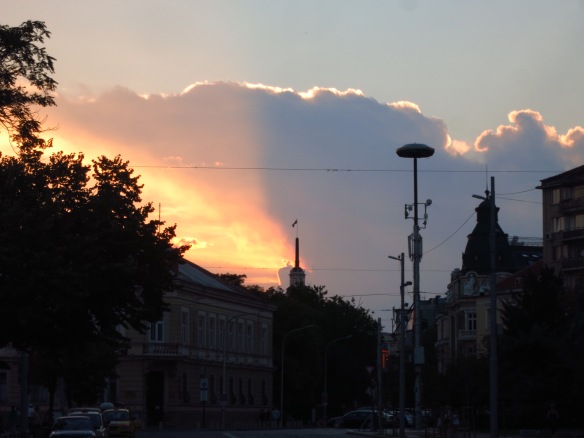 Things started to improve a bit by the time we reached, our hotel, saw the room, had a shower and went to see the famous Alexander Nevsky cathedral in the sunset. By the time we had found a nice grill restaurant, had a marvellous meal and two gin and tonics for dessert, we were finally smiling again.
Things started to improve a bit by the time we reached, our hotel, saw the room, had a shower and went to see the famous Alexander Nevsky cathedral in the sunset. By the time we had found a nice grill restaurant, had a marvellous meal and two gin and tonics for dessert, we were finally smiling again.
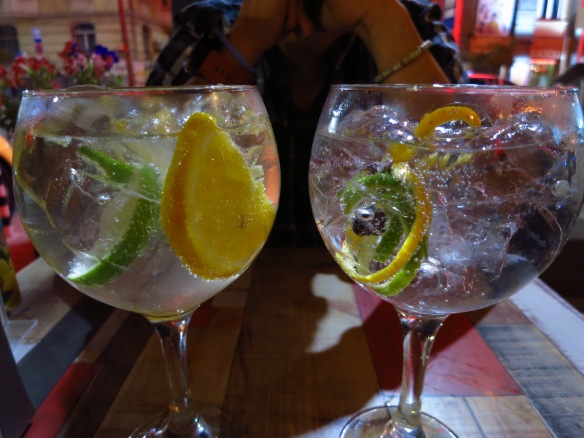
Departures
Day 24 – Sunday 21st August – From Sofia to Sofia Airport and back (12.6km)
Sofia is a very nice city, but as a capital city we did not enjoy it as much as Skopje. Maybe it was because we had no expectations for Skopje and it surprised us, maybe it was because we were still feeling a bit down after having lost the camera and the pictures, but I guess that it was mostly down to the fact that in the afternoon Nat was taking the plane back to Barcelona. Her holidays were over, she had to be back at work the following morning.
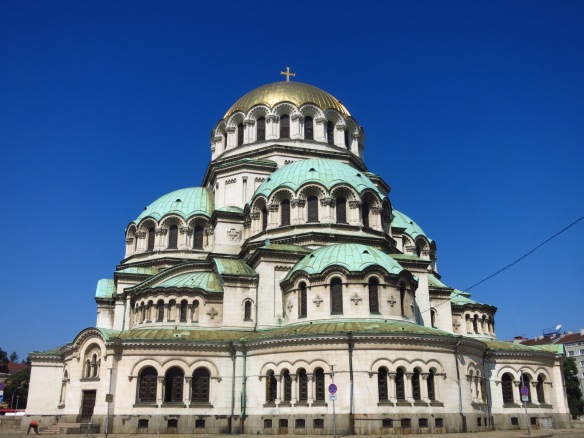 She kept telling me that now it was time for me to have all the fun on my own and go truly adventure riding, but we had had three wonderful weeks together and I felt we had seen all that we had set out to see. I was meeting my sister and her husband for a weekend together in Athens in a week, and I had the impression that I really did not know what to do with the days in between.
She kept telling me that now it was time for me to have all the fun on my own and go truly adventure riding, but we had had three wonderful weeks together and I felt we had seen all that we had set out to see. I was meeting my sister and her husband for a weekend together in Athens in a week, and I had the impression that I really did not know what to do with the days in between.
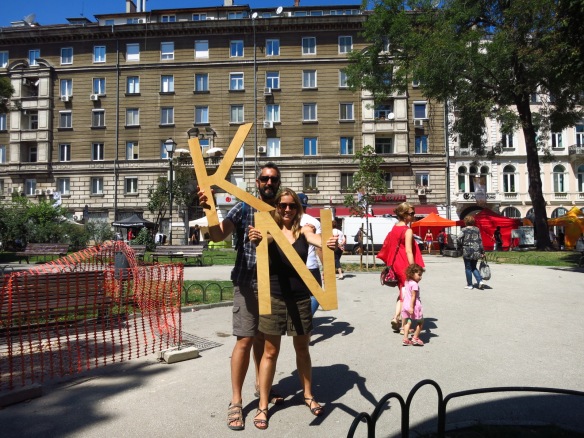 After visiting the city, I took her to the airport, we kissed goodbye and I went back to the hostel, feeling terribly empty. The room looked too big now, and I sat down to plan the route for the following day and try to write a bit.
After visiting the city, I took her to the airport, we kissed goodbye and I went back to the hostel, feeling terribly empty. The room looked too big now, and I sat down to plan the route for the following day and try to write a bit.
The Sofia miracle
Day 25 – Monday 22nd August – From Sofia to Idilevo (273km)
When I was planning this trip I saw a thread about Bulgaria in the HUBB and I asked about places to visit, since it was the country I had researched the least. Someone mentioned Doug’s Motocamp there, which sounded like a similar concept to the Biker Camp I had stayed in when I was in Budapest. I had really enjoyed that experience, so I as very keen to head into he country’s central mountains and see what it was about.
Now, the Motocamp should have been the story of the day, it did turn out to be an amazing place, if it were not for something else completely unexpected that happened in the morning long before I set off.
In fact, the story begins the night before. I was posting the blog’s articles and pictures on Facebook and I saw that I had a friend request from someone called Julian who lived in Sofia. As far as I could remember, we had not met anyone in the last few days, so I did not accept it and went on writing.
The following morning, when I grabbed my phone from the bedside table to stop the alarm clock, I saw a notification from one of those annoying apps that come with the phone and that you can not uninstall. I was about to ignore it, but then I saw it was from the same guy who had sent the Facebook request, and I got curious to see who was so insistent to contact me. I opened the message and it read ‘Hello, I think I found your camera, I’m trying to contact you through your Facebook account’.
I could not believe it. Still half asleep, I had to read it twice more before I frantically typed a reply. He asked me whether I was still in Bulgaria, and when I told him I was in Sofia, not in Bansko, he replied that he was also in the capital. He sent me an address and I saw that it was to the south of the centre, so I told him I could be there in an hour. I was still in my underpants, and so stunned that I did not even think of asking him how he had found me. I got dressed, went down to the cafeteria for a quick breakfast, loaded the bike, checked out and followed the GPS directions to his address. It was not until I was riding through the Monday morning rush hour traffic that I asked myself the question – there were no contact details on the camera itself, and the pictures and videos it contained did not mention my name at any point. Maybe the bike license plate? But how can you get someone’s name in Bulgaria using a foreign vehicle number plate? I was mystified.
When I got to the rendezvous point he was already waiting for me, and sure enough, he had my camera. I was so happy to have the pictures and videos back that I immediately launched into an endless profusion of gratitude, and once again, it took me a while to ask him the million dollar question – how did he find me?
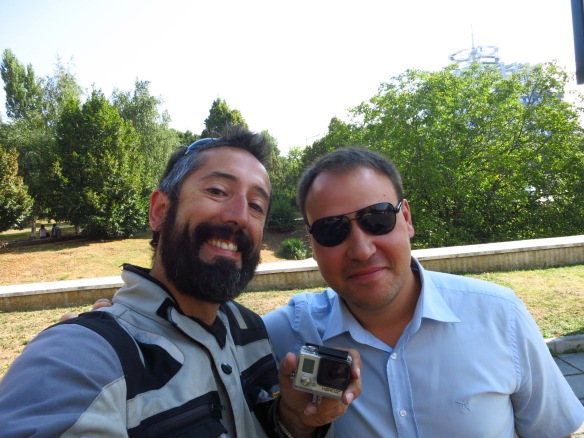 By an incredible succession of lucky events and sheer investigative talent, that’s how. He said that he had thought of leaving the camera in Vihren hut, but then he thought that whomever had lost it may already be gone from there, so he left a note with his contact number and took the camera with him to Sofia. Then he looked at the pictures to see if there was something that could help him identify the owner. Going through them, he saw that I had a badge on my riding jacket that says ‘Rider1000’, and thought that it might be some kind of club, so he googled it and found its website. As you may know if you follow this blog, the Rider1000 is an endurance riding event that consists of riding 1000km around Catalonia, and as luck would have it, the list of last edition participants was still posted on their website.
By an incredible succession of lucky events and sheer investigative talent, that’s how. He said that he had thought of leaving the camera in Vihren hut, but then he thought that whomever had lost it may already be gone from there, so he left a note with his contact number and took the camera with him to Sofia. Then he looked at the pictures to see if there was something that could help him identify the owner. Going through them, he saw that I had a badge on my riding jacket that says ‘Rider1000’, and thought that it might be some kind of club, so he googled it and found its website. As you may know if you follow this blog, the Rider1000 is an endurance riding event that consists of riding 1000km around Catalonia, and as luck would have it, the list of last edition participants was still posted on their website.
But wait a moment, you might think, he did not know your name, so how could he find you in the list? Good question. He had also seen my motorbike in the pictures, and he knew it was the new Africa Twin. On the Rider1000 participants list they post the name of the rider and the make and model of the bike, but not the license plate or any other information, so I was very lucky not only to have had my camera picked up by someone who knew enough about bikes to identify the make and model of mine, but to have that particular type of bike. You see, there were 850 people on that list, and only two had entered the event with a new Africa Twin. Thank God I hadn’t bought a GS!
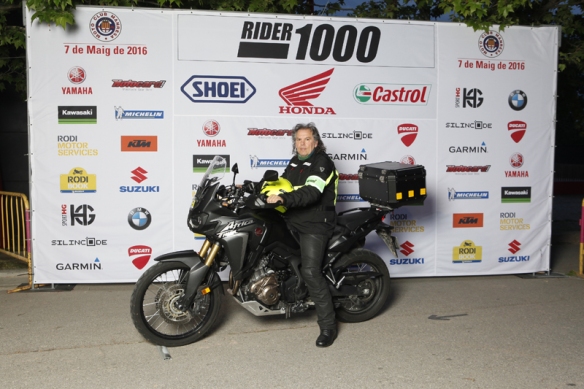
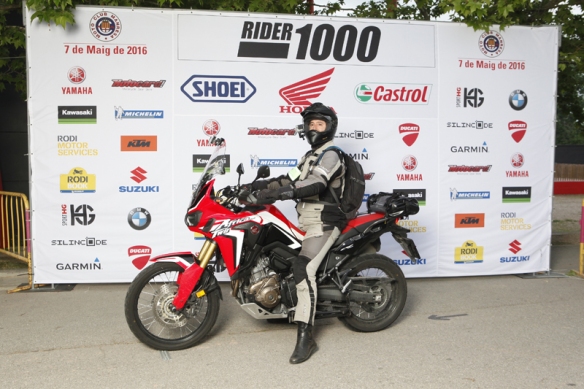 So now he had two names, and in the same website you can find the picture that is taken before the start line, with each rider on his bike in front of a sponsor board. He looked both names up and then identified me from the pictures in the GoPro. Voilà, he had my name. After that he only had to search on Facebook and he was able to contact me.
So now he had two names, and in the same website you can find the picture that is taken before the start line, with each rider on his bike in front of a sponsor board. He looked both names up and then identified me from the pictures in the GoPro. Voilà, he had my name. After that he only had to search on Facebook and he was able to contact me.
He had to go, so we did not have much of a chance to talk more, but he restored my faith in humanity for a good time to come.
But that’s not the end of the adventures of owning an AT … after he left I stayed where we had met to send a message to Nat, who was thrilled to hear the news and could not quite believe it, particularly getting such a story on a super condensed version through WhatsApp. I was sitting on the bike by the side of the road on a big avenue, with the warning lights on, fumbling with my phone, when a guy on a scooter stopped by and asked me if everything was OK. It turned out that he also had a new Africa Twin, we got talking and he told me that he lived just round the corner and invited me to see it. In the nth coincidence of the morning, when I mentioned that I was going to the Motocamp in Idilevo he told me that he had just been there the day before, he was friends with the people who run it, and he got a map out and recommended the best roads to get there avoiding main routes. Unbelievable. And it was not even 11 in the morning.
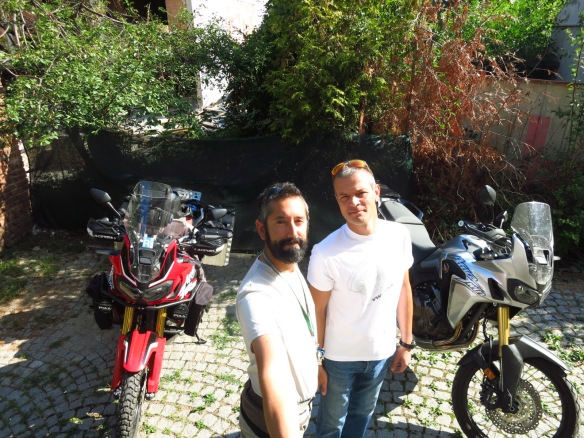 After exchanging contacts I left Sofia following Nikolay’s directions, and I had a great time on the small roads through the Central Balkan mountains, travelling through small villages, forests… all on my own, no traffic to bother me at all.
After exchanging contacts I left Sofia following Nikolay’s directions, and I had a great time on the small roads through the Central Balkan mountains, travelling through small villages, forests… all on my own, no traffic to bother me at all.
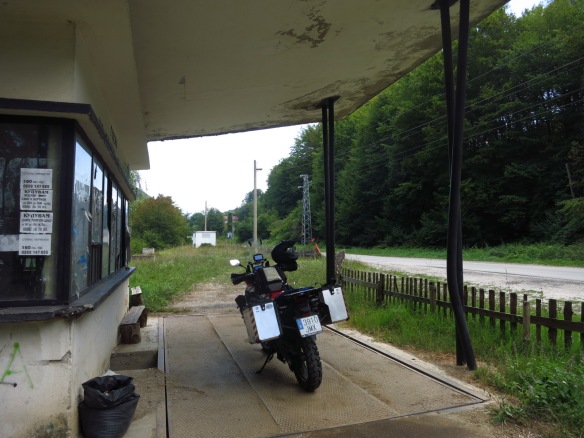 I saw an abandoned truck scale by the side of the road, and next to it, a couple of tables, a barbecue and a small shrine with a fountain, all by the river, so I thought it was a good spot for lunch. When I parked the bike on the scale platform I saw through the broken windows that the scale was still there, unlike most of these devices when they have been left unused, and the door was open.
I saw an abandoned truck scale by the side of the road, and next to it, a couple of tables, a barbecue and a small shrine with a fountain, all by the river, so I thought it was a good spot for lunch. When I parked the bike on the scale platform I saw through the broken windows that the scale was still there, unlike most of these devices when they have been left unused, and the door was open.
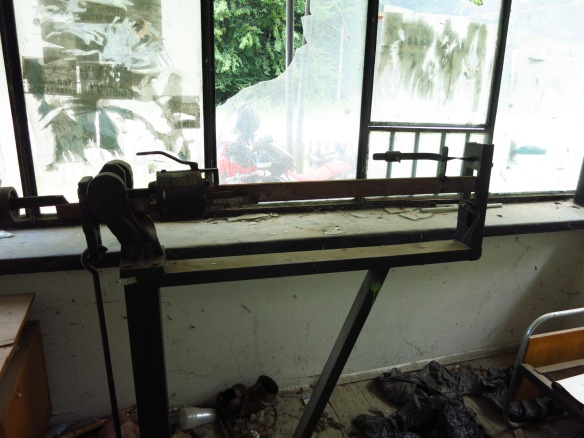 Curious, I went round and entered the building. There was a small, toilet, a room with a sofa, a bed and the remains of a kitchen and a bigger room with a desk and the scale, which looked in quite good condition and it seemed to work. I played with it a bit curious to see how heavy the bike was with all the luggage on and an almost full petrol tank. The scale was very precise, it could be adjusted down to the kilo, and after fiddling with it for a while it read a bit over 280kg. Hum…
Curious, I went round and entered the building. There was a small, toilet, a room with a sofa, a bed and the remains of a kitchen and a bigger room with a desk and the scale, which looked in quite good condition and it seemed to work. I played with it a bit curious to see how heavy the bike was with all the luggage on and an almost full petrol tank. The scale was very precise, it could be adjusted down to the kilo, and after fiddling with it for a while it read a bit over 280kg. Hum…
It was early afternoon by the time I reached the village of Idilevo. A few km off the main road, it was a tiny village, I was out the other end almost before I realised I had arrived, and right before the end of it, I saw an old motorbike with a Union Jack painted on it, and on the opposite side of the road, a gate with a carved wooden sign that read ‘Doug Motocamp’.
 I stopped in front of the gate and Polly came out to receive me. She was the only one there, she told me, the other two owners, Doug and Ivo were away. She showed me around the place, there were four rooms for guests (Yamaha, Honda, BMW and Harley), I got the Yamaha one, since the Honda was already taken. There was also a common room/bar in a barn, a barbecue area and a workshop with tools and space to store motorbikes.
I stopped in front of the gate and Polly came out to receive me. She was the only one there, she told me, the other two owners, Doug and Ivo were away. She showed me around the place, there were four rooms for guests (Yamaha, Honda, BMW and Harley), I got the Yamaha one, since the Honda was already taken. There was also a common room/bar in a barn, a barbecue area and a workshop with tools and space to store motorbikes.
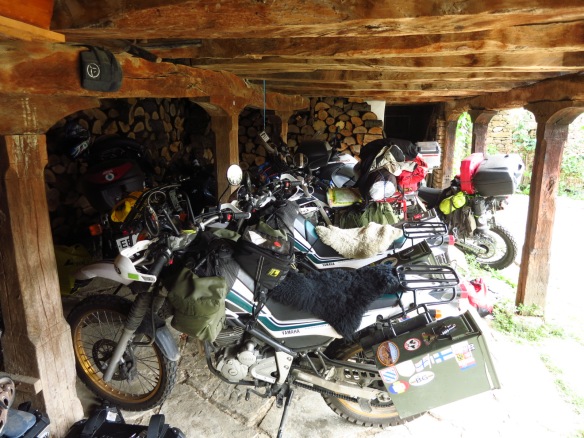 I had a shower and sat down at one of the tables next to the barbecue to write a bit when other people started arriving. There was going to be a barbecue that night and Polly had invited me to join in. Before I realised, there were more people there than could possibly fit in the four guest rooms, and the beer from the help-yourself-fridge did not help me remember all the names I had been told in a matter of minutes.
I had a shower and sat down at one of the tables next to the barbecue to write a bit when other people started arriving. There was going to be a barbecue that night and Polly had invited me to join in. Before I realised, there were more people there than could possibly fit in the four guest rooms, and the beer from the help-yourself-fridge did not help me remember all the names I had been told in a matter of minutes.
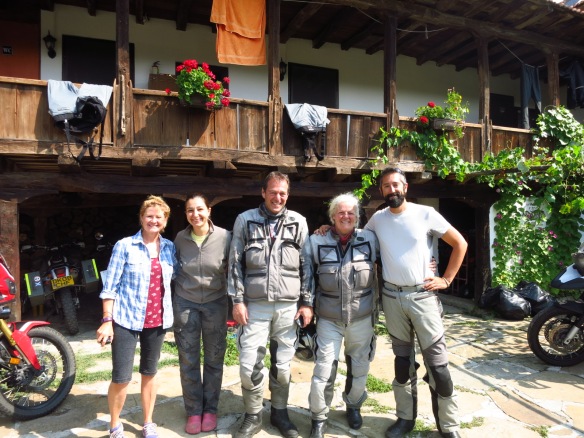 Talking to different people, I realised that most of them were not guests, but travellers whose paths had taken them to this little village in the middle of Bulgaria at some point in their lives and they had realised that it was the perfect base both for exploring this part of the world (Greece, Turkey, Macedonia, Albania, Montenegro, Kosovo, Romania, etc. are all very near) and as a starting point for longer trips east.
Talking to different people, I realised that most of them were not guests, but travellers whose paths had taken them to this little village in the middle of Bulgaria at some point in their lives and they had realised that it was the perfect base both for exploring this part of the world (Greece, Turkey, Macedonia, Albania, Montenegro, Kosovo, Romania, etc. are all very near) and as a starting point for longer trips east.
Some of them had left a bike here and flew from Germany or the UK (where most of them were from) to spend the summer riding here instead of wasting a week coming and another going back home, others had even bought an old house in the village and were doing it up, since both the price of property and labour were incredibly cheap.
The evening and then night were spent eating meat, drinking beer and sharing countless stories about bikes and travels. This was a little haven, a Shangri-La for all bikers who roam the world, a place to find a moment of rest, comfort and great company with like-minded adventure riders.
A communist UFO
Day 26 – Tuesday 23th August – From Idilevo to Buzludzha and back (162km)
The night before a storm had started while we were having the barbecue and had raged all night while I comfortably slept tucked under a duvet hearing the rain pelting against the window and the roof. The following morning the sky was still covered in clouds and there was a forecast of rain at some time during the day, so I could not plan on venturing into the mountains and find some trails, everything was muddy and a few days ago one of the British girls who spent the summer in the village had had a fall while offroading and hurt her shoulder.
I decided to pop into the Sevlievo, the nearest big town, to get some oil for the chain oiler and do some housekeeping on the bike. Once that was done the weather seemed to improve a bit, so I decided to go and visit Buzludzha, which was about 60km away by paved roads and it was something I really wanted to visit.
Buzludzha is not a town, but a mountain peak, and the reason I wanted to go there was not to do some hiking, but to visit the monument that is located at its top, more than 1400m above sea level. This is no ordinary monument, but a concrete monster built in 1981 to commemorate the founding of the Bulgarian Communist Party in a secret meeting that had taken place there a hundred years before.
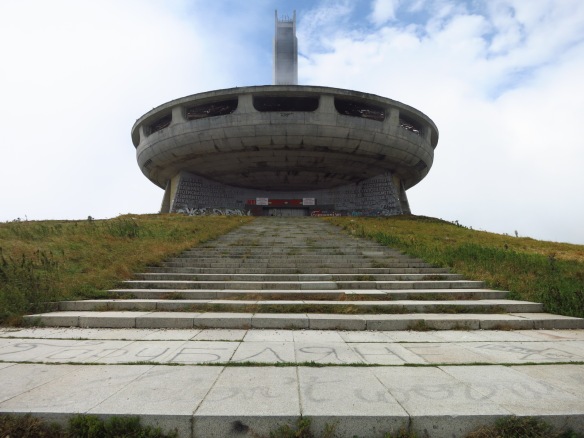 The building is an enormous round concrete structure that resembles a flying saucer with a high tower behind it, and it housed an arena intended for state functions and celebrations. Not proud of its communist past, the Bulgarian government let the building fall into disrepair and now it sits slowly falling to pieces in the middle of nowhere.
The building is an enormous round concrete structure that resembles a flying saucer with a high tower behind it, and it housed an arena intended for state functions and celebrations. Not proud of its communist past, the Bulgarian government let the building fall into disrepair and now it sits slowly falling to pieces in the middle of nowhere.
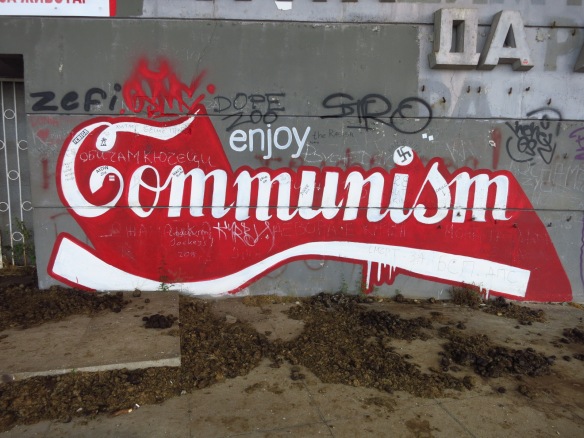 After riding up the Shipka pass, another amazing road to add to my list, I took a smaller road that led to the monument. This one was in quite bad conditions, possibly also forgotten by the government, as it only leads to the building.
After riding up the Shipka pass, another amazing road to add to my list, I took a smaller road that led to the monument. This one was in quite bad conditions, possibly also forgotten by the government, as it only leads to the building.
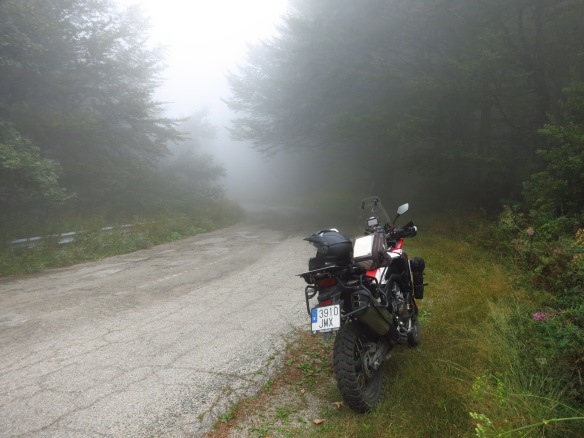 It was a rather heavy morning, and after some tight corners I reached a col from where the imposing structure first came into view. At the col there was another monumental construction, two hands holding torches, from where a footpath led up the mountain to the building. The road continued, though, so I went on until I reached the end of it at the foot of huge stairs that raised to the entrance.
It was a rather heavy morning, and after some tight corners I reached a col from where the imposing structure first came into view. At the col there was another monumental construction, two hands holding torches, from where a footpath led up the mountain to the building. The road continued, though, so I went on until I reached the end of it at the foot of huge stairs that raised to the entrance.
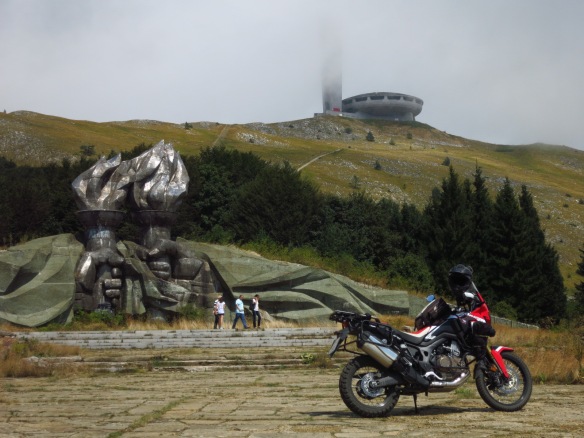 Up to no long ago, the building had been open, but in recent years the roof had deteriorated considerably, so the government had decided to weld the doors shut. Even so, people had managed to break through some window panes into the staircases, and from then on a kind of battle had been taking place – someone cut open the iron bars blocking access and a few days later the authorities would go and weld some new bars on. Being able to see the inside of the building was a matter of being lucky with your timing and going there at the right window of time.
Up to no long ago, the building had been open, but in recent years the roof had deteriorated considerably, so the government had decided to weld the doors shut. Even so, people had managed to break through some window panes into the staircases, and from then on a kind of battle had been taking place – someone cut open the iron bars blocking access and a few days later the authorities would go and weld some new bars on. Being able to see the inside of the building was a matter of being lucky with your timing and going there at the right window of time.
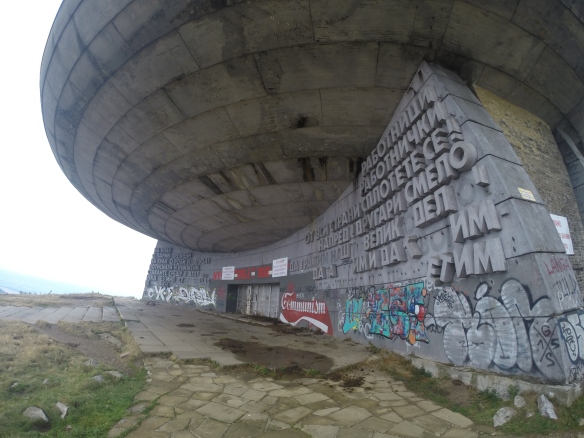 At the Motocamp, the latest info going round was that it had just been closed again, and sure enough, when I got there I could find no way of accessing the interior despite going round the building several times. I was very disappointed, but I have to admit that it was still very impressive from the outside.
At the Motocamp, the latest info going round was that it had just been closed again, and sure enough, when I got there I could find no way of accessing the interior despite going round the building several times. I was very disappointed, but I have to admit that it was still very impressive from the outside.
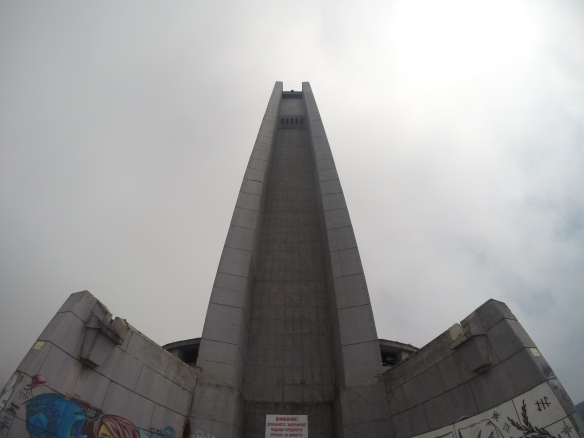 I escaped the rain on the way back made it to the camp dry, where I spent the rest of the day catching up on my writing and chatting to the people there.
I escaped the rain on the way back made it to the camp dry, where I spent the rest of the day catching up on my writing and chatting to the people there.
Lake Batak
Day 27 – Wednesday 24th August – From Idilevo to lake Batak (259km)
Bulgaria, which at first was only planned to be the place where Nat would fly home and I would start riding back home too turned out to be much, much more interesting than I had expected. The next step in my very general plan was to be in Athens by Friday to meet my sister and her husband, who were starting their holidays there, so I had about two and a half days to spend between Bulgaria and Greece.
I decided not to push too far, and after asking for advice in the Motocamp I decided to head straight south instead of going west to meet the main road coming down from Sofia. That motorway went through the Blagoevgrad valley, where we had hit 37 degrees of heat the week before, and I was not keen to repeat the experience. The route south would take me on small mountain roads, a much less busy border crossing and into relatively unpopulated areas in northern Greece. Perfect plan.
I don’t like taking border crossings late in the day, and there did not seem to be much to choose from in terms of campsites or accommodation on the Greek side, so taking advice from Peachy, another British expat in Idilevo who knew the area, I decided to stay on the Bulgarian side and go to a campsite by a lake called Batak.
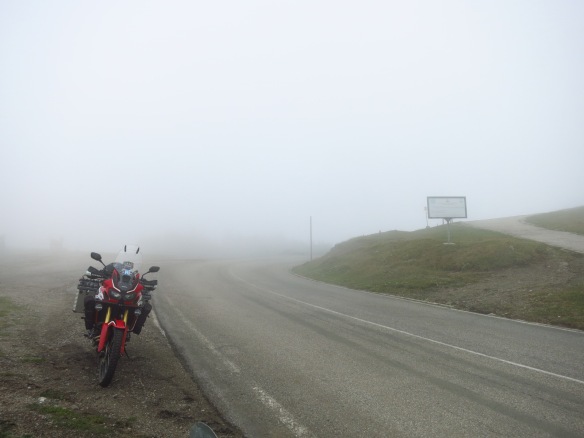 I left Idilevo with the rain layers in my suit, as it looked as if it was going to rain again, and it was rather chilly. It got colder as I crossed the Central Balkan mountain range, and by the top of Beklemeto pass, at 1,520m, there was such thick fog that could enjoy the views at all. What I did enjoy was the road, another great one, and the ride down the southern side of the mountains where the sun came out and the temperature rose quickly. By the time I had reached Kamare, the first town at the bottom of the mountains, it was already so hot I had to stop to remove the rain liner in the suit and open all vents.
I left Idilevo with the rain layers in my suit, as it looked as if it was going to rain again, and it was rather chilly. It got colder as I crossed the Central Balkan mountain range, and by the top of Beklemeto pass, at 1,520m, there was such thick fog that could enjoy the views at all. What I did enjoy was the road, another great one, and the ride down the southern side of the mountains where the sun came out and the temperature rose quickly. By the time I had reached Kamare, the first town at the bottom of the mountains, it was already so hot I had to stop to remove the rain liner in the suit and open all vents.
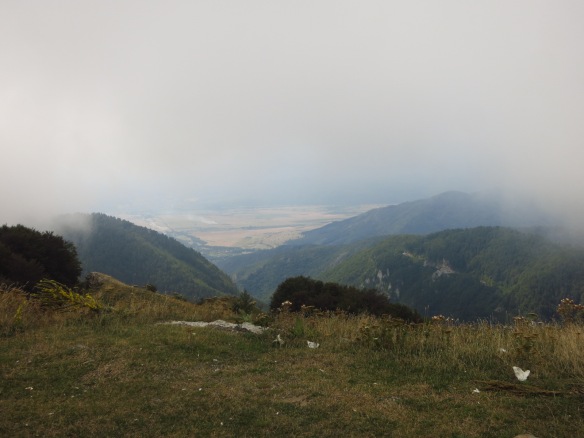 From there all the riding became a lot more tedious. It was hot, and the landscape was nothing more than a huge plain of brown fields. The road was good and straight, which meant a lot more traffic going faster and not much fun on a motorbike. In the outskirts of Plovdiv I went through a place called Trud, to which I give the Ugliest Place On Earth award.
From there all the riding became a lot more tedious. It was hot, and the landscape was nothing more than a huge plain of brown fields. The road was good and straight, which meant a lot more traffic going faster and not much fun on a motorbike. In the outskirts of Plovdiv I went through a place called Trud, to which I give the Ugliest Place On Earth award.
As you can gather, the heat and the rather featureless landscape were not doing much for my mood, but that changed quickly a while after I left Plovdiv behind heading west and turned south in Pazardzhik to go up into the mountains once again. The number on my GPS altimeter kept increasing and I started to fear that if the lake was higher than I had thought it would be, I was going to have an interesting night on my sleeping bag…
Lake Batak was beautiful, and the campsite had a small island in front of it. I stopped by reception, which was nothing more than a tiny wooden hut, but there was nobody there. The camp was half empty, there were only a few caravans and no tents, and the few people I saw were far away fishing or walking along the lake shore. I was wondering what to do when I saw a small sign on the hut window with a phone number and a message saying to call if there was no one there. I did, and a very helpful guy told me that I could put my tent up anywhere I wanted and gave the wifi password. Wifi? There were a few showers and toilets behind the hut, but that was it, no bar, no common room, no kitchen… but there was wifi, and from what I found later, it was accessible even from my tent. What a luxury! It reminded me of a campsite in Finland I has stayed in some years before.
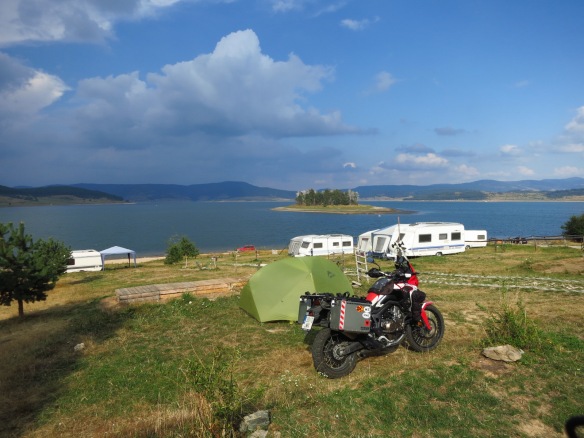 I put my tent up and sat down to write on a wooden table nearby when the owners appeared and we arranged the check in. He told me I was supposed to fill in a form with quite a lot information because the authorities were growing more wary of refugees travelling through the area, but he said that my name would me more than enough and even gave 15% discount when I told him that I had found out about his place in the Motocamp.
I put my tent up and sat down to write on a wooden table nearby when the owners appeared and we arranged the check in. He told me I was supposed to fill in a form with quite a lot information because the authorities were growing more wary of refugees travelling through the area, but he said that my name would me more than enough and even gave 15% discount when I told him that I had found out about his place in the Motocamp.
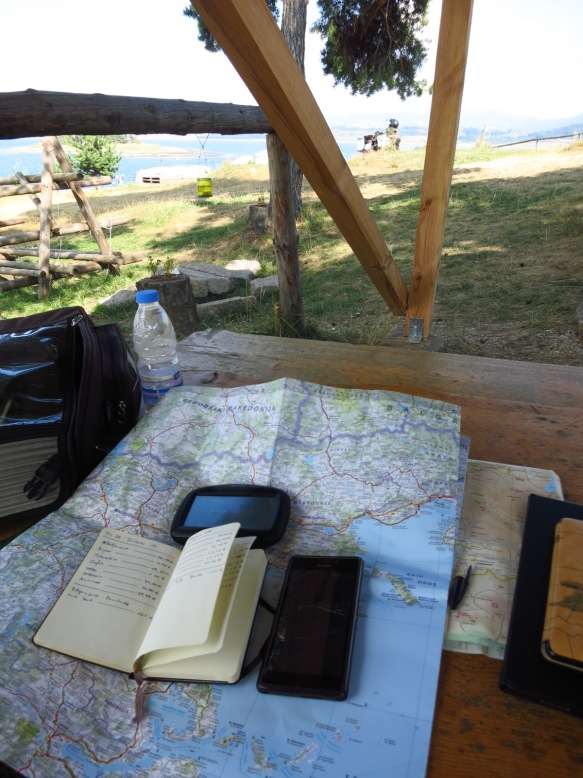 I thought about going for a walk along the shore, but by then there were dark clouds coming fast from the north and I could hear thunder, so I stayed and cooked an early dinner on my stove in order to be ready to get tucked up into the tent when the storm came.
I thought about going for a walk along the shore, but by then there were dark clouds coming fast from the north and I could hear thunder, so I stayed and cooked an early dinner on my stove in order to be ready to get tucked up into the tent when the storm came.
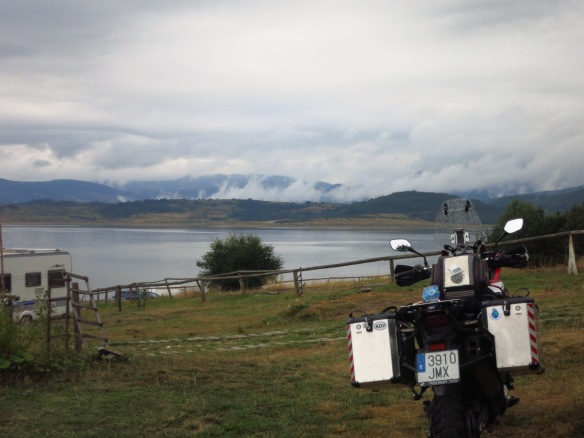 It did come right after it got dark, and with it came pouring rain and winds that shook my tent all night, but I was so tired that with some earplugs on I slept through the night without barely noticing.
It did come right after it got dark, and with it came pouring rain and winds that shook my tent all night, but I was so tired that with some earplugs on I slept through the night without barely noticing.
From Canadian lakes to Spanish badlands
Day 28 – Thursday 25th August – From lake Batak to Vergina (389km)
My days on the motorbike kept getting longer now that I was travelling on my own, and by now I was pretty much into the long distance mind-set. This was going to be the longest riding day so far, but I did not intend to do too much at once – the AT is less comfortable as a long distance tourer than both the V-Strom and the Super Ténéré, so I had promised myself that I would take breaks after no more than 100km.
It had been raining all night and I don’t like folding the tent when it is wet, but there was no sun in the morning, so it was useless to wait for it to dry. I wiped as much water off as I could, took it down and left with all the layers on the suit on, as it was rather cold.
In true Frost style, I took a road less travelled south to a small border crossing, at one more time Bulgaria offered its best landscape – thick forests and mirror-like lakes that would not have looked out of place in Canada.
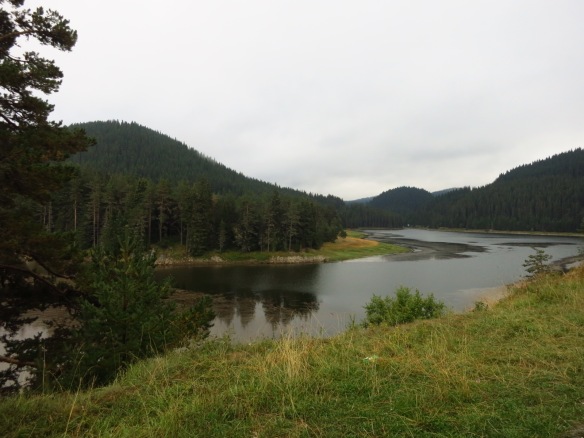 When I reached the border there were only a few cars and two lorries in front of me, but as I had already experienced on my way into the country, Bulgarian border policemen seem to be the slowest in Europe. Once everything was sorted, I rode a short distance to the Greek border, was quickly waved in with the usual Barça comments and rode into what seemed another world.
When I reached the border there were only a few cars and two lorries in front of me, but as I had already experienced on my way into the country, Bulgarian border policemen seem to be the slowest in Europe. Once everything was sorted, I rode a short distance to the Greek border, was quickly waved in with the usual Barça comments and rode into what seemed another world.
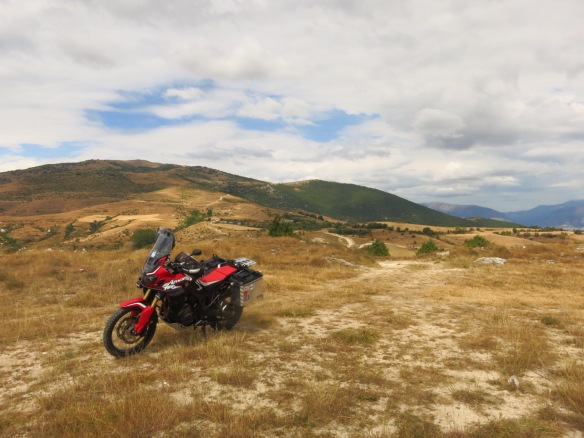 If you had told me that I had teleported to the hills in central Spain I would not have doubt it. What had been lakes and green forests just an hour ago were now golden brown hills, with very few trees, a dry smell in the air and the temperature rising fast.
If you had told me that I had teleported to the hills in central Spain I would not have doubt it. What had been lakes and green forests just an hour ago were now golden brown hills, with very few trees, a dry smell in the air and the temperature rising fast.
Despite the contrast, it was still very beautiful, particularly through the route I had chosen, avoiding large towns and main roads. I went near a place called Drama, but turned south before reaching it, and it was not until near Serres that I started to find bigger roads.
My first good impressions of Greece quickly changed. The landscape was now mostly flat and scorched by the sun, everything had an abandoned air about it, and the roads were no better than what I had found in the previous countries. The ring road around Serres looked like a Russian ring road – with catastrophically bad tarmac, junctions with traffic lights every few hundred metres that made fast progress all but impossible and the worst drivers I had found so far on this journey. Greek drivers seem to be very bitter about being overtaken – I would pass a 15-year old car and I could see it accelerating in my mirrors, trying to catch up again. I would stop first at a red light and the car next to me would be in gear, slipping the clutch and ready not to let me get ahead once the lights turned green. For God’s sake, even middle-aged women in crumbling little hatchbacks did it… how on earth did they expect to outrun a motorbike?
I took the motorway from there on to try and save some time, seeing there was no landscape to appreciate and the main roads were turning quite nasty, and was surprised to find a row of toll booths after riding a few kilometres on it. There was absolutely no sign anywhere before entering the motorway that announced that it was a toll road. First time I saw it. It was not a lot of money, but I paid it gingerly seeing how bad the tarmac was even on the motorway forming foot-tall folds under the heat and the weight of trucks, not to mention the hordes of nasty drivers. Oh, and they would not take credit cards to pay the toll.
A good while later I was glad to get off the motorway and head into the small town of Vergina, where I had found a cheap room in a small pension. At least this was a good ending to the day – the place was quiet, the room good, the girl in reception very nice, and they let me put the bike in the garden, where I could see it from my balcony. The only negative note was that they would not take credit card either, and all the money I had left were a few Bulgarian Lev, so I ad to go find the only ATM in the village.
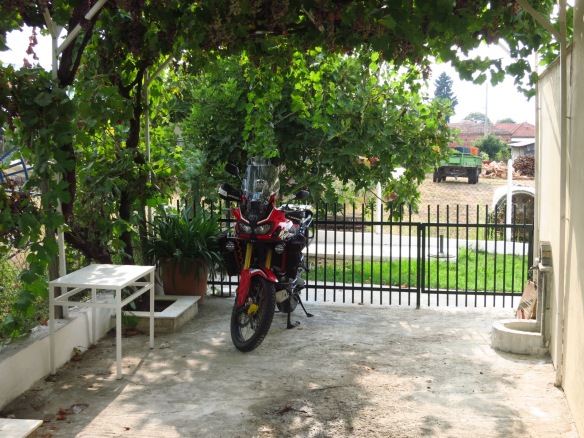 It took me a good while, as the town seemed to consist of detached houses and no centre, but in the end I managed to find the ATM and a small supermarket where I got some food and the end-of-the-day beer.
It took me a good while, as the town seemed to consist of detached houses and no centre, but in the end I managed to find the ATM and a small supermarket where I got some food and the end-of-the-day beer.
Contradictory feelings
Day 29 – Friday 26th August – From Vergina to Athens (485km)
I had a long way to get to Athens today and was determined to avoid the motorway, where most traffic (and manic drivers) would be and see some nice landscape away from industrial states, factories, scrapyards and the general grimness that grows around big towns, so I plotted a route that would first take me as close to mount Olympus as it was possible to get without deviating from my final destination and then south through Larisa, Farsala, Lama, Thiva and, only at the very end, into the motorway for a few kilometres and to Athens.
It did not take long for the bad impressions of the day before to disappear – I filled the tank up in the first petrol station I found after Vergina (the one that the GPS indicated in front of the pension did exist, but was abandoned) and had a short chat, mostly based on hand gestures, with the old lady who owned the place about the country stickers on my bike. For most of the day the roads were really nice, with very little traffic, rising up into the mountains, descending into plains and cutting across the countryside. The only exceptions were, as expected, when I had to cross the few big towns on my route, but even that went better than expected, as they were smaller than I feared and traffic was light enough.
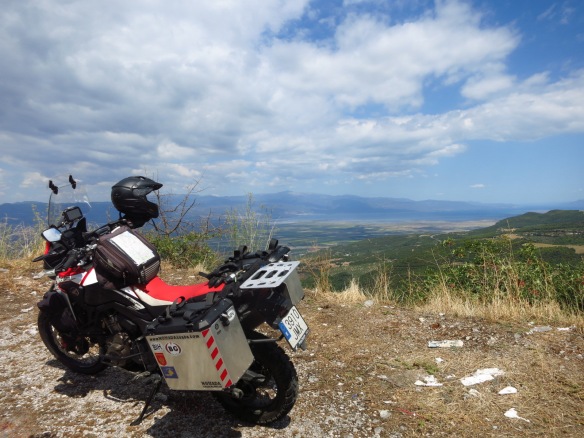 The weather had also been kind for most of the way, but in the end I could not escape the wind, which appeared about 150km from Athens and got so bad that, combined with the fatigue of a long day’s riding, gave me a headache. I stopped one last time to take an Ibuprofen and headed into Athens, wary of what I might find.
The weather had also been kind for most of the way, but in the end I could not escape the wind, which appeared about 150km from Athens and got so bad that, combined with the fatigue of a long day’s riding, gave me a headache. I stopped one last time to take an Ibuprofen and headed into Athens, wary of what I might find.
This was by far the biggest city I was riding into, the hotel I had found was near a main train station just north of the centre, and I was likely to encounter the worst of the end of the week rush hour.
The motorway turned into a ring road which I soon left following the directions on the GPS, and then it did not take more than a few traffic lights to reach the hotel. All in all, it had been a fuss free and easy entry into the city, for which I was very glad. I was surprised to see how many big motorbikes there were in the city, mostly Suzuki V-Stroms and Yamaha TDM 900s, the latter one usually a rare sight in Spain, and how very few people wore helmets. Was it not compulsory?
At the hotel they told me to park the bike right in front of the steps in the main door, where the receptionist, who was on duty 24 hours could see it, and insisted that I did not leave anything on it.
I still had some time left in the day after I had settled in my room, so I decided to go out to explore the neighbourhood and get some information for the following day. My sister and her husband were arriving very early in the morning on an overnight flight from Madrid, but we were not staying at the same hotel I was now – when we had booked ours they had no rooms for Friday, so I had had to find myself another one. The one for Saturday was just a few corners away, so I went to see if I could take my stuff there at 7:00 the following morning and whether there was somewhere to park the bike.
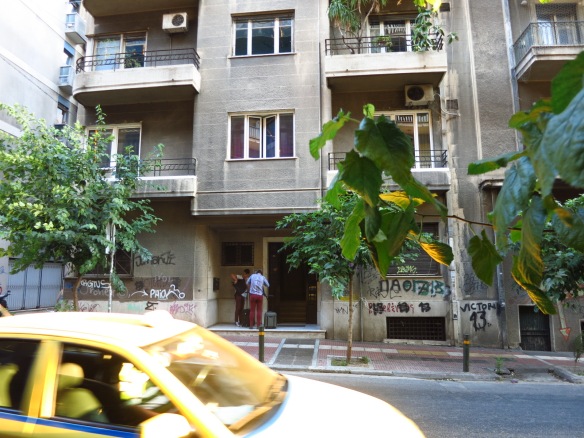 I walked all the way up the street and then down again and I could not find the bed and breakfast… it was not a long street, maybe seven or eight small blocks, and I had not taken the exact address with me, a mistake, I know, but I was expecting to find a sign of some kind in the building easily enough. It turned out to be no more than a small printed and laminated sign stuck on the wall next to a doorway, and I only saw it because there was a guy with a suitcase and a backpack standing in front of it waiting for the door to open. There was a doorbell in the sign, and after pressing the button a few times the owner came, not from inside the building, but walking up the street. It seemed they had two separate flats and the doorbell sounded wirelessly on the other one, the guy who was waiting told me that he had read we were supposed to ring once and wait for a few minutes. The B&B guy said that there was no problem regarding the following morning, and showed me a car park round the corner that would take the bike for 5 euros a day. From what I had seen so far in the street, that was a price I was more than willing to pay to have securely parked.
I walked all the way up the street and then down again and I could not find the bed and breakfast… it was not a long street, maybe seven or eight small blocks, and I had not taken the exact address with me, a mistake, I know, but I was expecting to find a sign of some kind in the building easily enough. It turned out to be no more than a small printed and laminated sign stuck on the wall next to a doorway, and I only saw it because there was a guy with a suitcase and a backpack standing in front of it waiting for the door to open. There was a doorbell in the sign, and after pressing the button a few times the owner came, not from inside the building, but walking up the street. It seemed they had two separate flats and the doorbell sounded wirelessly on the other one, the guy who was waiting told me that he had read we were supposed to ring once and wait for a few minutes. The B&B guy said that there was no problem regarding the following morning, and showed me a car park round the corner that would take the bike for 5 euros a day. From what I had seen so far in the street, that was a price I was more than willing to pay to have securely parked.
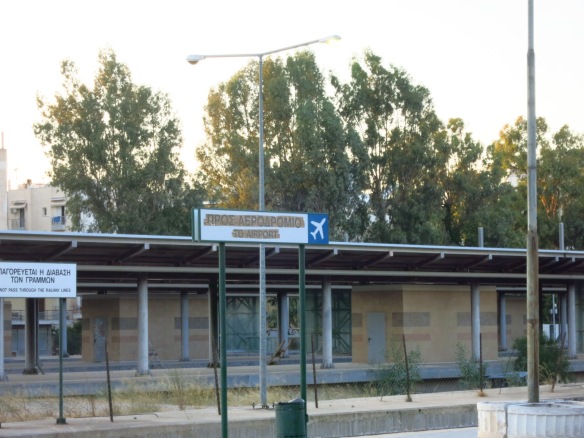 What little I had seen trying to find the B&B and what I saw later when I walked to the train station to find some information on bus and metro day passes left me rather shocked. This was not what I was expecting from a neighbourhood just to underground stops away from the centre of a EU capital city – the streets were filthy, the trees had not been pruned in a long time, I had to walk half hunched to avoid the branches, the plants and grass strips by the side of the streets were either dead or wildly overgrown, electrical boxes from street lighting were broken open, a surprisingly high number of storefronts were boarded up or just abandoned, their windows covered in graffiti or broken, there were whole empty derelict buildings, abandoned cars in the street… it was as if they had stopped caring for the city a long time ago.
What little I had seen trying to find the B&B and what I saw later when I walked to the train station to find some information on bus and metro day passes left me rather shocked. This was not what I was expecting from a neighbourhood just to underground stops away from the centre of a EU capital city – the streets were filthy, the trees had not been pruned in a long time, I had to walk half hunched to avoid the branches, the plants and grass strips by the side of the streets were either dead or wildly overgrown, electrical boxes from street lighting were broken open, a surprisingly high number of storefronts were boarded up or just abandoned, their windows covered in graffiti or broken, there were whole empty derelict buildings, abandoned cars in the street… it was as if they had stopped caring for the city a long time ago.
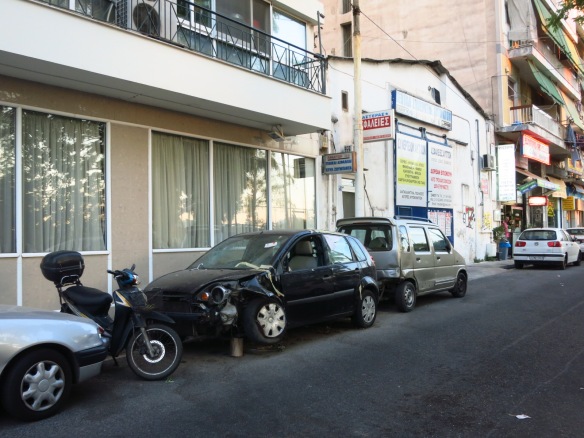 With all the info I needed for the following day, I went back to the hotel, wrote for a while and went early to bed – Saturday was going to be a long day with a very early start, and I was excited both to see my sister and her husband and to visit the Acropolis.
With all the info I needed for the following day, I went back to the hotel, wrote for a while and went early to bed – Saturday was going to be a long day with a very early start, and I was excited both to see my sister and her husband and to visit the Acropolis.
City of ruins
Day 30 – Saturday 27th August – Athens (0km)
At 7:00 I had already got up, put all my things on the motorbike and ridden the short distance to the B&B where I found my sister and her husband, Alex, who after a sleepless night of travel were all ready and determined to be in the Acropolis by the time the gates opened, ahead of most tourists.
We had some breakfast on the way and little past 8:00 we were at the foot of the hill that contains some of the most famous archaeological remains in the world. There were only a few people queuing ahead of us, and they all looked to be past retirement age, but nevertheless a member of the staff came down the queue asking them whether they were students. They said they weren’t, and so did we when she asked us, but a guy who was behind us, not much younger than ourselves said ‘yes’ and without any further verification, the girl handed him a free ticket. Damn… we could have saved ourselves 30 euros.
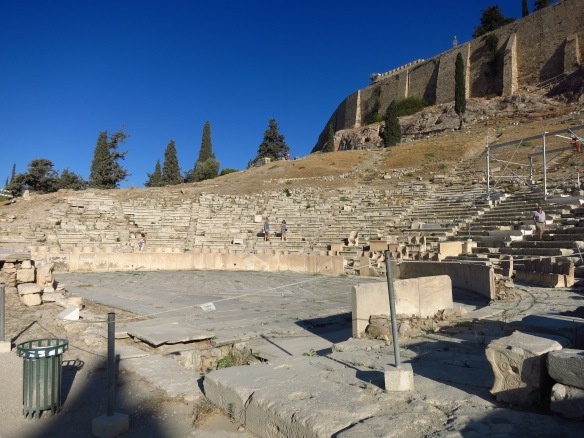 There were many things to see at the foot of the hill, long before reaching the Acropolis itself, the Odeon of Pericles, the Theatre of Dionysus Eleuthero, the Odeon of Herdes Atticus… But after having spent a while contemplating all these remains, my sister declared that she wanted to see the Acropolis before the bulk of tourists arrived, and that we would have time to see the rest on the way down.
There were many things to see at the foot of the hill, long before reaching the Acropolis itself, the Odeon of Pericles, the Theatre of Dionysus Eleuthero, the Odeon of Herdes Atticus… But after having spent a while contemplating all these remains, my sister declared that she wanted to see the Acropolis before the bulk of tourists arrived, and that we would have time to see the rest on the way down.
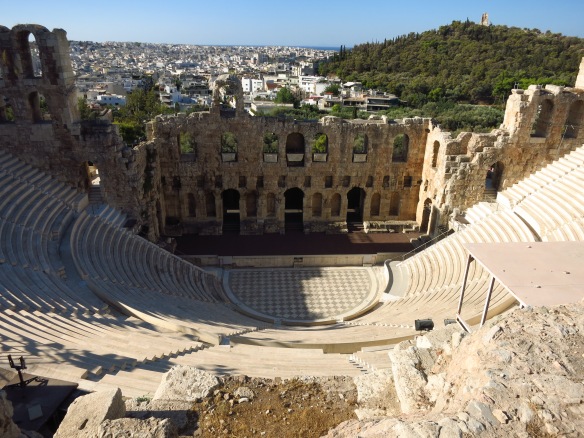 Unfortunately, there are some parts in the world where, no matter how fast you run, or how early you get up, you can’t escape a cruise party, and when we reached the main entrance we saw the stairs swarmed with people with little stickers on their polos marking them as belonging to this or that ship, taking pictures and listening to their respective guides, who tried to keep a reasonable distance from each other not to create interferences. The explanations were long enough for us to slip through and walk through the entrance without too much company.
Unfortunately, there are some parts in the world where, no matter how fast you run, or how early you get up, you can’t escape a cruise party, and when we reached the main entrance we saw the stairs swarmed with people with little stickers on their polos marking them as belonging to this or that ship, taking pictures and listening to their respective guides, who tried to keep a reasonable distance from each other not to create interferences. The explanations were long enough for us to slip through and walk through the entrance without too much company.
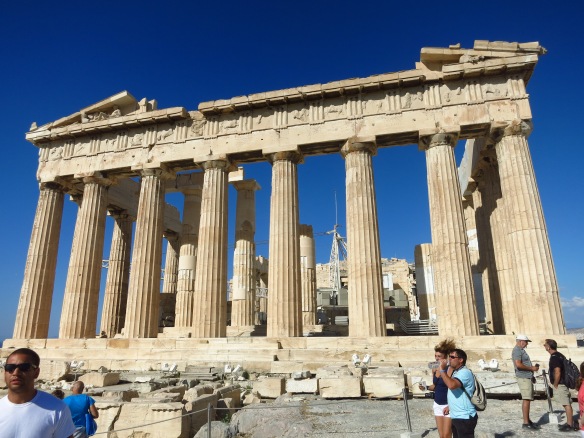 I am not given to getting up early, but this was definitely worth it – walking into a nearly empty Acropolis first thing in the morning, as the sun rises and the morning is still cool, is something that has to be experienced. We have all seen pictures, we have all studied it to a certain extent at school or high school, but actually setting foot on gives a feeling that is difficult to describe. It does not matter how many pictures I might post here or in Facebook, come and feel it yourselves.
I am not given to getting up early, but this was definitely worth it – walking into a nearly empty Acropolis first thing in the morning, as the sun rises and the morning is still cool, is something that has to be experienced. We have all seen pictures, we have all studied it to a certain extent at school or high school, but actually setting foot on gives a feeling that is difficult to describe. It does not matter how many pictures I might post here or in Facebook, come and feel it yourselves.
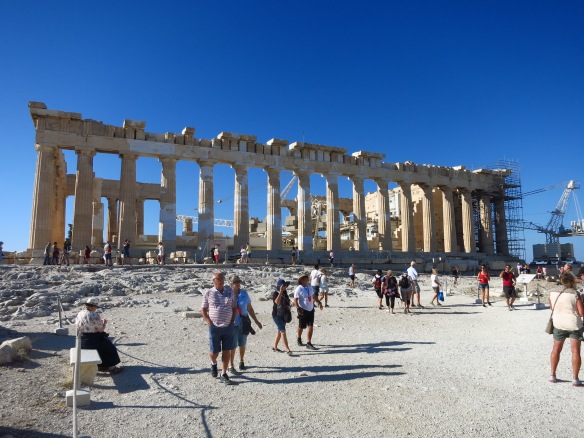 Our ticket included entrance to many other archaeological sites throughout the city, and we spend all day visiting them despite the high temperature. I make a point of not discussing politics or religion on this blog, but when one sees what an advanced civilization this was, you cannot help but wonder how far mankind could have got if it had not been by huge step backwards that the Middle Ages and Christianity represented and in a way still represent. I do understand the basic human need to feel that there is a purpose to us all or to believe that there is a superior being that knows best what it is doing, or at least someone to blame for all the random tragedies that happen in the world, but I keep coming to the conclusion that religion has done us no favours at all. And it is not just religion, more and more lately I keep thinking of that George Carlin quote: ‘never underestimate the power of stupid people in large numbers’. Walking around the ruins I wondered if thousands of years from now other people, maybe from other planets, would walk around the remains of our world listening to the explanation of their guide: ‘and then in 2016 Trump became President of the United States…’
Our ticket included entrance to many other archaeological sites throughout the city, and we spend all day visiting them despite the high temperature. I make a point of not discussing politics or religion on this blog, but when one sees what an advanced civilization this was, you cannot help but wonder how far mankind could have got if it had not been by huge step backwards that the Middle Ages and Christianity represented and in a way still represent. I do understand the basic human need to feel that there is a purpose to us all or to believe that there is a superior being that knows best what it is doing, or at least someone to blame for all the random tragedies that happen in the world, but I keep coming to the conclusion that religion has done us no favours at all. And it is not just religion, more and more lately I keep thinking of that George Carlin quote: ‘never underestimate the power of stupid people in large numbers’. Walking around the ruins I wondered if thousands of years from now other people, maybe from other planets, would walk around the remains of our world listening to the explanation of their guide: ‘and then in 2016 Trump became President of the United States…’
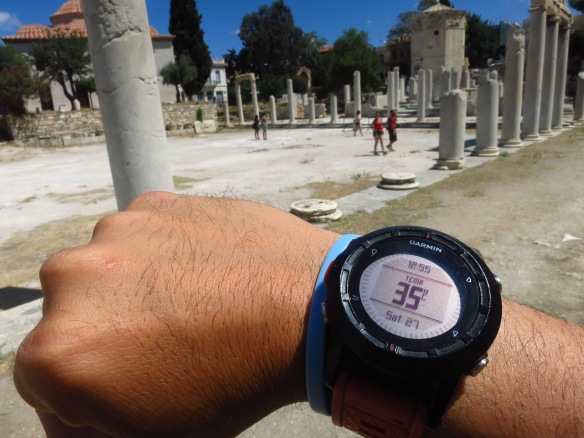 We also visited the flea market on the other side of the Acropolis and wandered for a while around the narrow streets of the Plaka neighbourhood, but decided to save that for the following morning and headed to the Philopappos Hill for the best view of the Acropolis.
We also visited the flea market on the other side of the Acropolis and wandered for a while around the narrow streets of the Plaka neighbourhood, but decided to save that for the following morning and headed to the Philopappos Hill for the best view of the Acropolis.
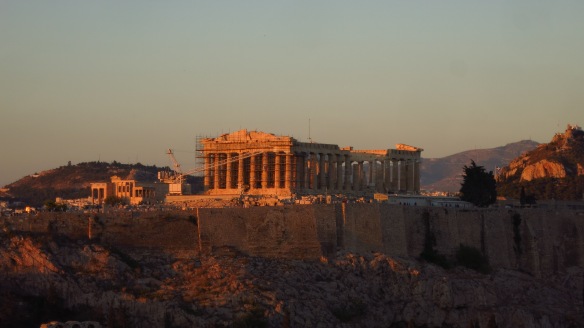 The hill is located to the southwest of the ruins and is the perfect spot to see the sunset with a perfect view of the Acropolis glowing red in the light of the disappearing sun and then contemplate the lights of the whole city turning on little by little, until almost dark, when the Acropolis itself is lit. Amazing.
The hill is located to the southwest of the ruins and is the perfect spot to see the sunset with a perfect view of the Acropolis glowing red in the light of the disappearing sun and then contemplate the lights of the whole city turning on little by little, until almost dark, when the Acropolis itself is lit. Amazing.
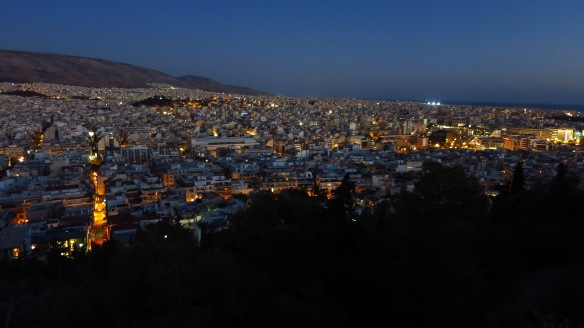 As we walked across the centre, however, my impression of the city the day before was confirmed – away from the Acropolis and the streets that surround it, the city seems to be crumbling to pieces. There are a few EU capitals I have not visited yet (Dublin, Bratislava, Luxembourg, Oslo), but I think it is safe to say that Athens was, by a considerable margin, the one in the worst condition.
As we walked across the centre, however, my impression of the city the day before was confirmed – away from the Acropolis and the streets that surround it, the city seems to be crumbling to pieces. There are a few EU capitals I have not visited yet (Dublin, Bratislava, Luxembourg, Oslo), but I think it is safe to say that Athens was, by a considerable margin, the one in the worst condition.
Final departure
Day 31 – Sunday 28th August – Athens (0km)
Today marked the beginning of my way home. My sister and Alex were taking a ferry to Santorini in the afternoon to spend their rest of their holidays in the islands, and I was supposed to start my way back.
I had booked a ferry from Igoumenista to Brindisi on Tuesday, but when I started planning the trip I saw that it would take considerably less than I had thought it would, so I still had two and a half days to visit in Greece instead of just riding to the port.
I decided to spend that night in the city too, as I did not fancy sleeping in the suburbs, and the parking space for the bike was paid until 7:00 the following morning, so I might as well use it.
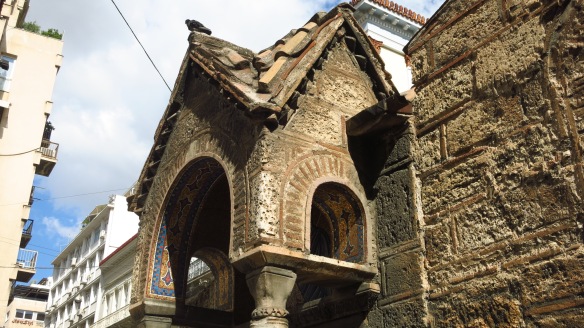 We visited the neighbourhoods of Plaka and Monastiraki in the morning, had a very good Gyros for lunch and after the long walk back to the B&B, said our goodbyes. I did not fancy going back to the centre until dinner time, so I stayed and planned the next two days. The ferry departed at 22:00, which left me two full days, so after studying the maps I decided that I would ride around the Peloponnese peninsula and see if I could leave the country with a more favourable opinion.
We visited the neighbourhoods of Plaka and Monastiraki in the morning, had a very good Gyros for lunch and after the long walk back to the B&B, said our goodbyes. I did not fancy going back to the centre until dinner time, so I stayed and planned the next two days. The ferry departed at 22:00, which left me two full days, so after studying the maps I decided that I would ride around the Peloponnese peninsula and see if I could leave the country with a more favourable opinion.
Tour of the Peloponnese I
Day 32 – Monday 29th August – From Athens to Finikounta (610km)
The previous day I had programmed a route on the GPS taking into account the roads that my map marked as panoramic ones and information I found from a bike tour company. I wanted to get away from big cities again and enjoy small coast roads at my own pace. The end destination was Finikounta, a small beach village at the southwest tip of the peninsula and the only place where I had found accommodation within my dwindling budget. I finished marking all the waypoints, the GPS calculated the route and it told me that it would take… ten hours.
Well, I was leaving early, if the bike was not out of the car park by 7:00 I would have to pay for another full day, so I thought I would take it easy, stop often and I could always pick a more direct route if I got tired.
The guy in the car park did not speak any English, but when I moved the bike he pointed at the sticker from Albania in the panniers and gave me a thumbs up, so I understood he must have been from there.
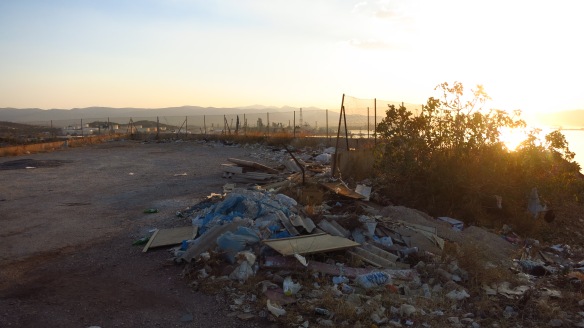 The day was breaking as I rode through the streets, and traffic was not as bad as I feared (the guy from the B&B had told me that they witnessed an accident in the junction in front of the building every day). I was determined to avoid the motorway, and as I was riding around the gulf of Elefsina on the old 8 road, just past a rather depressing area full of oil tanks, the sun came out behind Athens.
The day was breaking as I rode through the streets, and traffic was not as bad as I feared (the guy from the B&B had told me that they witnessed an accident in the junction in front of the building every day). I was determined to avoid the motorway, and as I was riding around the gulf of Elefsina on the old 8 road, just past a rather depressing area full of oil tanks, the sun came out behind Athens.
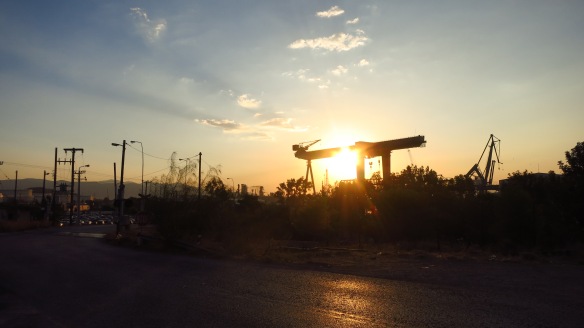 From there on, the journey got much, much better. There was no one on the road, and what a good road it was. It wound its way along the coast, offering superb views first of the gulf of Elefsina and then of the much bigger Megara gulf, until the village of Isthmia, at the mouth of the Corinth canal.
From there on, the journey got much, much better. There was no one on the road, and what a good road it was. It wound its way along the coast, offering superb views first of the gulf of Elefsina and then of the much bigger Megara gulf, until the village of Isthmia, at the mouth of the Corinth canal.
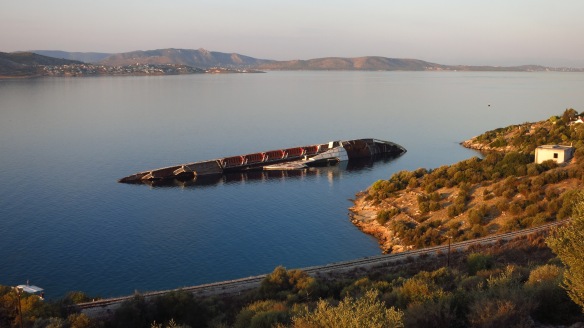 I thought that the Peloponnese peninsula was attached to the rest of the country on this side, but it turned out it is not. There is a manmade canal that connects the Megara gulf with the gulf of Corinth to allow ships to pass through, but it is very narrow, just over 20m wide, which limits the kinds of boats that can actually use it, most cargo boats need to sail around the peninsula. The motorway crosses it via a bridge that is high enough for boats to pass under it, but the road I was on was much nearer its mouth, and therefore lower, so the bridge must allow for the passage of ships. Instead of some variation of a bascule or lift bridge, the Isthmia bridge is a sinking one – it disappears below the surface of the water and rises again once the ship has passed. The road surface is formed by steel beams to allow the water to flow out of it quickly, and this combination of steel, water and big gaps between beams makes it extremely slippery and dangerous on a motorbike. I crossed very carefully, but when I was only two meters from the other side the bike started to slip sideways for no apparent reason. Luckily, I was able to maintain control and climb onto the bank safely.
I thought that the Peloponnese peninsula was attached to the rest of the country on this side, but it turned out it is not. There is a manmade canal that connects the Megara gulf with the gulf of Corinth to allow ships to pass through, but it is very narrow, just over 20m wide, which limits the kinds of boats that can actually use it, most cargo boats need to sail around the peninsula. The motorway crosses it via a bridge that is high enough for boats to pass under it, but the road I was on was much nearer its mouth, and therefore lower, so the bridge must allow for the passage of ships. Instead of some variation of a bascule or lift bridge, the Isthmia bridge is a sinking one – it disappears below the surface of the water and rises again once the ship has passed. The road surface is formed by steel beams to allow the water to flow out of it quickly, and this combination of steel, water and big gaps between beams makes it extremely slippery and dangerous on a motorbike. I crossed very carefully, but when I was only two meters from the other side the bike started to slip sideways for no apparent reason. Luckily, I was able to maintain control and climb onto the bank safely.
Here is a video (not mine) that shows how it works:
Past the village the road became narrower and the towns smaller and further apart. The hills rolling down onto the sea were rather high and its slopes steep, making for really beautiful scenery.
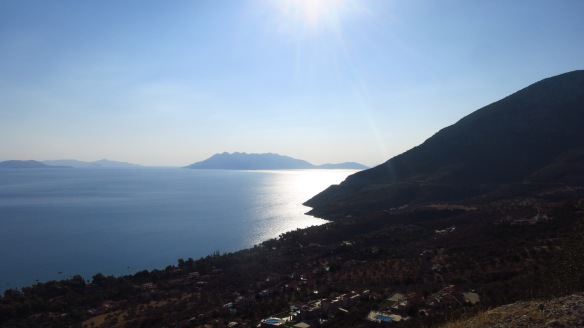 When I reached the outskirts of Nafplion I was once more reminded of the stark contrast between towns and the countryside in Greece. This was the only really ugly spot I had found all day, and I left it behind as fast as I could. After having lunch near Leonidio, I started heading inland for a while to save some time (at this pace the journey was going to take way more than ten hours) and chose to avoid Sparta altogether (no more towns!).
When I reached the outskirts of Nafplion I was once more reminded of the stark contrast between towns and the countryside in Greece. This was the only really ugly spot I had found all day, and I left it behind as fast as I could. After having lunch near Leonidio, I started heading inland for a while to save some time (at this pace the journey was going to take way more than ten hours) and chose to avoid Sparta altogether (no more towns!).
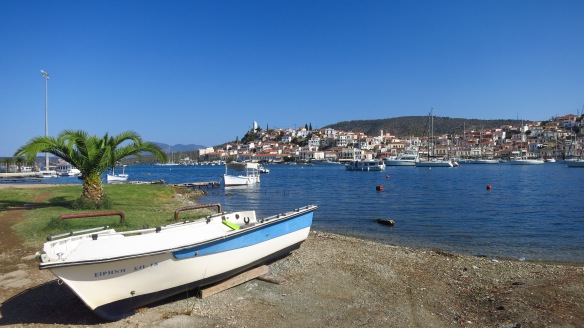 For the next couple of hours, the coast road gave way to a mountain road that took me through a canyon, over a 1000m near mount Parnon and down the other side of the mountain range. It was a marvellous stretch of road, and only the fear of running out of fuel spoilt the fun.
For the next couple of hours, the coast road gave way to a mountain road that took me through a canyon, over a 1000m near mount Parnon and down the other side of the mountain range. It was a marvellous stretch of road, and only the fear of running out of fuel spoilt the fun.
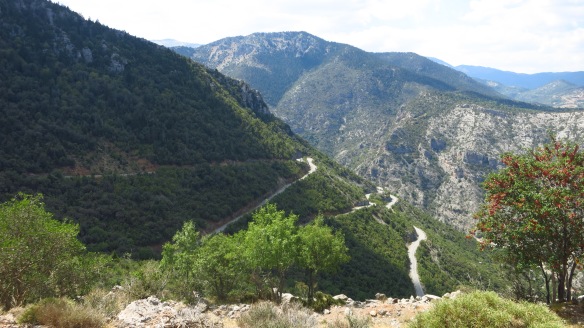 I had not filled up in Leonidio, thinking that I would find a petrol station at the next village, but they were all very small mountain villages without a trace of a petrol station. It was not until I had reached the foot of the other side of the mountain that I saw a sign pointing to one in a village only one kilometre in the opposite way I was going.
I had not filled up in Leonidio, thinking that I would find a petrol station at the next village, but they were all very small mountain villages without a trace of a petrol station. It was not until I had reached the foot of the other side of the mountain that I saw a sign pointing to one in a village only one kilometre in the opposite way I was going.
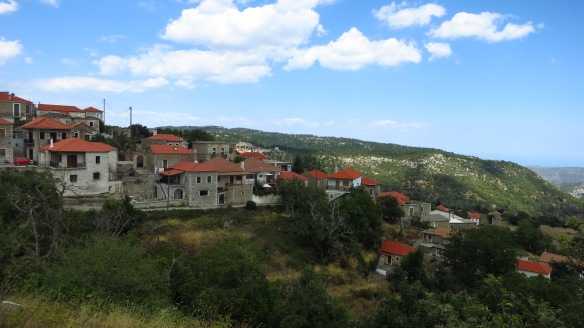 I took a small detour stopped at an old, tiny petrol station. A shady looking young guy who did not speak any English filled up my bike, and while he was at it a friend of his arrived and started walking around the bike. When he saw the Albania sticker he pointed at it and said ‘fuck Albania’, without a trace of a joke in his voice. He was well over two metres tall and did not look particularly intelligent but I was sure he could rip my head off my shoulders with one of his huge hands. I replied ‘yeah man, whatever’, paid and got the hell out of there. At least I had my tank full and I had seen a rare contraption – a Yamaha scooter with shaft drive.
I took a small detour stopped at an old, tiny petrol station. A shady looking young guy who did not speak any English filled up my bike, and while he was at it a friend of his arrived and started walking around the bike. When he saw the Albania sticker he pointed at it and said ‘fuck Albania’, without a trace of a joke in his voice. He was well over two metres tall and did not look particularly intelligent but I was sure he could rip my head off my shoulders with one of his huge hands. I replied ‘yeah man, whatever’, paid and got the hell out of there. At least I had my tank full and I had seen a rare contraption – a Yamaha scooter with shaft drive.
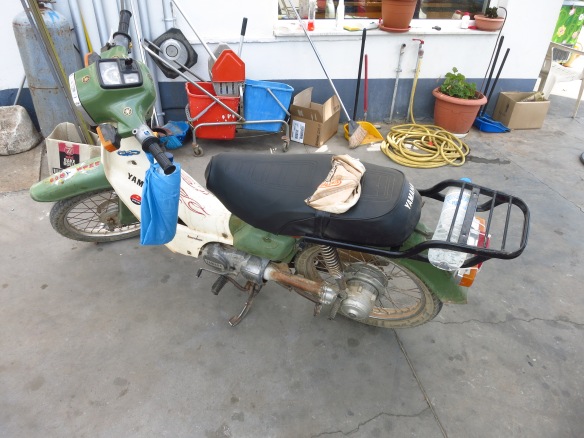 Instead of going straight to Kalamata, I headed down to find the coast again in the village of Githio, and then rode the coast road up to Kalamata. This detour and the mountain road were probably the best bits of road in the whole day.
Instead of going straight to Kalamata, I headed down to find the coast again in the village of Githio, and then rode the coast road up to Kalamata. This detour and the mountain road were probably the best bits of road in the whole day.
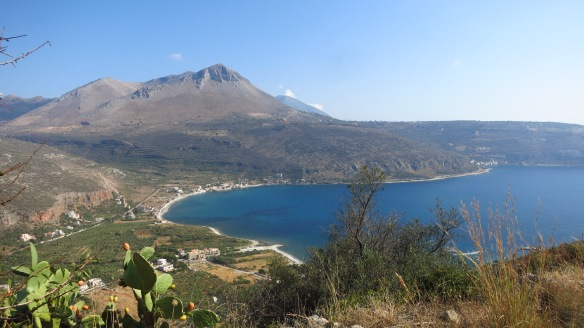 At Velika, west of Kalamata, I left the main road, still following the coast, for the last bit of road before Finikounta, and then I cut across the hills on a road that was little more than a paved track, crossed two hamlets and ended up right at Finikounta.
At Velika, west of Kalamata, I left the main road, still following the coast, for the last bit of road before Finikounta, and then I cut across the hills on a road that was little more than a paved track, crossed two hamlets and ended up right at Finikounta.
It was already dusk, so I did not have much time to visit the town. It was a tiny place by the beach, quiet and very nice, and the hotel was much better than what I was expecting at that price.
Tour of the Peloponnese II
Day 33 – Tuesday 30th August – From Finikounta to Igoumenitsa (492km)
I got up late today and had another shower before setting off, I wanted to experience what comfort my room had to offer, as I was not going to get any for the next 48 hours. I was going to spend the night in a ferry crossing the Ionian Sea from Igoumenitsa to Brindisi, and I had not booked a cabin. The second reason for getting up late, aside from being tired from the long ride the previous day, was that the ferry was leaving at 22:00, so I had all day to cover the almost 500km that separated me from the port. No hurry.
The ride up the western coast of the Peloponnese was a lot less interesting than the east coast. The road to Patras, while not a motorway, was a more important one than the small roads I had been riding on the day before, so there was not much to see. I imagine that the best idea for this leg of the journey would have been to cut across the centre of the peninsula and ride across the mountains, but I did not have time or energy for another mega ride.
What little motorway I found near Patras was free, I only had to pay for the bridge that links the townships of Rio, on the outskirts of Patras, and Antirrio, on the other side of Gulf of Corinth. I was expecting a normal road bridge built on concrete pillars but instead I found a masterpiece of engineering. The bridge, called Charilaos Trikoupis Bridge, is the longest fully suspended bridge in the world, and is a sight to behold.
On the other side the road was more interesting, going up the hills again and inland for a while before becoming a motorway. I was in good time, so when I got to Amphilochia, on the shore of the Ambracian gulf, I decided to go around it on the west side to do some sightseeing instead of going straight north towards the motorway to Igoumenitsa. I stopped for some late lunch in Amphilochia (an excellent gyros), which was a rather beautiful town, and then took a very interesting road.
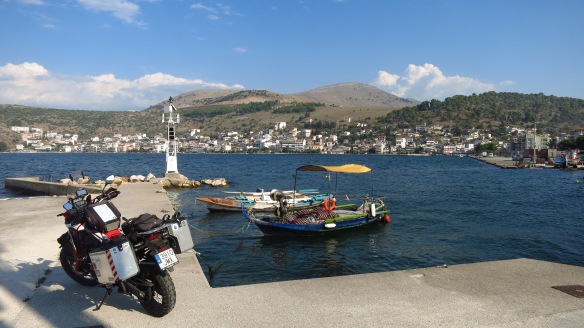 The Ambracian gulf could be a lake if it were not connected to the sea by a narrow opening, and I was enjoying the views from a straight bit of road with no traffic when, after returning my attention to the road, encountered a sight in my rear view mirrors that might be familiar to drivers all over the world – the four rings of an Audi nose two millimetres from my arse. I don’t know why the guy had not overtaken me, but hate people who tailgate, so I decided to put some distance between us. There were a series of ascending fast corners starting right there, so the guy quickly disappeared from view without me having to ride particularly fast.
The Ambracian gulf could be a lake if it were not connected to the sea by a narrow opening, and I was enjoying the views from a straight bit of road with no traffic when, after returning my attention to the road, encountered a sight in my rear view mirrors that might be familiar to drivers all over the world – the four rings of an Audi nose two millimetres from my arse. I don’t know why the guy had not overtaken me, but hate people who tailgate, so I decided to put some distance between us. There were a series of ascending fast corners starting right there, so the guy quickly disappeared from view without me having to ride particularly fast.
You remember I said that Greek drivers are very bitter about being overtaken – well, Mr. Audi was no exception (although I had not overtaken him) and he moment the road was level and straight again, I saw him appear in the distance going as fast as he could to catch up. I would have let him pass, but by the time he got close the road was twisty again, and he had completely disappeared again.
Statistics usually give Ukraine and Albania as the countries with the most dangerous roads in Europe, at least measured by the number of deaths on the road. Having travelled on both countries by motorbike, I did not find that drivers were particularly aggressive or reckless, but they are cursed with some of the worst roads I have ever seen, made worse by the fact that wandering animals of all sizes, kids, horse carts, bicycles and lots of other things that should not be on the road are everywhere. Italians also have a bad reputation, and yes, I can confirm that they drive very fast, but most of them are excellent drivers and know what they are doing. Greece, however, is a different matter. The roads are no excuse here, they are generally good, the problem are the drivers. First, they just have no respect for any traffic rule or their own lives. They are a compendium of all possible wrong conducts on the road. Mobile phones, no helmets on the motorbikes, zero use of indicators, pulling out whenever they feel like it without checking the road, and a long etcetera. I have never had so many near misses as in Greece, and I have ridden a bike in Albania, Ukraine, Russia and Kazakhstan. Second, they are essentially shit drivers, and this guy in the Audi was no exception. Any idiot can bury their foot on the accelerator on a straight line, but you need to know how to drive to take a car round a corner and keep the pace, and believe me, I did not find a single driver who seemed to be able to do it in Greece. And third, as I said, they seem to be very proud.
So, back to our friend in the Audi – I was bored, and just to annoy him I started waiting for him in the straights, letting him catch up and then disappearing in the corners. I guess he got quite mad. When I got tired I just resumed my normal cruising speed and soon I was at the narrow mouth of the gulf, where I did not find a bridge, as I was expecting, but an underwater tunnel, very similar to the one that connects mainland Norway to the island where the Nordkapp is.
After that, the road became tedious and unremarkable again until the last bit before Igoumenitsa, where it followed the coast for a while and then connected to the last bit of motorway coming from inland, where it made a prolonged descent through the hills and straight to the port.
This was an important port, and as such a very busy one. I followed the signs to the terminal building and found myself in what looked like a refugee camp. The car park was complete chaos, it was full and there were cars parked in the middle of the alleys blocking the way, there were people with bags, cases, big bundles of clothes and cardboard boxes everywhere, some sitting, some lying on the floor sleeping. I reluctantly left the bike as close to the front door as I could, removed the tank bag and went into the building to try and exchange my reservation for a ticket.
The inside of the building was no better, it was packed full of people queueing to get tickets, to go through passport and security checks, etc. I looked around but there was no counter with the name of my ferry company, European Seaways. I went to ask at the closest thing, a counter marked European Management Maritime Company, because the name was similar and they were the only ones without an endless queue at the moment. I gave my reservation sheet to a girl who looked like Kate Winslet doing the most boring job on Earth and asked if they were the company I was looking for. She glanced at the printed paper for a millisecond, gave it back to me without looking at me and said ‘not here’. I asked her whether she knew where it was and she replied ‘no’ still without peeling her eyes off the computer screen. Well, thank you… I went to the only other desk without a queue, at the other end of the hall, and a much more helpful girl told me that it was indeed the company I had just been to, EMMC. I went back to my friend there, told her I had specifically been directed there and she just repeated ‘not here’. Well, if anyone from EMMC happens to read this, know that you have a shitty employee at your desk in Igoumenitsa and tell HR that she would be better employed in the back office, where she would not have the bother of having to deal with actual people. To load shipping containers, for example.
In the end it was a guy from a cargo company who told me that the Europan Seaways offices were not in the terminal building, but across the road, and they were not even marked as European Seaways but something else entirely different. Great.
I had been running up and down wearing all the riding gear and carrying the tank bag and the helmet, so by the time I walked into their office I was soaked in sweat, impatient and nervous about having left my bike unsupervised at the terminal. I saw that there were only a couple with kids in front of me and that they were already being given their tickets, ‘wonderful’ I thought, ‘no queue’, but unfortunately they belonged to that species that are not happy with simple information until it has been repeated to them about a hundred times, so after several minutes of ‘Pier 13?’ ‘Yes, pier 13, at the end of the port’ ‘At the end?’ ‘Yes, straight on until the end’ ‘Number 13?’ ‘Yes ma’am, pier 13’ ‘At the end of the port?’ ‘Yes, at the end’ ‘We board there?’ ‘Yes, your ship is in pier 13’ ‘Pier 13?’, etc. etc. etc. I was ready to kill the whole family, chop them to pieces and throw them off pier 13.
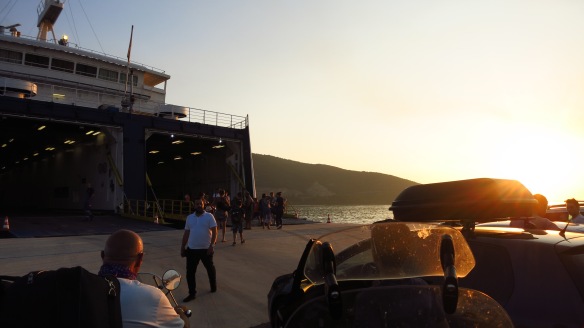 I had arrived early to the port, but by the time I got my tickets it was already boarding time. Not willing to waste a minute more behind people for whom simple information is a challenge, I got on the bike and shamelessly skipped every queue I found – to get out of the car park, to enter the docks area, to go through security control and to board the ship. I was the second vehicle to get on (behind another motorbike), parked the bike and went to find myself a place to put down my sleeping mat.
I had arrived early to the port, but by the time I got my tickets it was already boarding time. Not willing to waste a minute more behind people for whom simple information is a challenge, I got on the bike and shamelessly skipped every queue I found – to get out of the car park, to enter the docks area, to go through security control and to board the ship. I was the second vehicle to get on (behind another motorbike), parked the bike and went to find myself a place to put down my sleeping mat.
Unlike the Grimaldi ferry, where the air conditioning is usually set at about 5ºC, there was no air conditioning at all in this one. By the time we set off dozens of other people had camped on every flat surface on every deck, and it was unbearably hot. I decided to leave my sleeping mat there and went to the upper deck to get some air and see the port slowly disappear in the night. Bye-bye Greece, I’m glad to have survived your roads but I’m afraid I won’t miss you much.
Autostrada
Day 34 – Wednesday 31st August – From Brindisi to Civitavecchia (660km)
The ferry reached Brindisi at 6:00, just as the sun was rising behind the huge cranes of the dock. I rolled out of its belly, parked by the exit and offered everyone who was driving off the ferry a strip-tease show as I took off the clothes I had worn for the voyage and put on the riding gear.
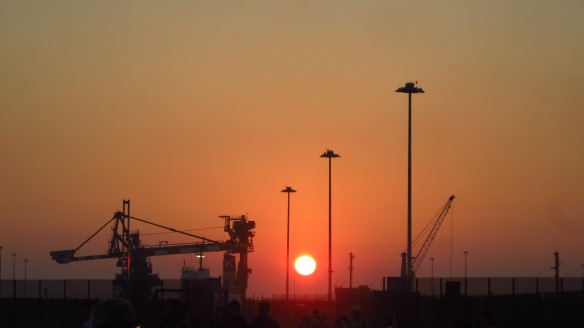 I had to be in Civitavecchia by 20:00 at the latest in order to get the tickets and board the 22:00 ferry to Barcelona, but after my experience in the Igoumenitsa port terminal I preferred to get there earlier than that, so I had decided that for the first and only time in the whole trip, today was going to be an all motorway day.
I had to be in Civitavecchia by 20:00 at the latest in order to get the tickets and board the 22:00 ferry to Barcelona, but after my experience in the Igoumenitsa port terminal I preferred to get there earlier than that, so I had decided that for the first and only time in the whole trip, today was going to be an all motorway day.
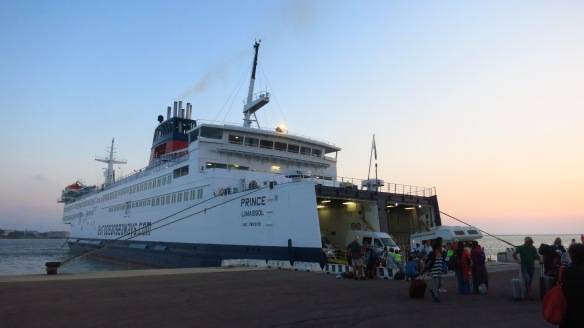 I rode out of the dock, quickly left behind the always ugly area around a port and soon was on the motorway. I was starting the day already tired – had not slept much on the ferry, it was too hot and noisy, so I decided to stop often and take it easy.
I rode out of the dock, quickly left behind the always ugly area around a port and soon was on the motorway. I was starting the day already tired – had not slept much on the ferry, it was too hot and noisy, so I decided to stop often and take it easy.
Compared to the roads and motorways I had used in Greece, this autostrada made Italy look like Switzerland – perfect tarmac, civilised drivers (yes, in the south of Italy), free Wi-Fi in all petrol stations and rest areas… The landscape was not bad either, particularly in the central part of my journey, when the motorway crossed between two natural parks, the Parco Regionale di Monti Picentini and the Parco Nazionale di Cilento Vallo di Diano. From there it went down to Naples, around it and all the way to Rome.
I stopped very often to rest, eat, read a bit of the book I was carrying and at first at least, refuel. But petrol is rather expensive in Italy, so I decided to test how far I could get with one tank on this new motorbike. Theoretically, it should be able to reach 400km, but I had never seen such good fuel consumption figures in real life. I was riding on mostly flat motorway, however, and was in no particular hurry. I was about 380km from the port in Civitavecchia the second time I filled the tank, so I set myself the challenge to refuel next in Barcelona. I filled the tank to the brim and set off for the reminder of the journey trying to apply everything I knew about economy driving. I say ‘driving’ because I learnt that in the car, I have never applied such style to the motorbike…
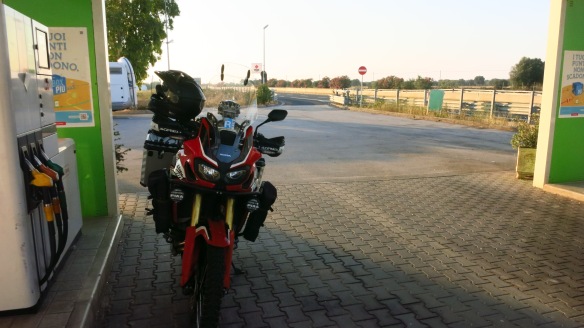 I kept a steady 100km/h, without accelerating hard to overtake slower vehicles, letting the bike coast downhill with very small throttle openings, anticipating other driver’s manoeuvers to avoid braking, etc.
I kept a steady 100km/h, without accelerating hard to overtake slower vehicles, letting the bike coast downhill with very small throttle openings, anticipating other driver’s manoeuvers to avoid braking, etc.
It was boring as hell, but riding on the motorway always is, so going faster or riding more aggressively was not going to make much of a difference. Anyway, at about 19:00 I was just two kilometres away from Civitavecchia when the reserve warning light came on. On normal use this usually happened between 270 and 300km. This time it was at 383km. I had achieved an indicated 4.4l/100km average consumption, and according to the on board computer estimate, I could still go on another 66km, although that number tends to be rather optimistic.
The terminal building in Civitavecchia was much quieter than in Igoumenitsa, there were no queues, the Grimaldi offices were clearly indicated, there were seats everywhere, and there was free Wi-Fi. Well, for the first 15 minute. I got the tickets and waited around for about an hour, when boarding began.
Again, the motorbikes where first to get on board, so I managed to get a good spot with a power socket and settled down to watch a film and spend the night. Tomorrow afternoon I would see Barcelona again.
Home
Day 35 – Thursday 1st September – Barcelona (6,2km)
Barcelona is a relatively small city in extension, its growth limited by two rivers on either side, a range of hills behind and the sea in front, but that is one of the many things that make it such a great place – it has size that makes it friendly to citizens and visitors alike, if you do not mind walking you can get to most places on foot within an hour. The other positive side effect of its size is that, for travellers, is one of the most beautiful cities to approach.
When you fly to other cities your plane usually overflies nondescript fields, industrial areas and satellite towns before landing at an airport several miles away from the city. It is impossible to identify your destination from the air, and you only realise you have reached it after travelling through (usually) grey suburbs. For those cities you reach by boat, the story is similar. Ports are not the greatest sights, and the beauty city you want to visit is behind a long expanse of oil and gas tanks, shipping container yards and railroads.
Barcelona is a completely different story. The approach flight path to its airport is along the coast, right in front of the city, and those who are sitting on the starboard side of the plane are rewarded with one of the best views of the city skyline that makes it easy to spot the most important landmarks they are so eager to visit. Coming from the sea, the experience is similar, and the port for passenger ships is right in the city, so when you drive off you are already practically in the centre, no ugly transition through industrial areas.
I had never arrived in my city by sea, and when the crew announced that we were an hour away from port I got to the top deck to try to spot land and see the approach. It wasn’t long before I saw a faint line of mountains appear over the horizon, and sooner than I thought I was able to identify the unmistakeable silhouette of the mountains of Montserrat a few miles inland.
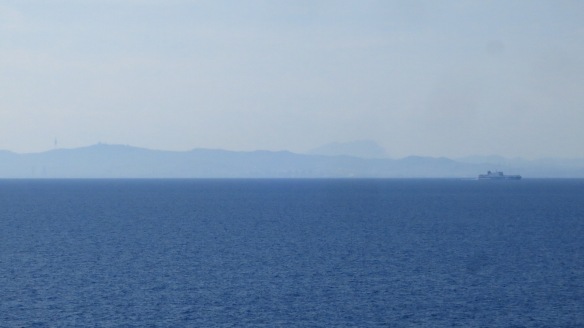 The second thing that became recognisable against the sky was the Collserola television tower, and then the mountain of Montjuïc, the Montseny range in the distance and finally the first tall buildings of Barcelona right by the sea.
The second thing that became recognisable against the sky was the Collserola television tower, and then the mountain of Montjuïc, the Montseny range in the distance and finally the first tall buildings of Barcelona right by the sea.
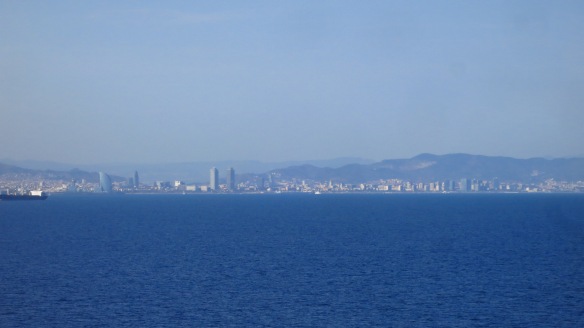 Little by little the buildings became more recognisable, and I saw the Mapfre tower and Arts hotel, the Agbar tower… an Italian kid visiting the city for the first time squealed with excitement when his father pointed at the Sagrada Familia, and much faster than I expected, we were docking at the port terminal.
Little by little the buildings became more recognisable, and I saw the Mapfre tower and Arts hotel, the Agbar tower… an Italian kid visiting the city for the first time squealed with excitement when his father pointed at the Sagrada Familia, and much faster than I expected, we were docking at the port terminal.
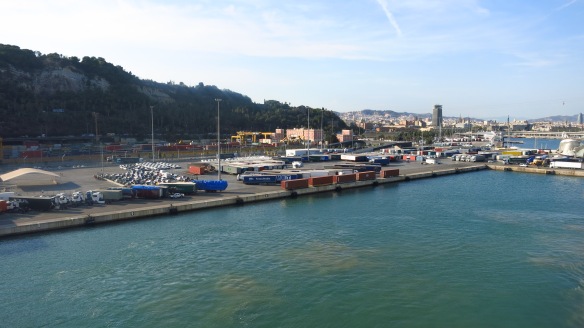 I got the bike off the ferry and rode straight into the afternoon rush hour traffic of the city. After so many kilometres in places where there seem to be no traffic rules, I had to do my best to control myself and not start overtaking cars and riding on the wrong side of the road to get home faster.
I got the bike off the ferry and rode straight into the afternoon rush hour traffic of the city. After so many kilometres in places where there seem to be no traffic rules, I had to do my best to control myself and not start overtaking cars and riding on the wrong side of the road to get home faster.
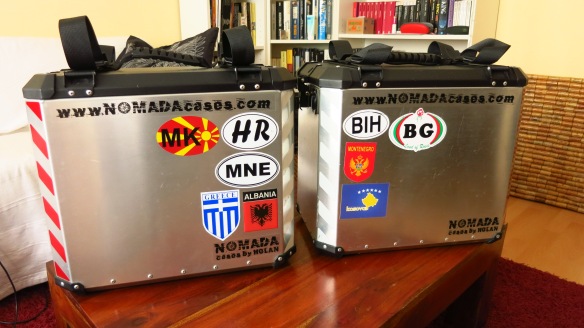 I once saw this little sign on a hostel in Sweden, and as I lay my head on my pillow I thought what a great truth it was.
I once saw this little sign on a hostel in Sweden, and as I lay my head on my pillow I thought what a great truth it was.
Some figures
Here’s the trip in numbers:
- 5,799.7km
- 9 countries
- 35 days (25 days of riding)
- 232km a day on average
- Longest day: 660km
- Shortest day: 6.2km
- About 307 litres of fuel
- 2 new tires fitted two days before starting, Heidenau K60, both still in good condition on the bike
Things that broke:
- Nothing! (it’s a Honda)
- The pump on the Coleman stove stopped working, fixed at Doug’s Motocamp in Bulgaria
- 0 punctures
Things I lost:
- A GoPro camera in Bulgaria, found by a very nice guy who found me and gave it back two days later
Things that got stolen:
- A beer bottle and a beer can from the fridge in a guest house in Dubrovnik

